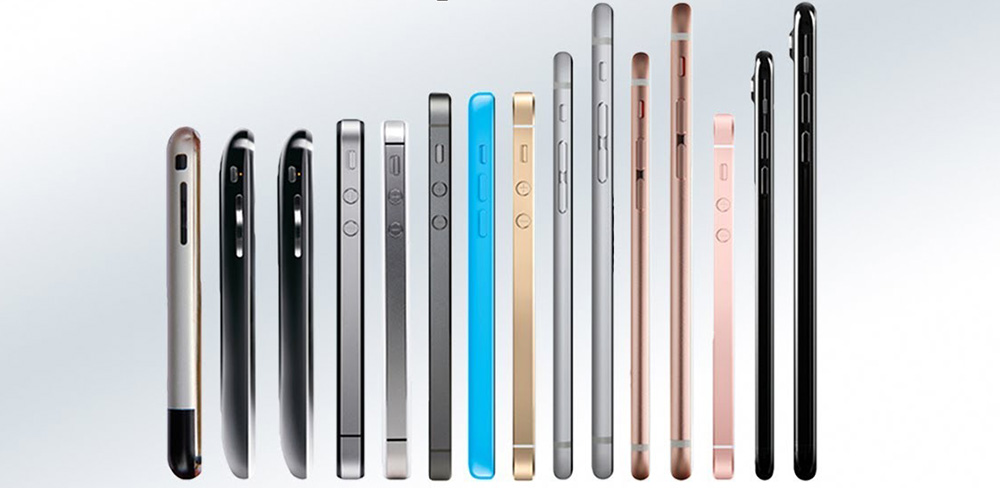Корпорация Apple с момента начала выпуска собственных смартфонов имела четкую стратегию, выгодно отличающую ее от других крупных брендов. Такие компании, как Samsung, LG, HTC и ряд китайских брендов в год создавали по 2-3 модели с разным дизайном, оснащением и ценой, что позволяло обеспечить больший охват потенциальных покупателей.
В Купертино в этом отношении особо не заморачивались и штамповали лишь по одной модели в год с одним цветом и единственным вариантом комплектации. Но через пару лет в Apple начали понимать, что такое отношение к покупателям выглядит негуманно и снизошли до выпуска второго, более дешевого варианта с приставкой SE в названии. В последнее время, правда, с выпуском этой модели что-то не заладилось, а сама компания основной акцент вновь делает на топовые устройства.
После выхода первого iPhone сменилось уже два поколения молодых людей, и новая молодежь знает об этом смартфоне лишь поверхностно. Это и понятно, так как покупают данное устройство в основном для демонстрации своей состоятельности, поскольку марка считается престижной. Предлагаем небольшой экскурс к истокам iPhone, который поможет понять, как эволюционирует компания и ее детище.
1 iPhone
С первым iPhone также началось победное шествие мобильных приложений. Несмотря на то, что пользователям первого поколения iPhone приходилось обходиться предустановленными системными приложениями, через некоторое время появился Apple App Store, который по сей день является источником новых приложений для смартфонов от Apple. Первый iPhone корпорация Apple вывела на рынок в ноябре 2007 года, начав тем самым эпоху смартфонов. Начало было положено — устройство получило 3,5-дюймовый экран и разрешение матрицы 480×320 пикселей.
2 iPhone 3G
Почти год спустя, в июле 2008 появилась первая модель-преемница. Однако ее отличия в дизайне от предшественницы были незначительными: немного легче, задняя панель из пластика вместо алюминия, немного дольше время автономной работы аккумулятора. Одна особенность новой модели, однако, имела важное значение: поддержка более быстрого сетевого стандарта 3G, в то время как оригинальный iPhone не вышел за пределы стандарта Edge.
3 iPhone 3GS
В июне 2009 года вышел iPhone 3GS. Размер остался таким же, зато был установлен новый процессор — Samsung S5L8920. Камера также была доработана: вместо разрешения 2 мегапикселя у iPhone 3GS в распоряжении было 3,1 мегапикселя. Подключение к интернету у новой модели тоже было оптимизировано.
4 iPhone 4
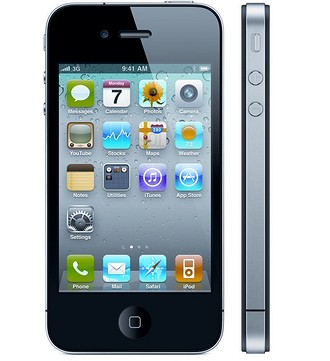
iPhone 4 был первым iPhone с фронтальной камерой, благодаря чему стали возможны такие функции, как FaceTime и селфи.
5 iPhone 4s
Усовершенствованный вариант iPhone 4 появился в октябре 2011 года. Дизайн устройства практически не изменился, но в конструкцию корпуса компания добавила разделительные полоски для улучшения приема радиосигнала. С процессором Apple A5 смартфон был быстрее, а камера имела разрешение 8 мегапикселей. Одним из основных нововведений 4S была интеграция Siri, первого полноценного голосового помощника в мобильном телефоне.
6 iPhone 5
iPhone следующего поколения появился в продаже в сентябре 2012. IPhone 5 был больше, чем все его предшественники, у него впервые был 4-дюймовый дисплей, но при этом он был легче своих старших братьев. Оперативная память удвоилась по сравнению с предыдущими моделями до 1 Гбайт, а процессор Apple A6 был мощнее.
7 iPhone 5c
В сентябре 2013 года Apple выпустила iPhone 5С. Различия с iPhone 5 на самом деле были минимальны: время автономной работы и, следовательно, время телефонных разговоров, а также время работы в режиме ожидания у новой модели было немного больше. Правда, цветовая палитра нового iPhone действительно была доработана: задняя панель iPhone 5C стала цветной, модель стала доступна в белом, розовом, желтом, синем и зеленом цветах.
8 iPhone 5S
Одновременно с iPhone 5C также в продаже появился iPhone 5S. В то время как iPhone 5C вышел только в двух вариантах: с объемом памяти 16 и 32 Гбайт, у iPhone 5S был дополнительный вариант с объемом памяти 64 Гбайт. IPhone 5S был представлен не только в серебристом и сером цвете, но и в золотистом, и был немного легче, чем предыдущая модель. Однако основным отличием был процессор. IPhone 5s был первым среди своих собратьев с двумя чипами: основным процессором A7 с 64-битной архитектурой и «сопроцессором движения M7».
Кроме того, смартфон обладал еще и другими функциями: iPhone 5S был первым смартфоном с датчиком отпечатков пальцев и, следовательно, возможностью разблокировки телефона с помощью биометрии. С тех пор эта функция стала появляться в других устройствах.
9 iPhone 6 / 6 Plus
Сентябрь 2014 года стал еще одной важной вехой в истории iPhone: появились в продаже iPhone 6 и его большой брат iPhone 6 Plus. IPhone 6 был больше, чем модель 5-й серии с дисплеем в 4,7 дюймов. iPhone 6 Plus от Apple обладал дисплеем в 5,5 дюйма, а максимальный объем памяти у обеих моделей был 128 Гбайт. IPhone 6 на сегодняшний день является самым продаваемым iPhone, а за ним следует iPhone XR.
10 iPhone 6S / 6S Plus
Преемник не заставил себя долго ждать: в сентябре 2015 года появился iPhone 6S и более крупный вариант iPhone 6S Plus. Среди нововведений iPhone 6S и iPhone 6S Plus были процессор нового поколения, удвоение оперативной памяти до 2 Гбайт и 12-мегапиксельная камера. В модель 6S также впервые была интегрирована технология 3D Touch. Кроме того, этот смартфон мог похвастаться доработанной и значительно более быстрой версией TouchID, датчика отпечатков пальцев Apple.
11 iPhone SE
IPhone SE, вышедший в марте 2016 года, был промежуточной моделью. Он объединил форм-фактор iPhone 5S, по которому скучали многие покупатели, и техническую начинку iPhone 6S, но по цене был даже дешевле, чем «полноценный» iPhone 6S (Plus). Но производители сэкономили на фронтальной камере, которая значительно уступала камерам предшественника, что было существенным недостатком для пользователей технологии FaceTime. Кроме того, датчик отпечатков пальцев, который в iPhone 6s был уже во второй версии, у SE был в более медленной первой версии.
12 iPhone 7 и 7 Plus
Оба iPhone 7-й серии вышли в сентябре 2016 года. Мощный процессор A10 Fusion сделал iPhone 7 в два раза быстрее предшественника. IPhone 7 Plus, вариант с большим экраном, также был оснащен двойной камерой. По словам Apple, эта комбинация широкоугольного объектива и телеобъектива должна была давать результат, как у зеркальной камеры.
Кроме того, iPhone 7 положил начало тенденции, с которой многие пользователи до сих пор не могут смириться: исчезновение разъема для наушников. Этот iPhone стал первым смартфоном, в котором не нашлось места для классического 3,5-миллиметрового разъема. Тенденция прослеживается и по сей день: современные флагманы тоже выходят без такого разъема.
В варианте Jet Black iPhone 7 также был первой моделью, которая поддерживала беспроводную зарядку по стандарту Qi. Кроме того, iPhone 7 был первой моделью, у которой не было физической кнопки «Home». Вместо этого использовалась технология 3D Touch, которая в сочетании с Taptic Engine имитирует нажатие кнопки.
13 iPhone 8 / iPhone 8 Plus
В сентябре 2017 года в продажу вышли iPhone 8 и iPhone 8 Plus. Дизайн, опять же, не слишком сильно изменился по сравнению с предшественником, но телефон выглядел более качественно с корпусом из стекла и алюминия. IPhone 7 с этой комбинацией материалов можно было приобрести только в цвете Jet Black (черный оникс). Именно из-за этого после выхода новой модели Apple столкнулась с проблемами на рынке.
Новый True Tone Display должен был гарантировать пользователю наилучшее качество изображения. Для этого смартфон постоянно анализирует окружающую среду и настраивает цветопередачу дисплея в соответствии с актуальными условиями освещения. В обоих вариантах iPhone 8 необходимой мощностью телефон обеспечивает процессор A11 Bionic SoC.
IPhone 8 также является первым устройством Apple, которое поддерживает беспроводную зарядку во всех цветовых комбинациях и может заряжаться с помощью зарядных устройств Qi. Популярный красный цвет («Product Red») тоже был впервые представлен именно с iPhone 8 (Plus).
14 iPhone X
IPhone X был впервые представлен публике на том же медиа-ивенте Apple, что и iPhone 8, и iPhone 8 Plus — в сентябре 2017 года. Но в продажу новая модель поступила только в ноябре 2017. На этот раз был существенно доработан дизайн устройства: внешний вид телефона теперь определяли нержавеющая сталь и стекло, а так же так называемый «Super Retina HD Display» от Apple со скругленными углами, которые лучше подходили форме телефона, чем это было у предыдущих моделей.
На передней панели Apple впервые установила дисплей почти без рамок, который напоминает концепты дисплеев самых актуальных на сегодняшний день моделей iPhone: рамок нет, зато вверху дисплея сразу бросается в глаза «челка» (вырез). И здесь iPhone X опять стал основоположником новой тенденции, которой следуют многие производители смартфонов, украшающие дисплеи своих новых моделей разными формами выреза.
Но, надо заметить, появление такой «челки» имеет свою причину: iPhone X — первый смартфон, который можно разблокировать с помощью технологии Face ID, использующей 3D-модель вашего лица. Для этого предусмотрены соответствующие инфракрасные датчики и камеры. Разблокировка с помощью Face ID оказалась намного более безопасной по сравнению с распространенным на тот момент распознанием 2D.
Благодаря системе Face ID впервые стали возможны такие функции, как Emojis, а затем Memojis. К еще одному нововведению пользователям пришлось некоторое время привыкать: из-за нового типа дисплея на передней панели устройства вообще не осталось места для привычной кнопки «Home» Вместо нее, начиная с iPhone X, во всех новых телефонах Apple используется управление жестами. Кроме того, iPhone X, как и iPhone 8, работает на процессоре A11-Bionic-SoC, который обеспечивает необходимую производительность. Еще одно нововведение — пять предустановленных эффектов для получения красивых портретных снимков с помощью основной и фронтальной камер.
15 iPhone XS / iPhone XS Max
На ежегодной презентации Apple 12 сентября 2018 года были представлены три новых модели iPhone. Двумя из них были iPhone XS и iPhone XS Max. Оба устройства схожи по дизайну с iPhone X, но Apple впервые продемонстрировала телефон в новом размере с диагональю экрана более 6 дюймов (модель Max).
Оба телефона оснащены одним и тем же процессором Apple A12 Bionic. Смартфоны отличаются, прежде всего, дисплеями: в обеих моделях Apple делает ставку на OLED-экраны размером 5,8 дюйма на XS (6,5 дюйма на XS Max). Кроме того, у модели Max выше разрешение. Устройства XS также поддерживают две SIM-карты — физическую nano-SIM и eSIM.
16 iPhone XR
IPhone XR был «тайной звездой шоу» от Apple. Он оснащен всеми техническими новинками (за небольшим исключением), при этом цена у него довольно привлекательная. 6,1-дюймовый экран по размеру в рейтинге находится примерно между дисплеями XS и XS Max. Правда, Apple сделала ставку не на OLED-дисплей, а на технологию LCD. Многие пользователи были разочарованы низким разрешением дисплея, которое примерно дотягивает до HD. Для смартфона Apple 2018 года это уже было не современно. В то время как процессор новой модели похож на процессор серии XS, XR приходится довольствоваться памятью на целый гигабайт меньше. Кроме того, основная память оказалась не такой конфигурируемой, как у моделей XS.
На задней панели у моделей серии XR нет второго объектива камеры, который на iPhone XS (Max) обеспечивает зум без потери качества. Края дисплея у этой модели немного шире, но в распоряжении пользователя здесь тоже есть управление жестами. iPhone XR дал возможность покупателям приобрести телефон от Apple в современном дизайне за меньшие деньги. Но в любом случае, розничная цена новой модели была очень высокой, не ниже, чем у других флагманов 2018 года.
17 iPhone Pro 11 / iPhone 11 Pro Max
10 сентября 2019 года Apple представила на презентации новое поколение iPhone. Двумя его представителями стали iPhone 11 Pro, а также iPhone 11 Pro Max. Начиная с 20 сентября новые модели iPhone вышли в продажу. Размер дисплея составляет 5,8 дюйма (iPhone 11 Pro) и 6,5 дюйма (iPhone 11 Pro Max). В моделях Pro и Pro Max, помимо 12-мегапиксельной основной камеры и 12-мегапиксельной камеры с телеобъективом, используется 12-мегапиксельная ультра-широкоугольная камера. С новым ночным режимом, даже при съемке в темноте должны получаться хорошие фотографии.
О камерах на задней панели смартфона покупатели спорят и по сей день: их расположение определенно напоминает спинер. Внутри iPhone работает процессор A13 Bionic, это уже следующее поколение процессоров, после тех, что были у iPhone XR и XS. Начиная с одиннадцатого поколения больше нет технологии 3D Touch. Для моделей Pro одиннадцатого поколения iPhone Apple впервые использует в качестве материала задней панели матовое стекло, благодаря чему телефоны производят гораздо более благородное впечатление.
18 iPhone 11
Вместе с новыми моделями Pro Apple представила iPhone 11 как прямого преемника iPhone XR. IPhone 11 доступен в шести цветах на выбор: белом, фиолетовом, зеленом, желтом, черном и красном (Product Red). Дисплей iPhone 11 вновь имеет размер 6,1 дюйма, в остальном дизайн тоже почти ничем не отличается по сравнению с прямым предшественником. Только логотип Apple на задней панели, в соответствии с новой дизайнерской политикой компании, переместился в центр.
IPhone 11 имеет две камеры на задней панели, каждая — на 12 мегапикселей. К основной камере, как у iPhone XR, добавлена еще одна ультра-широкоугольная. Однако покупателям пришлось отказаться от теле-зума. С точки зрения технической начинки устройство похоже на своих старших братьев. Его цена даже несколько ниже, чем у предшественника XR, но по-прежнему назвать ее доступной язык не повернется. Телефон снова доступен в нескольких цветовых исполнениях. Но вот матовым стеклом на задней панели IPhone 11 похвастаться не может.
19 iPhone SE 2020
15 апреля 2020 года Apple порадовала своих поклонников презентаций второго поколения относительно недорогого смартфона iPhone SE. Он появился через целых четыре года после выхода первого поколения и внешне почти не отличается от iPhone 8, при этом предлагая куда более производительную начинку.
В основу iPhone SE 2020 легла фирменная однокристальная система Apple A13, отвечающая за производительность смартфонов линейки iPhone 11. Он получил небольшой 4,7-дюймовый дисплей, только одну заднюю камеру с разрешением 12 Мп и домашнюю кнопку под экраном со встроенным в нее сканером отпечатков пальцев Touch ID.
20 iPhone 12 Pro и iPhone 12 Pro Max
Следующее поколение iPhone дебютировало 14 октября 2020 года. Самыми продвинутыми представителями линейки стали модели iPhone 12 Pro и iPhone 12 Pro Max. Оба гаджета отличаются от предшественников более крупными дисплеями: 6,1 дюйма у первого и 6,7 дюйма у второго. При этом физические размеры смартфонов почти не изменились, все благодаря уменьшившимся рамкам. Обновилась и однокристальная система обеих моделей. В них используется 5-нм Apple A14 Bionic с явным акцентом на ИИ и машинное обучение.
Но самое интересное в том, что iPhone 12 Pro и iPhone 12 Pro Max теперь отличаются не только диагональю экрана, как это было у предшественников. iPhone 12 Pro Max получил более мощный набор камер с 5-кратным оптическим зумом, оптической стабилизацией со сдвигом матрицы и лидаром. iPhone 12 Pro пришлось довольствоваться только 4-кратным зумом и лидаром. Правда, понятия 5- и 4-кратный здесь довольно условны — они описывают весь диапазон масштабирования системы камер. Оптическое увеличение девайсов — только 2,5х и 2х.
Оба смартфона обзавелись магнитной зарядкой MagSafe и получили сильно урезанный комплект поставки, в который больше не входят не только наушники, но и банальный адаптер питания. В компании объяснили это заботой об окружающей среде.
21 iPhone 12 и iPhone 12 Mini
Вместе с iPhone 12 Pro и iPhone 12 Pro Max компания из Купертино представила и более доступный смартфон iPhone 12. Смартфон выполнен из стекла с новым покрытием Ceramic Shield. А его главным отличием от предшественника стал 6,1-дюймовый дисплей с почти вдвое более высоким разрешением, чем у предшественника. Но еще важнее оказался давно напрашивавшийся переход Apple от IPS-панелей к более качественным OLED-матрицам.
Как и топовые представители линейки, iPhone 12 обзавелся фирменной однокристальной системой Apple A14 Bionic. Что до камер, то они практически не изменились. Здесь все также используется двойная тыльная камера, отличающаяся от iPhone 11, разве что, чуть большей светосилой.
На презентации Apple было уделено совсем мало внимания новому iPhone 12 Mini. Это и неудивительно, ведь он отличается от iPhone 12 лишь более компактным 5,4-дюймовым OLED-дисплеем и соответственно уменьшившимися габаритами.
22 iPhone 13 Pro и iPhone 13 Pro Max
14 сентября 2021 года Apple показала новые смартфоны iPhone 13 Pro и iPhone 13 Pro Max. Купертиновцы отметили сразу несколько ключевых особенностей этих гаджетов, но главной из них стала наконец-то увеличившаяся до 120 Гц частота обновления экранов. В обоих смартфонах используется более светосильная оптика, позволяющая захватывать на 92% больше света и, как следствие, заметно увеличивающая качество съемки в темноте.
Сами камеры получили поддержку видео в формате ProRes, а телевик обзавелся полноценным 3-кратным оптическим увеличением. Диапазон масштабирования вырос до 6х. За производительность смартфонов отвечает чипсет Apple A15 Bionic, а их максимальный объем встроенной памяти увеличился до 1 Тбайт. Автономность iPhone 13 Pro Max выросла на 2,5 часа, а iPhone 13 Pro — на 1,5 часа по сравнению с предшественниками.
23 iPhone 13 и iPhone 13 Mini
Такой же чипсет используют и представленные вместе с флагманами смартфоны iPhone 13 и iPhone 13 Mini. Что до их остальных характеристик, то здесь все намного скромнее. Частота обновления экранов смартфонов осталась на прежнем уровне 60 Гц. Разрешение камер устройств не изменилось, но светочувствительность их широкоугольных камер выросла на 47% за счет более крупной матрицы, а для более высокого качества съемки у смартфонов появилась оптическая стабилизация со сдвигом матрицы.
Интересной деталью презентации стало то, что Apple отказалась от сравнения Apple A15 Bionic с предыдущим поколением SoC, вместо этого противопоставив ей неких абстрактных «конкурентов» из лагеря Android. А это невольно наталкивает на мысли, что прирост производительности платформы по сравнению с Apple A14 уже не выглядит настолько впечатляющим. Что до автономности, то у iPhone 13 она выросла на 2,5 часа, а у iPhone 13 Mini — на 1,5 часа.
24 iPhone 14 и iPhone 14 Plus
Представленные 7 сентября 2022 года смартфоны iPhone 14 и iPhone 14 Plus оказались для поклонников Apple настоящим сюрпризом. Но не сказать, чтобы сюрпризом приятным. Оба гаджета не только практически не отличаются внешне от iPhone предыдущего поколения, но и построены на прошлогодней однокристальной платформе Apple A15 Bionic. Результат оказался закономерен — за первые три дня Apple удалось продать на 11% меньше iPhone 14 по сравнению с предшественником. Ну а многочисленные аналитики отметили, что такое двузначное падение спроса между поколениями iPhone встречается крайне редко.
Впрочем, сказать, что iPhone 14 и iPhone 14 Plus не принесли с собой ничего нового, все-таки неправильно. В 2022 году Apple отказалась от развития компактной серии iPhone mini, а на ее место пришла линейка iPhone Plus — впервые за несколько лет более крупный смартфон появился не в рамках Pro-серии. Ну а в итоге у пользователей появился выбор между миниатюрным 6,1-дюймовым OLED-экраном iPhone 14 и крупным 6,7-дюймовым дисплеем iPhone 14 Plus.
К тому же, купертиновцы обновили камеры гаджетов. Теперь в них используется новый 12-Мп сенсор с огромными 1,9-мкм пикселями, оптикой с апертурой f/1,5 и оптической стабилизацией. Обновилась и фронтальная камера TrueDepth. Она использует 12-Мп датчик и оптику с диафрагмой f/1.9. Ну а в Apple привычно говорят о заметно более высоком качестве съемки обоих камер. Главным же новшеством этого поколения iPhone стало появление в них двухсторонней спутниковой связи, которая может использоваться для связи с экстренными службами. Правда, работает эта «фишка» пока только в США и Канаде.
25 iPhone 14 Pro и iPhone 14 Pro Max
Насколько невыразительными получились iPhone 14 и iPhone 14 Plus, настолько же интересным оказались iPhone 14 Pro и iPhone 14 Pro Max. Ну а главным новшеством гаджетов стал способный менять размеры островок Dynamic Island, заменивший массивную челку у всех предыдущих моделей смартфонов купертиновцев. По сути, это два отверстия в экране под селфи-камеру и Face ID, визуально объединенные с помощью отключаемых пикселей дисплея. Причем функций у этого островка оказалось совсем немало и далеко не все из них декоративные.
Помимо этого оба смартфона построены на новейшем чипсете Apple A16 Bionic. Они оснащаются совершенно новыми OLED-дисплеями с диагональю 6,1 и 6,7 дюймов соответственно и яркостью до 1600 нит в режиме HDR при пиковой яркости 2000 нит, тогда как возможности предшественников были ограничены «скромными» 1200 нит. Разрешение основной камеры гаджетов выросло до 48 Мп, обновилась и их широкоугольная камера, а вот телевик остался без прежним.
Читайте также:
- Тестируем iPhone 11: супер мощь и HD дисплей
- Обзор iPhone 13: новые камеры и быстрая зарядка
Вы знаете, как начиналось развитие смартфонов от Apple, и какими были первые телефоны корпорации? Из этой статьи вы узнаете все модели iPhone по порядку и получите полную картину эволюции смартфонов от Apple.
12. Смартфоны от Apple 2017 года
1. Первый телефон от Apple (2007)
История смартфонов Apple началась 9 января 2007 года, когда Стив Джобс впервые продемонстрировал миру iPhone, который перевернул весь мир. До 2007 года телефоны были большие, большую часть корпуса занимала клавиатура, управление осуществлялось с помощью джойстика. Позже появились устройства с сенсорным экраном, но без стилуса управлять ими было невозможно.
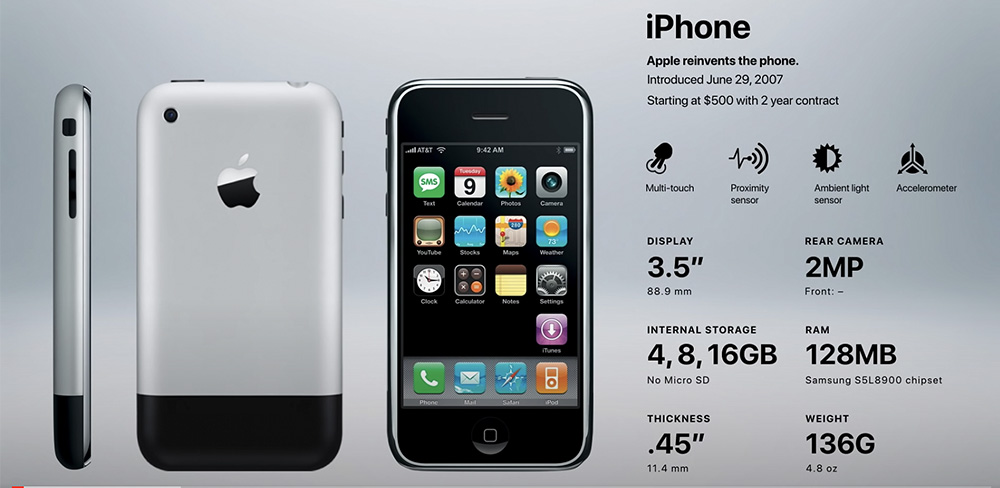
Стив Джобс знал, что управление стилусом не очень удобное, раньше они часто терялись. Поэтому он представил первый в мире смартфон с Multi-touch экраном, которым можно было управлять с помощью пальцев. Именно такое управление побуждало пользователей к покупке. Кстати, буква «i» в названии девайса, обозначала вдохновение. Экран был с диагональю 3,5 дюйма, что на тот момент было отличным показателем. У этой версии смартфона была основная камера на 2 МП, но не было возможности снимать видео, также отсутствовала фронтальная камера. Для 2007 года первая версия телефона от Apple была прорывом.
2. iPhone 3G (2008)
29 июня 2008 года был представлен следующий айфон — 3G. Она стала официально продаваться в России. Разбирая все версии по порядку, можно сказать, что эта версия стала популярнее первой из-за поддержки сетей 3G.
Особенности:
- Глянцевая пластиковая крышка.
- Поддержка 3G.
- Память: 8 ГБ или 16 ГБ.
- Появился App Store.
- Цвет: чёрный.
- Появился датчик GPS.
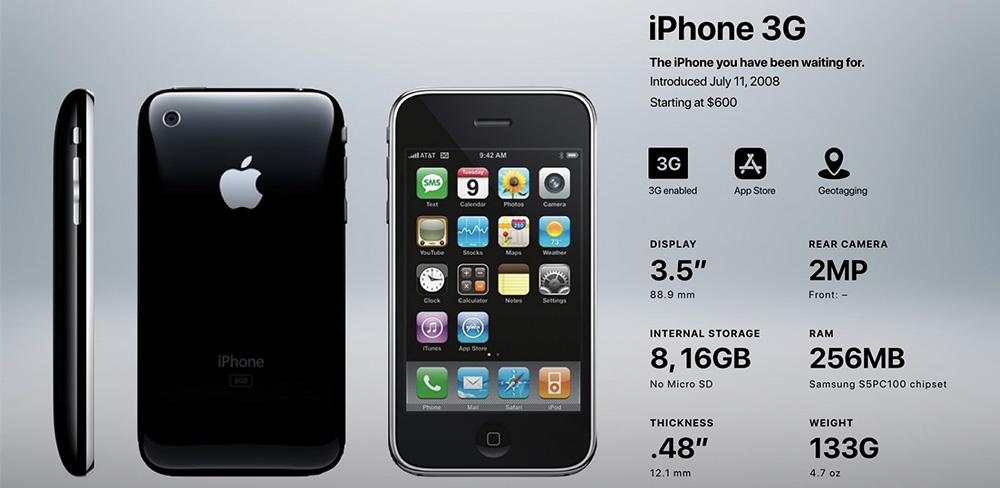
3. Версия 3Gs (2009)
Следующий смартфон по порядку — 3Gs. Буква «s» обозначала скорость. Эта версия телефона была оснащена камерой на 3 МП и получила возможность съёмки видео. Так как видео занимает больше места в хранилище смартфона, появилась версия с 32 ГБ памяти.
Другие особенности:
- Съёмка видео.
- Улучшенная защита данных.
- Встроенный GPS-приёмник.
- Появилась возможность копировать и вставлять текст.
- Появился iTunes.
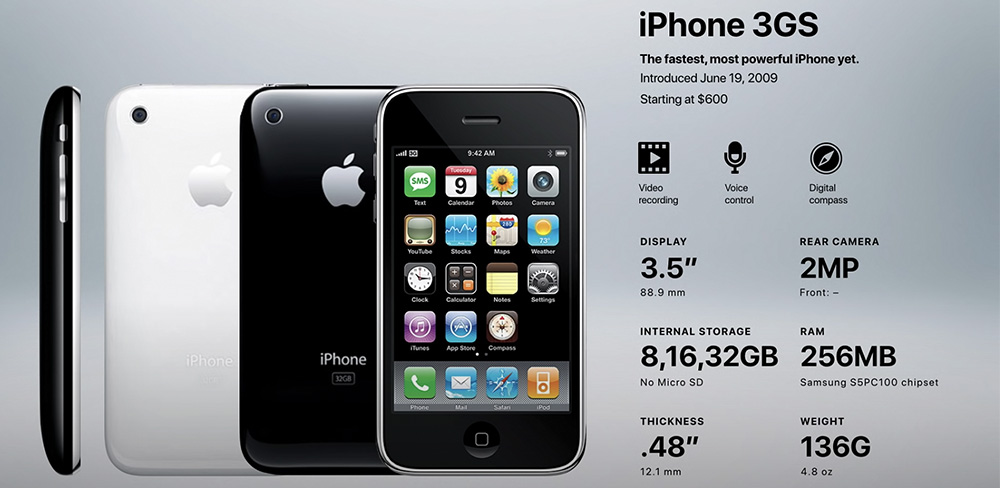
Данный смартфон отличался своей скоростью и работоспособностью, поэтому быстро заинтересовал многих пользователей.
4. iPhone 4 (2010)
Продолжая разбирать модели iPhone по порядку, переходим в июнь 2010 года, когда мир увидел новый смартфон Apple, который совершил очередную эволюцию. Это был айфон 4, который изменил очень многое. Кстати, он до сих пор работает и его используют люди. В этой версии Apple впервые использовала процессор собственного производства. Прошлые модели были оснащены процессорами от Samsung.
Особенности:
- Полностью стеклянный корпус.
- Retina-дисплей.
- Камера: 5 МП.
- Появилась первая фронтальная камера на 0,3 МП.
- ОС стала называться iOS впервые у этой модели.
- В смартфоне используется Micro-sim.
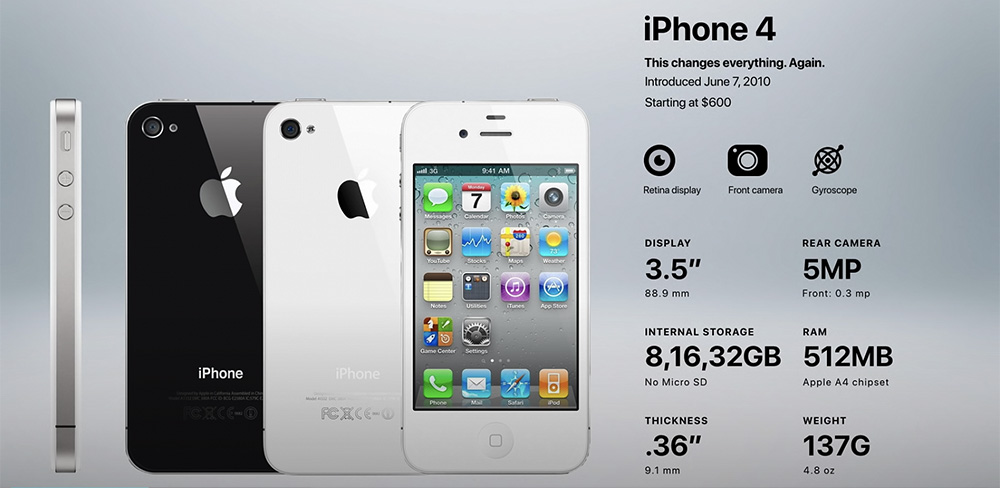
Проводя сравнение iPhone, можно точно сказать, что 4-ка принесла с собой много нововведений, которые в дальнейшем только усовершенствовались. Также в 2010 году Apple 4 занял первое место по продажам среди всех телефонов того времени. Это был последний смартфон, который Стив Джобс представил при жизни. В 2011 году презентовать технику компании стал Тим Кук.
5. iPhone 4s (2011)
4 октября 2011 года на презентации Apple была представлена версия 4s. При сравнение этой модели с 3, тут «s» обозначала уже не скорость, а наличие Siri. Называя все модели по порядку, именно с 4s началось развитие голосового помощника.
Особенности:
- Голосовое управление.
- Основная камера: 8 МП.
- Процессор А5.
- Появилась память на 64 ГБ.
- Цена на этот смартфон стартовала от 200$.
- Этот айфон мог снимать видео в формате FullHD.
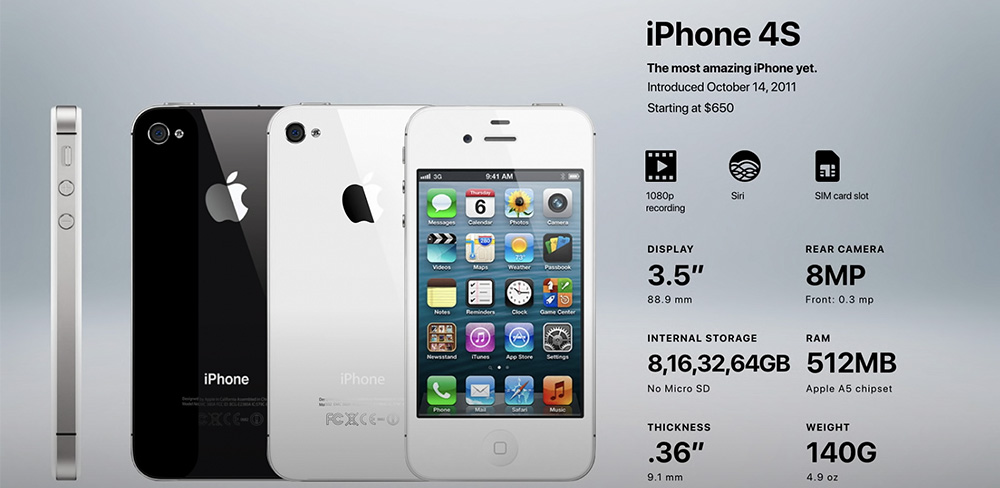
На следующий день после презентации этого устройства Стив Джобс покинул этот мир, но оставил после себя много наработок и компанию, которая продолжает радовать мир новыми гаджетами. Начиная с модели 4s презентации компании стали проходить осенью.
6. iPhone 5 (2012)
Продолжая разбирать версии устройств по порядку, поговорим о модели, которая также всем приятно запомнилась. Она уже отличалась по дизайну, если сравнивать её с 4-ой. Речь идёт об айфоне 5, который появился 11 сентября 2012 года. Это устройство получило дисплей с диагональю 4″ и удлинённый корпус. Изначально пользователям такой дизайн не понравился, гаджет даже сравнивали с пультом от телевизора, но несмотря на это данная версия обрела популярность.
Параметры:
- Экран 4″.
- Поддержка LTE.
- Новый разъём Lightning.
- 1 ГБ ОЗУ.
- Процессор A
- Появление Nano-sim.
- Корпус стал алюминиевый.
- Цвета: серебристый и чёрный.
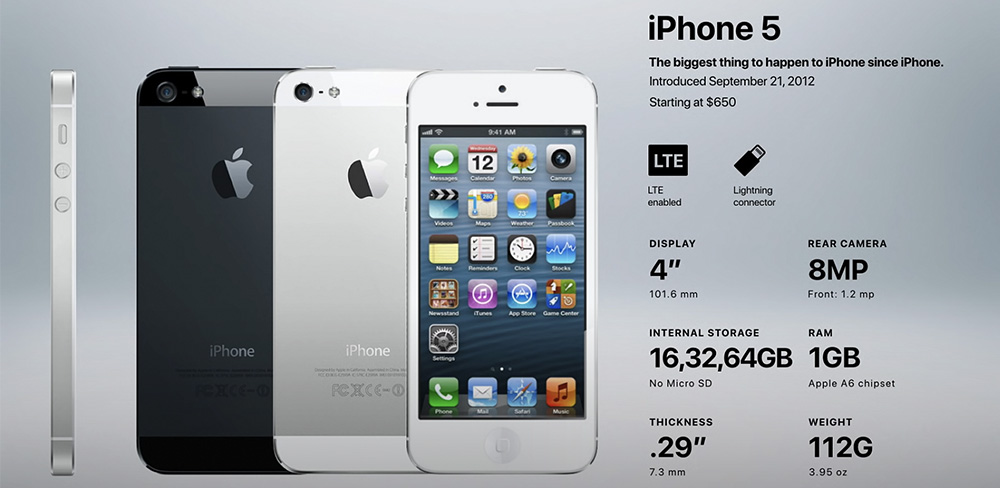
Если вы выбираете кабель для своего смартфона, то посмотрите на мощные провода различных производителей на сайте.
7. iPhone 5s (2013)
Проводя сравнение iPhone по порядку, переходим к презентации 2013 года, на которой был представлен айфон 5s. Он визуально был похож на 5 версию. В этот девайс было включено множество доработок, появился цвет боковых граней «серый космос», а главной его фишкой стало наличие Touch ID. Этот новый способ разблокировки позволил сохранять данные пользователя в безопасности.
Параметры:
- Фронтальная камера: 1,2 МП.
- Замедленное видео.
- Процессор A5 с сопроцессором М7.
- Память: 16 ГБ, 32 ГБ и 64 ГБ.
- Добавился золотой цвет корпуса.
Приставка «s» в этой версии обозначала безопасность.
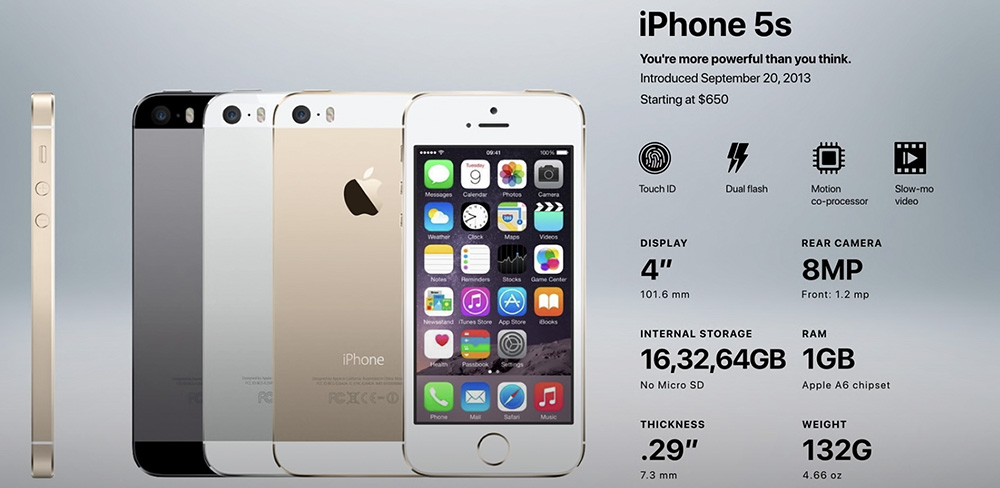
На этой же презентации, помимо модели 5s, была представлена версия 5C в ярких цветах корпуса. Большой популярности они не получили, хотя были прочными и держали заряд даже дольше, если провести сравнение с 5s.
8. iPhone 6 (2014)
Уже в 2014 году мир переходил на смартфоны с большей диагональю дисплея. Apple, последовав трендам, на своей презентации 19 сентября 2014 года представила 2 модели айфон: 6 и 6 Plus. С диагоналями 4,7″ и 5,5″. Сравнивая эти гаджеты, можно отметить, что помимо размеров экрана, Plus-версия имела оптическую стабилизацию, которой не было у iPhone 6. Проводя сравнение моделей смартфонов, стоит отметить, что по основным параметрам 6 версии не отличались от 5s. Их отличал лишь дизайн и размеры экрана. Также у айфон 6 была доступна конфигурация с объёмом памяти на 128 ГБ за 399$. Большой размер экрана понравился пользователям, ведь на нём было удобно смотреть видео, но корпус устройства был не прочным и люди часто гнули его, случайно садясь на телефон.
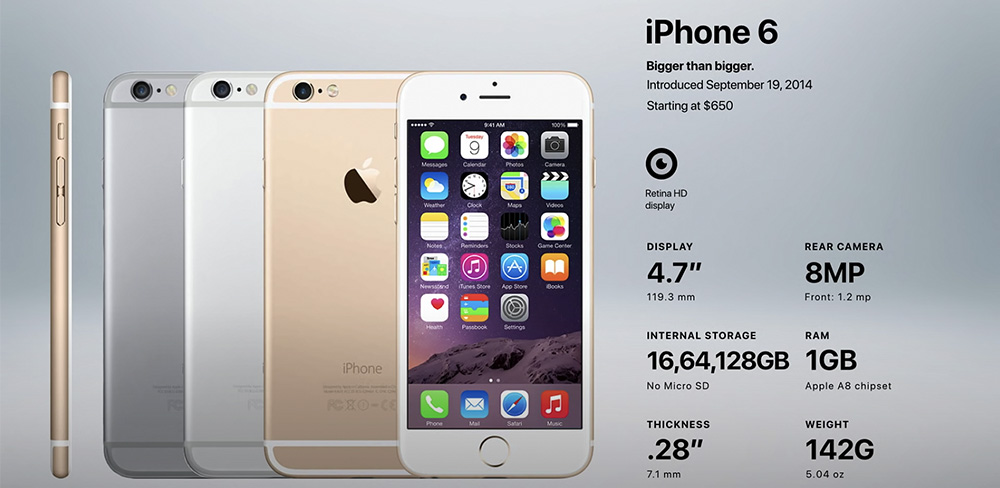
9. Версии 6s и 6s Plus (2015)
Следующими по порядку 9 сентября 2015 года стали новые модели 6s и 6s Plus, которые имели уже более прочный корпус. Дизайн их не отличался от прошлых версий, но нововведения были.
Особенности:
- Появление 3D Touch.
- Основная камера: 12 МП.
- Фронтальная камера: 5 МП.
- ОЗУ 2 ГБ.
- Новый цвет корпуса: «розовое золото».
- Технология «живые фото».
- Улучшен Touch ID.
- Съёмка в 4К.
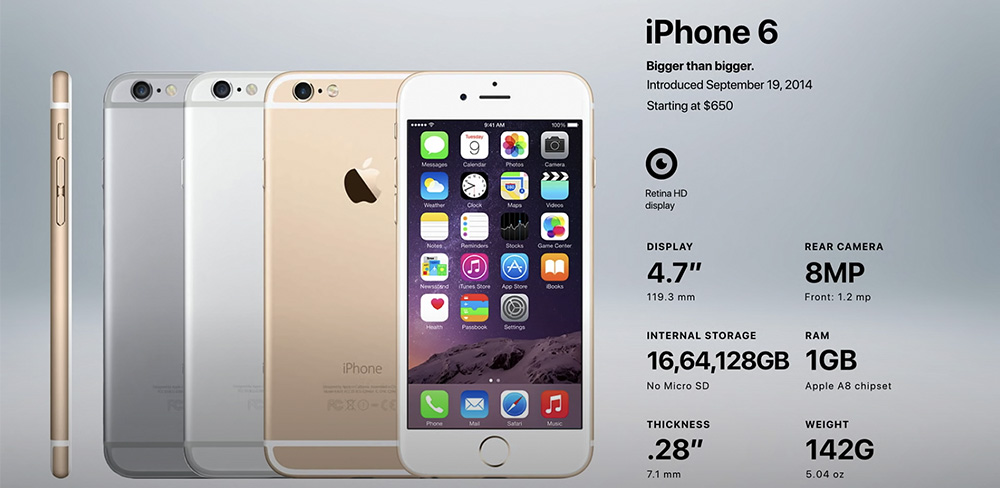
10. Версия SE (2016)
Следующий iPhone по порядку был SE. Он вышел в марте 2016 года. Этот смартфон был выпущен специально для любителей 5 модели. «Начинка» этого айфон была взята от 6s, а дизайн полностью повторял 5-ку. Проводя сравнение SE с 5s, можно отменить, что новинка стала мощнее.
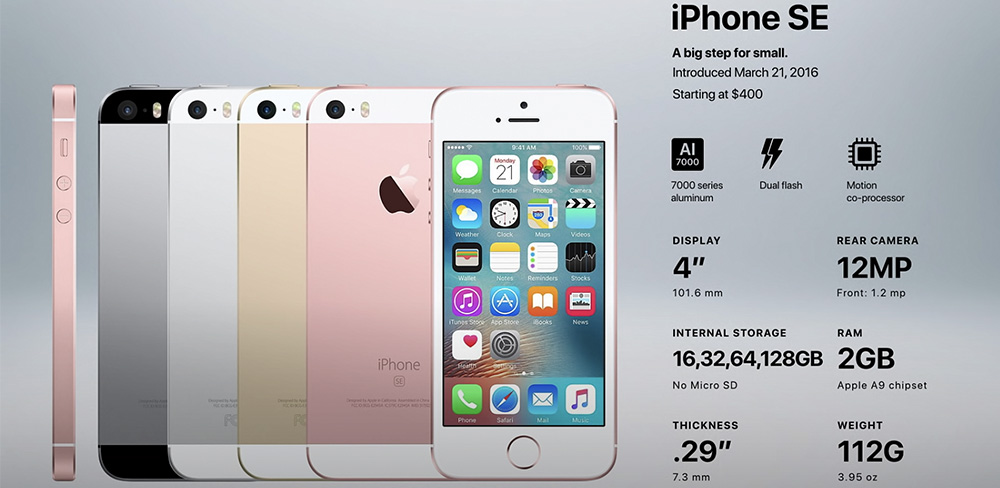
Оставьте заявку в чате мессенджера в 3 клика и получите предложения дефицитных SE в отличном и хорошем состоянии, которые обменяли по программе Trade-in
11. iPhone 7 и 7 Plus (2016)
Также в 2016 году, но уже в сентябре, Apple презентовали версии 7 и 7 Plus. Эта модель до сих пор актуальна и многие люди пользуются ей. В этом девайсе была улучшена влагозащита, кнопка «Home» стала сенсорной, каждое нажатие на кнопку давало обратный отклик. В этом смартфоне появился стереозвук.
Параметры:
- Фронтальная камера: 7 МП.
- Отсутствие разъёма AUX.
- Память: 32 ГБ, 128 ГБ, 256 ГБ.
- У модели 7 Plus, помимо увеличенного дисплея, есть вторая основная камера.
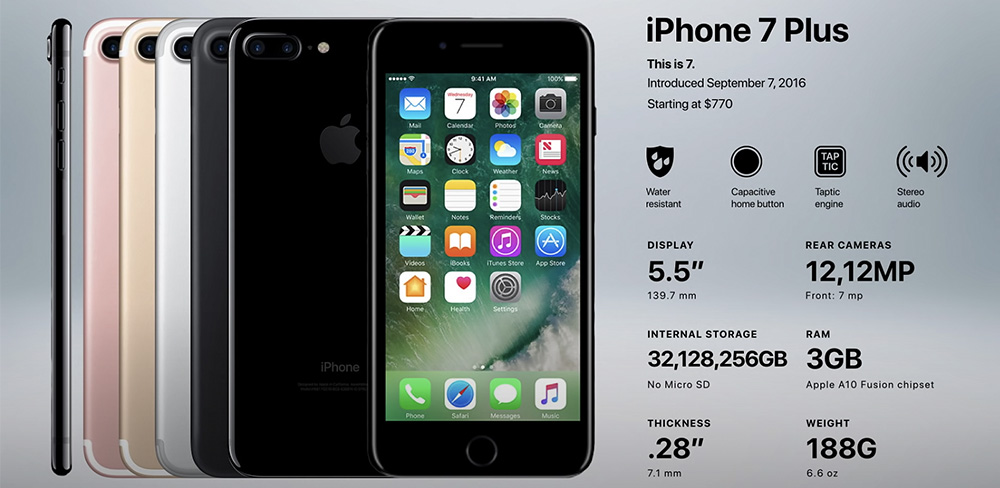
12. Смартфоны от Apple 2017 года
Продолжая сравнивать все модели iPhone по порядку, переходим к iPhone 8 и 8 Plus, которые были презентованы 12 сентября 2017 года. В сравнении с 7-ой, дизайн гаджетов особо не отличался. Устройства получили технологию True Tone и поддержку беспроводной зарядки.
Параметры:
- Дисплеи: 4,7″ и 5,5″.
- Память: 64 ГБ и 256 ГБ.
- Большая модель также была оснащена второй камерой, но снимала она лучше 7-ой модели.
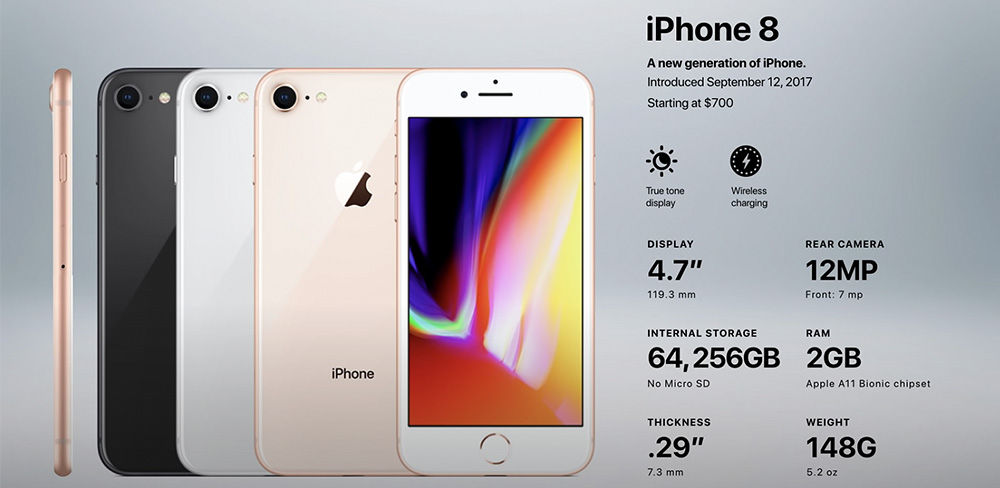
Также на презентации 12 сентября 2017 года Apple вновь произвела революцию, продемонстрировав миру флагман iPhone X. Это устройство покорило пользователей своим безрамочным экраном и технологией Face ID.
Параметры:
- Экран: 5,8″.
- Разблокировка лицом.
- Цвета: «серый космос» и серебристый.
- Камера: 12 МП.
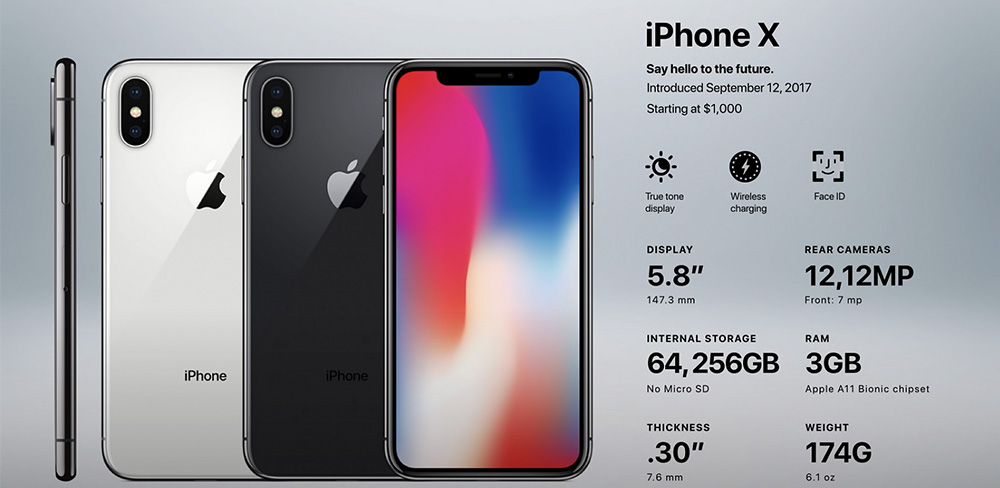
13. Появление моделей Xs, Xs Max и XR (2018)
Проводя сравнение iPhone по порядку, переходим к презентации 2018 года, на которой были представлены 3 новые версии: Xs, Xs Max и XR. Большой популярности достигла модель Xs Max. Этот девайс имел диагональ экрана 6,5″ и это был первый такой большой безрамочный дисплей.
Особенности Xs и Xs Max:
- OLED-дисплей Super Retina.
- 2 камеры.
- По функционалу и характеристикам 2 версии абсолютно одинаковые, их отличает только диагональ дисплея.
- Новый цвет корпуса «золотой».
- Появилась версия с хранилищем на 512 ГБ.
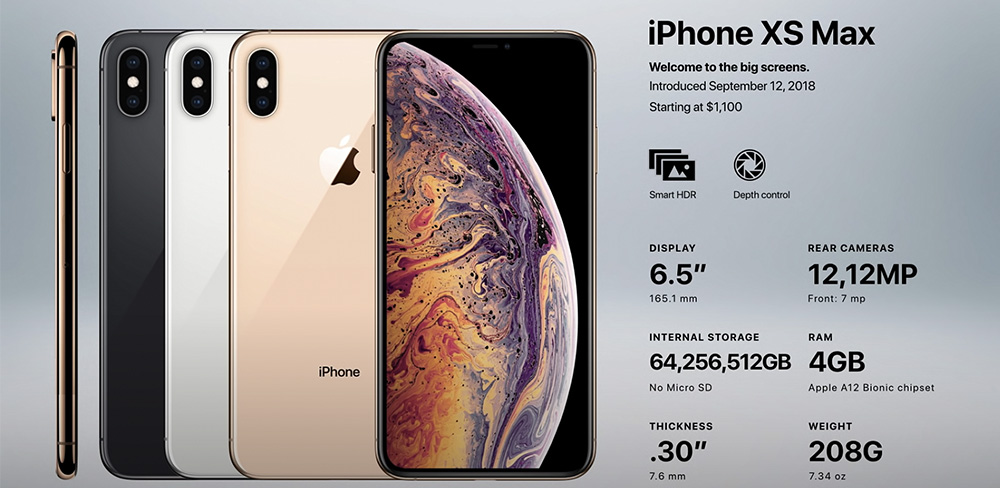
Гаджет XR:
- Экран: 6,1″,
- LCD.
- яркие цвета корпуса.
- Одна камера.
- Процессор A12 Bionic.
- Память: 64 ГБ, 128 ГБ, 256 ГБ.

Айфон XR был самым популярным флагманом от Apple в 2018 году.
14. iPhone 11, 11 Pro и 11 Pro Max (2019)
В 2019 году корпорация представляет флагманы с ещё большим процессором — это 11, 11 Pro и 11 Pro Max. Они работаю быстрее и делают кадры намного качественнее из-за того, что обрабатывают кадры сразу во время съёмки. Подробнее про камеры этих флагманов вы можете узнать в статье блога.
Особенности:
- Процессор: A13 Bionic.
- Появление ультраширокоугольной камеры.
- Ночной режим.
- Размеры корпуса соответствуют прошлым версиям флагманов.
- Экран Super Retina HDR.
- Технология Dolby Atmos.
- Фронтальная камера: 12 МП.
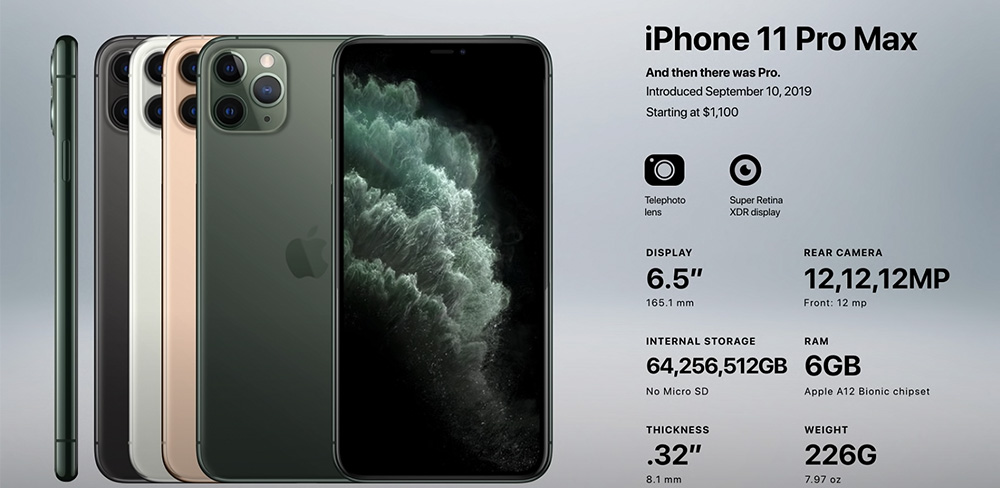
Для моделей 11 Pro и 11 Pro Max нет отличий в функционале, разница лишь в диагонали дисплея и ёмкости батареи. Проводя сравнение новых моделей, стоит отметить, что у модели 11 отсутствует 3-я телекамера с 2-х кратным увеличением, но его можно компенсировать цифровым. Стоимость версии 11 ниже ещё из-за алюминиевого корпуса, у премиальных моделей он изготовлен из стали.
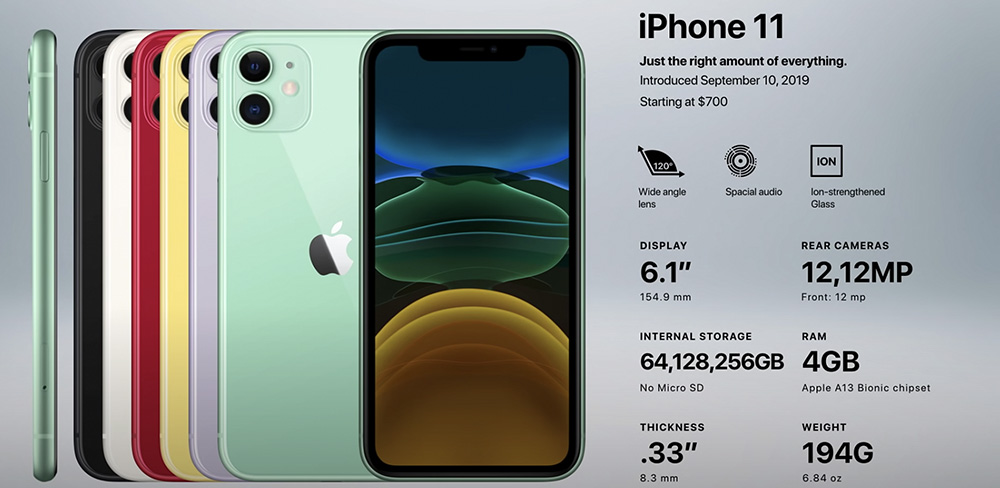
15. iPhone 12, Mini, 12 Pro и Pro Max (2020)
2020 год порадовал фанатов яблочной продукции айфонами 12 модели. Они получили обновлённый дизайн и цвета корпуса. Всего в линейке 4 флагмана: 12, 12 Mini, Pro и Pro Max.
- Две бюджетные версии (12 и Mini) отличаются лишь размерами экрана, остальные характеристики и цвета у смартфонов идентичные. Флагманы доступны в таких цветах: синем, красном, зелёном, белом, чёрном. Айфон 12 Mini получил дисплей Super Retina XDR с диагональю 5,4 дюйма, а iPhone 12 — 6,1 дюйма.
- Модели оснащены сверхширокоугольным и широкоугольным объективами. Версии с приставкой Pro получили дополнительный телефотообъектив и датчик LiDAR.
- Диапазон оптического зума у бюджетный версий 2x, у 12 Pro — 4х, а у 12 Pro Max — 5х.
- Вся 12 линейка айфонов работает на процессоре A14 Bionic.
- В отличие от предыдущих флагманов, 12 линейка стала прочнее, благодаря покрытию Ceramic Shield.
- Все 12 смартфоны поддерживают MagSafe.
- Все камеры устройств поддерживают ночной режим. Pro-версии получили в дополнение поддержку ночного режима для портретов.
- Профессиональные модели доступны в таких цветах: «тихоокеанский синий», золотой, графитовый, серебристый.
- Айфон 12 Pro получил 6,1″ экран, а Pro Max — 6,7″.
- Также вся линейка поддерживает стандарт 5G.
- В этот раз модель Pro Max отличается не только размером от 12 Pro, но и дополнительными возможностями. Например, съёмка видео будет лучше, благодаря оптической стабилизации изображения сдвигом матрицы.
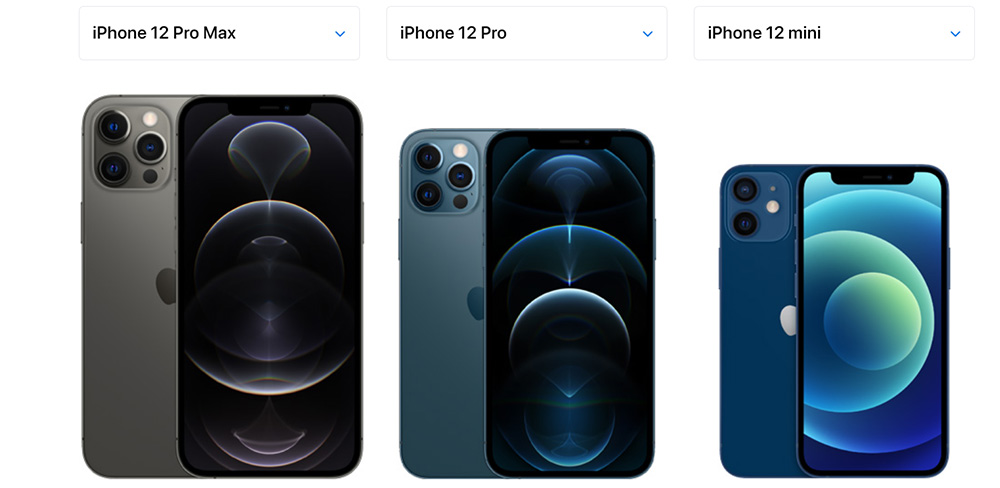
16. iPhone 13, Mini, 13 Pro и Pro Max (2021)
В 2021 году Apple представила линейку iPhone 13. Она также состоит из 4 флагманов: iPhone 13, 13 Mini, 13 Pro и 13 Pro Max.
- Две простых модели (13 и 13 Mini) отличаются только размерами дисплеев, «начинка» и вариации цветов корпуса у этих iPhone идентичные. Новинки выпускаются в цветах: красный, «сияющая звезда», «тёмная ночь», синий и розовый. Модель 13 Mini получила дисплей Super Retina XDR с диагональю 5,4 дюйма, а iPhone 13 — 6,1 дюйма. «Чёлка» всех флагманов уменьшилась на 20 %.
- Корпус Pro-версий изготовлен из хирургической стали, а iPhone 13 и 13 Mini — из алюминия.
- Pro-модели выпускаются в цветах: серебристый, небесно-голубой, графитовый, золотой. IPhone 13 Pro получил экран Super Retina XDR с технологией ProMotion с диагональю 6,1 дюйма, а iPhone 13 Pro Max — 6,7 дюйма.
- Появилась поддержка Dolby Vision и HDR10.
- Во все iPhone 13 добавили сверхширокоугольный и широкоугольный объективы. Модели Pro получили дополнительный телефотообъектив с возможностью макросъёмки на расстоянии от 2 см и датчик LiDAR.
- Вся линейка получила поддержку режима «Киноэффект», с которым видео будет, как в кино.
- Диапазон оптического зума у бюджетных версий составляет 2x, у 13 Pro и 13 Pro Max — 6х.
- Основная камера каждого iPhone 13 получила оптическую стабилизации изображения сдвигом матрицы.
- Вся 13 линейка работает на чипсете A15 Bionic. Бюджетные версии флагманов дополнены 4-ядерным графическим процессором, а версии Pro — 5-ядерным.
- Увеличилось время автономной работы флагманов: новый iPhone 13 Mini проработает в режиме воспроизведения видео до 17 часов, iPhone 13 — до 19 часов, iPhone 13 Pro — до 22 часов, а iPhone 13 Pro Max — до 28 часов.
- В два раза больше хранилище. Бюджетные версии 13-ой линейки выпускаются с вариантами памяти: 128 ГБ, 256 ГБ и 512 ГБ. Pro-модели доступны с памятью: 128 ГБ, 256 ГБ, 512 ГБ и 1 ТБ.
- Pro-модели смогут записывать видео ProRes до 4K с частотой 30 кадров в секунду.
- Все 13 флагманы поддерживают MagSafe и 5 G.
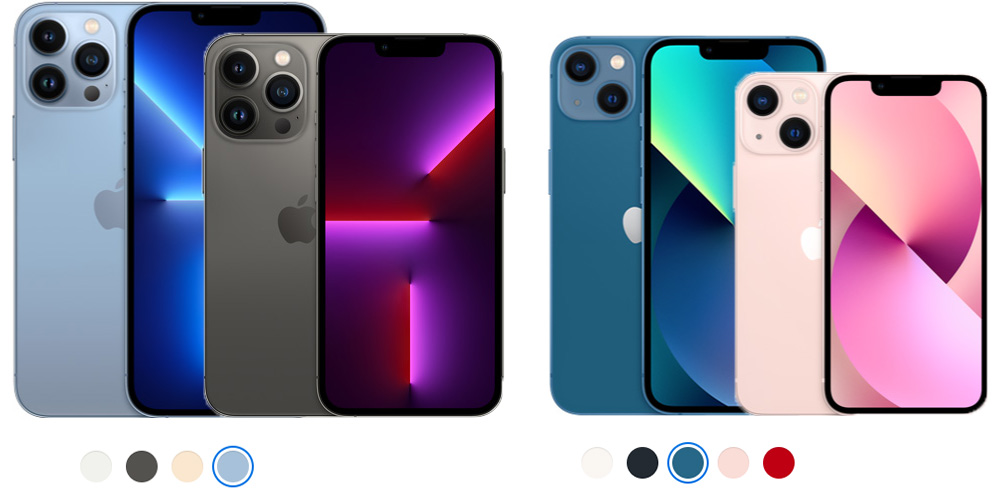
Вот такое сравнение всех моделей iPhone по порядку получилось. Как вы можете заметить, Apple старается с каждым годом и усовершенствует свои гаджеты, задавая новые тренды в мире технологий.
Получите подборку в чате мессенджера в 1 клик и узнаете, как определить подлинность iPhone, получить 2-й год гарантии и какие смартфоны перестанут работать после…
Остались вопросы?
Поделиться:
Каждый год Apple презентует новую модель iPhone, в которой обязательно найдется парочка интересных фишек. В следующем году исполняется 10 лет со дня старта продаж первого iPhone. Вот мы и решили вспомнить, как это было до сегодняшнего дня.
И заодно хотим узнать у вас: какой из этих айфонов был у вас первым?
Поехали, поностальгируем.
1. iPhone (2007)
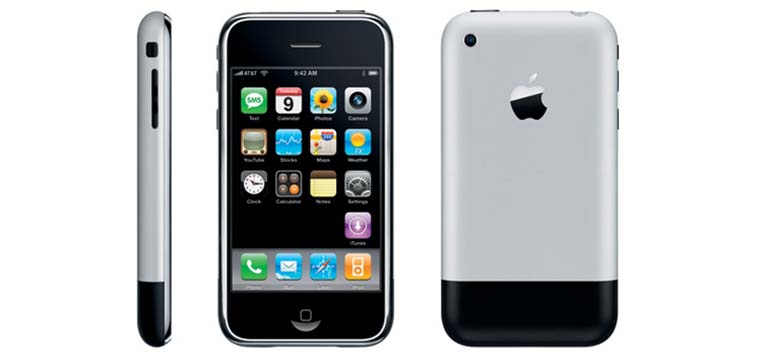
Первый iPhone был инновационным сам по себе. Сдержанный дизайн, минимум элементов на корпусе, строгая лицевая панель.
Вспомните, как выглядели смартфоны до появления iPhone: выпирающие антенны, джойстики, куча кнопок под экраном (иногда даже над ним), стилусы, выдвижная qwerty-клавиатура и неприличная толщина. А теперь посмотрите на витрины любого магазина электроники. Большинство устройств очень похожи на то, что Стив Джобс продемонстрировал 9 января 2007 года.
Компания показала, как будут выглядеть смартфоны Apple следующие несколько лет, и в дальнейшем следовала заложенному принципу.
Что расстроило: к сожалению, без минусов не бывает, iPhone первого поколения не получил ряд функций, которые были у конкурентов (поддержку 3G, запись видео, многозадачность и т.д.), операционная системы была закрыта для пользователя, присутствовало множество ограничений Apple (нельзя передавать картинки и музыку другим пользователям, ограниченная поддержка форматов данных, загрузка файлов только через iTunes).
Большим фейлом стало слишком глубокое гнездо для наушников, которое не позволяло использовать многие 3.5 мм гарнитуры.
2. iPhone 3G (2008)
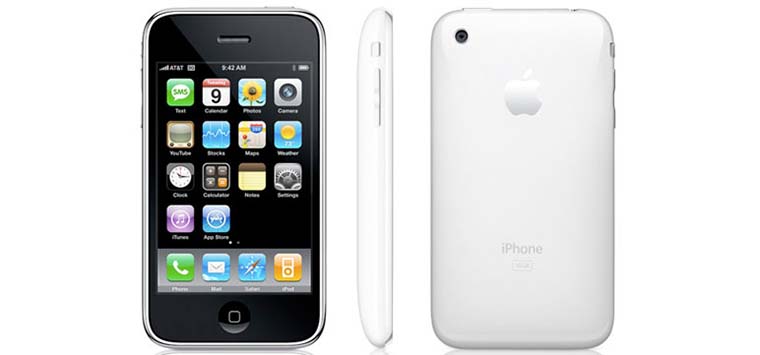
Смартфон стал обрастать функциями, в первую очередь за счет обновления мобильной операционной системы. В iOS 2.0 мы увидели App Store. C того времени сторонние разработчики получили возможность зарабатывать на нас деньги выпускать приложения для iPhone. На последней презентации Тим Кук отчитался о более чем 2 миллионах приложений в магазине.
А еще с выпуском iPhone 3G мы увидели поддержку UMTS, HSDPA, A-GPS и разные цвета корпуса (черный и белый).
Что расстроило: пластиковый корпус и его низкая износостойкость. Уже через несколько месяцев задняя панель покрывалась царапинами, возле разъема для подключения кабеля появлялись трещины, а при активной эксплуатации даже отламывались кусочки.
3. iPhone 3GS (2009)
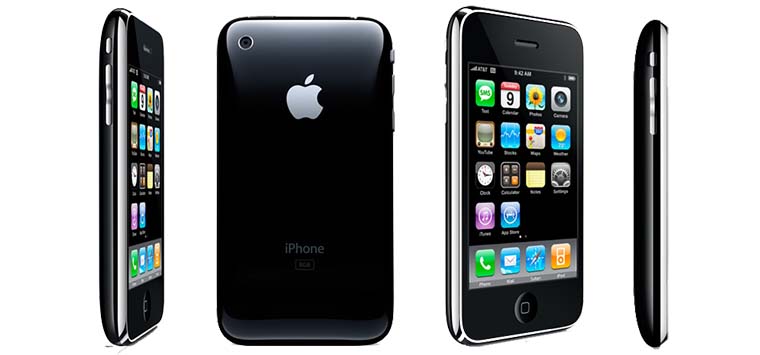
В 2009 мы впервые узнали, что Apple не собирается обновлять дизайн каждый год. После этого по нечетным годам начали выходить «эски» с прошлогодним дизайном, но новым железом.
Модель запомнилась появлением камеры с автофокусом и возможностью съемки видео. Впервые iPhone получил цифровой компас. Из программных новинок следует отметить многозадачность и голосовое управление (Voice Control).
Что расстроило: старый дизайн.
4. iPhone 4 (2010)
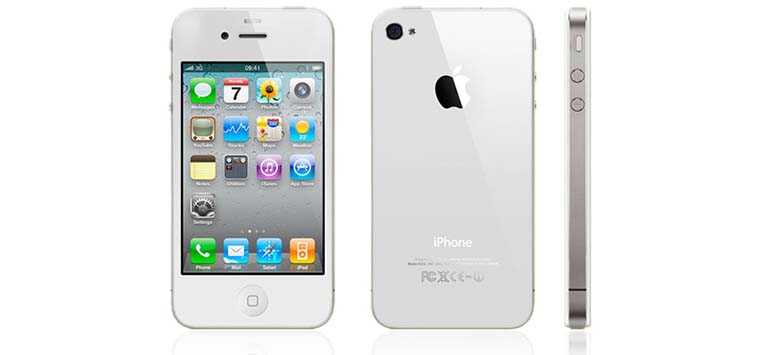
С этой моделью мы узнали об экране с высокой плотностью пикселей – Retina Display. Подержав такое устройство в руках 5 минут, пользоваться экранами прошлого поколения не хотелось. До сих пор плотность пикселей свыше 300 на дюйм считается стандартом. Технологию начали применять не только в iPhone, она появилась на планшетах и компьютерах Apple.
Еще устройство запомнилось фронтальной камерой, светодиодной вспышкой и гироскопом.
Что расстроило: антеннагейт стал большим фейлом для Apple. При определенном хвате iPhone 4 терял сеть и это имело массовый характер. Джобсу и компании пришлось извиняться и поспешно «изобретать» бамперы.
5. iPhone 4s (2011)
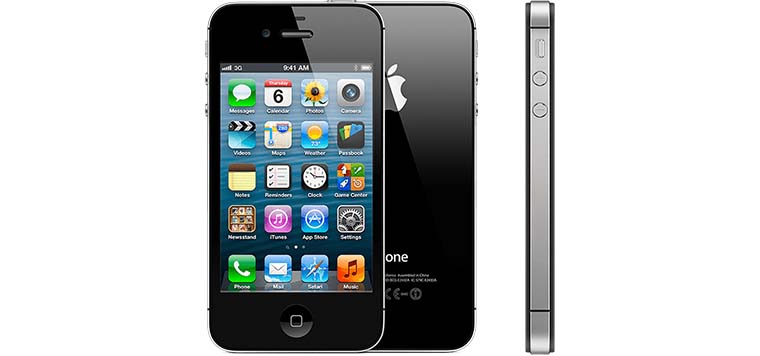
Главным новшеством последнего смартфона, выпущенного при Джобсе (вел мероприятие Тим Кук, а Стив скончался на следующий день после презентации), стал голосовой ассистент Siri.
Тогда фишка казалось малопригодной для использования. Позже Siri научилась ряду команд, узнала несколько стишков и анекдотов, даже освоила русский язык.
Сам iPhone смог раздавать интернет по Wi-Fi, снимать Full-HD видео, транслировтаь изображение по AirPlay. А еще разработчики объединили GSM и CDMA модели в одном устройстве.
Что расстроило: отсутствие поддержки русского языка в Siri.
6. iPhone 5 (2012) [Наш обзор]
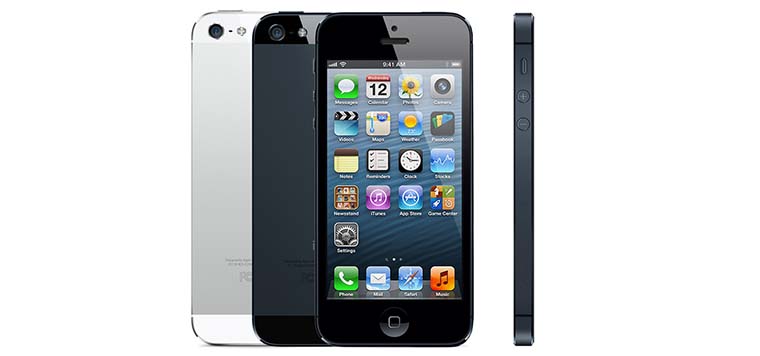
В 2012 году мы узнали, что Apple умеет выпускать устройство с диагональю экрана больше 3.5 дюймов. 30-контактный разъём ушел на покой, его сменил Lightning, который с нами по сей день.
C данной моделью многие впервые узнали о формате nano-Sim (помните, как обрезали свои карточки ножницами?) и гарнитуре EarPods.
Что расстроило: странная краска на задней панели, которая быстро облазила.
7. iPhone 5s (2013) [Наш обзор]
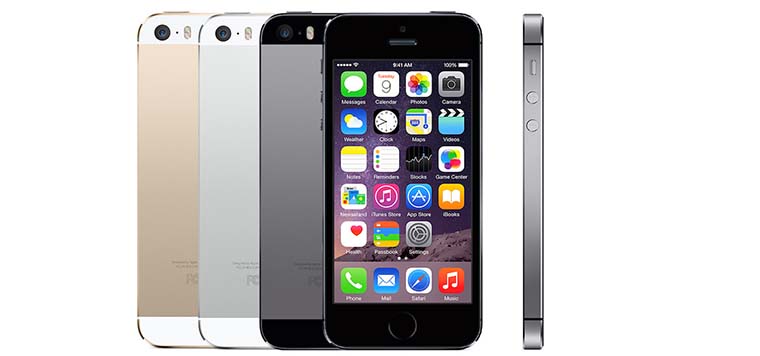
В этом устройстве появился сканер отпечатков пальцев Touch ID. Сложно представить, сколько времени эти датчики экономят нам каждый день. Вместо ввода длинного пароля просто прикладываем палец.
iPhone 5s стал первым смартфоном Apple, выпускаемым в золотом цвете.
Модель iPhone 5c рассматривать не будем. Apple пошла на эксперимент, который больше не повторялся, устройство не имело инноваций, а было лишь удешевленной копией iPhone 5 в цветном пластиковом корпусе.
Что расстроило: 64-битный процессор и 32-битные приложения, App Store был не готов к выходу модели с новым процессором. Пока разработчики не адаптировали программы и игры многие 32-битные приложения работали хуже на iPhone 5s, чем на iPhone 5.
8. iPhone 6/6 Plus (2014) [Наш обзор]
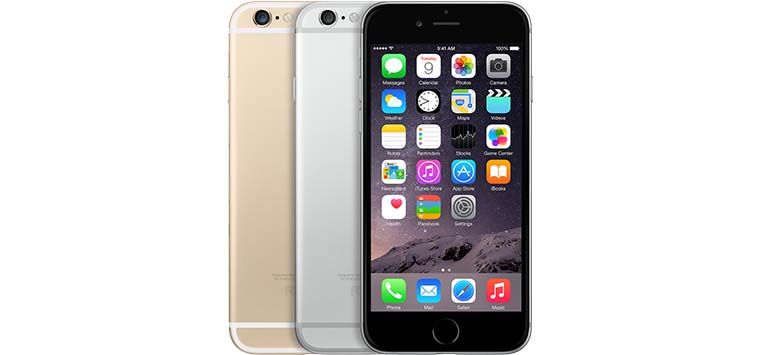
В 2014 мы увидели первые «лопаты» от Apple. Спустя два года уже привыкли к такому размеру смартфона, но тогда это был перебор.
Тонкий корпус, мощная начинка, камера со съемкой Full HD при 60 кадрах в секунду и оптической стабилизацией (в модели Plus).
Что расстроило: мы еще не забыли рекламу Apple с идеальным размером экрана для смартфона. А еще впервые увидели, как iPhone массово гнутся.
9. iPhone 6s/6s Plus (2015) [Наш обзор]
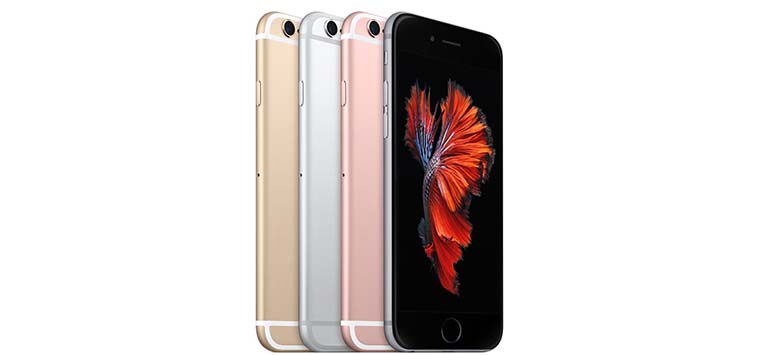
У прошлогодних новинок можно отметить чувствительный к силе нажатия экран с 3D Touch и программные новинки, связанные с применением этой технологии. А еще был новый цвет «розовое золото».
Что расстроило: слишком мало инноваций и программные фишки сомнительной пользы («живые» фото, всплывающие меню).
Был еще «тюнингованный» iPhone 5S с хитрым названием «SE» (кто забыл, вот его обзор), но модель сложно назвать инновационной. Устройство не привнесло ничего нового в линейку, хоть и стало самым мощным 4-дюймовым смартфоном на рынке.
10. iPhone 7/7 Plus (2016) [Наш обзор]
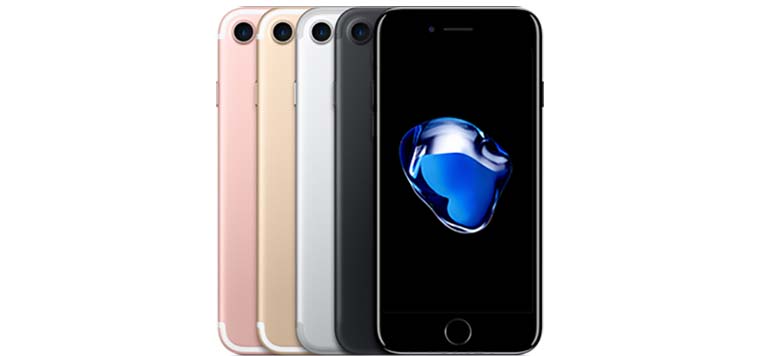
В этом году iPhone перестал бояться воды, стал разумнее расходовать заряд батареи и начал выдавать стереозвук. Довольно спорным решением стал отказ от 3.5 мм разъема. Теперь наушники только Bluetooth или Lightning.
А еще в линейке целых 5 цветов корпуса, такого не было со времен iPhone 5c.
Что расстроило: практически не изменившийся дизайн и царапающийся «черный оникс», который невозможно купить.
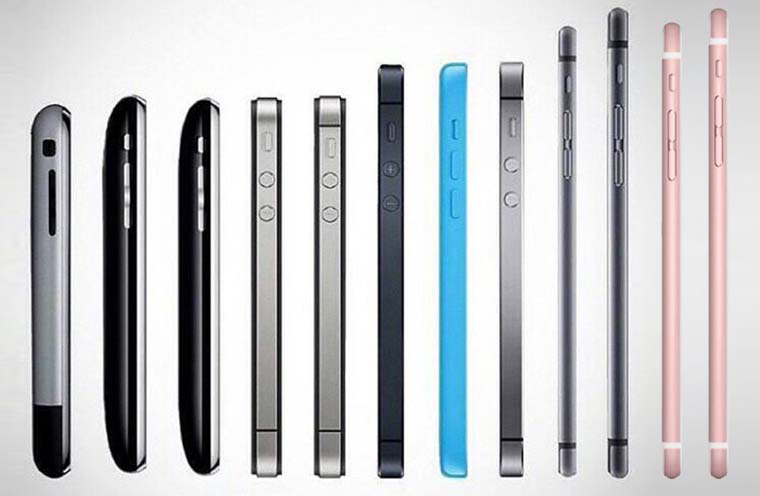
Теперь постарайтесь вспомнить, как вы реагировали на новшества каждой модели во время её появления. Никто не бежал сломя голову за iPhone только от появления в нем поддержки 3G или LTE, фронтальной камеры или вспышки, Siri или большого экрана. На момент появления этих фишек многим они казались ненужными, а сейчас мы по несколько раз в день пользуемся ими.
Из года в год все ждут от Apple революцию, требуют в iPhone голографический экран и телепорт, а сами молча пользуются техникой компании. Ни одна из фишек предыдущих смартфонов не потеряла актуальность за несколько лет, они гармонично вписались в наш сценарий использования.
Так же случится и с непонятым 3D Touch, и с влагозащитой корпуса, и с отсутствием 3.5 мм разъема. Вспомните мои слова через несколько лет.
Перестаньте думать, что в Apple сидят дураки, и что нам виднее, каким должен быть iPhone. Смартфон должен быть именно таким, какой он есть. Кого это не устраивает, добро пожаловать в клуб мыслителя Гриши.
P.S.: пишите в комментариях, с какого айфона начали вы. И с чем в итоге остались.




 (55 голосов, общий рейтинг: 4.56 из 5)
(55 голосов, общий рейтинг: 4.56 из 5)
🤓 Хочешь больше? Подпишись на наш Telegram.

iPhones.ru
Почему современный смартфон Apple именно такой, каким должен быть.
- Apple,
- iPhone
![]()
Артём Суровцев
@artyomsurovtsev
Люблю технологии и все, что с ними связано. Верю, что величайшие открытия человечества еще впереди!
Вот полный список ВСЕХ моделей iPhone от Apple по годам, включая ВСЕ изменения, даты их выпуска и многое другое…
Ответ 34 – на сегодняшний день, то есть до 2022 года. Apple выпустила 34 iPhone с 2007 года.. Сумасшедший, правда? У нас есть все айфоны в порядке их поступления ниже.
iPhone запускает и даты выпуска за прошедшие годы немного изменились, но за последние полдесятилетия Apple вошла в некоторый ритм со своими выпусками iPhone. Обычно они запускаются в третьем квартале, а затем получают дату выпуска в начале четвертого квартала. — так было примерно с 2012 года.
Обычно это означает, что мы начинаем видеть серьезные утечки информации об iPhone в течение первой половины года. По мере того, как год идет, и приближается выход нового iPhone, утечки становятся все более частыми и разоблачительными. Обычно к моменту выхода нового iPhone мы знаем почти все его новые характеристики и функции.
Как вы можете видеть ниже из списка истории дат выпуска iPhone, Apple, как правило, отдает предпочтение сентябрю / ноябрю, когда речь идет о датах выпуска. И причина этого проста: это как раз накануне самого оживленного сезона покупок в году — накануне Рождества.
iPhone в порядке выпуска — с 2007 по 202 год2
Вот краткая разбивка всех iPhone, выпущенных Apple на сегодняшний день, по годам. Первый iPhone выпущен 29 июня 2007 года.. И последний iPhone в настоящее время — это серия iPhone 2022 14 года, дата выпуска которой — 16 сентября 2022 года.
- Дата выхода iPhone — 29 июня 2007 г.
- Дата выхода iPhone 3G — 9 июня 2008 г.
- Дата выхода iPhone 3Gs — 19 июня 2009 г.
- Дата выхода iPhone 4 — 24 июня 2010 г.
- Дата выхода iPhone 4s — 14 октября 2011 г.
- Дата выхода iPhone 5 — 21 сентября 2012 г.
- Дата выхода iPhone 5s — 20 сентября 2013 г.
- Дата выхода iPhone 5c — 20 сентября 2013 г.
- Дата выхода iPhone 6 и iPhone 6 Plus — 25 сентября 2014 г.
- Дата выхода iPhone 6s и 6s Plus — 25 сентября 2015 г.
- Дата выхода iPhone SE — 31 марта 2016 г.
- Дата выхода iPhone 7 и 7 Plus — 25 сентября 2016 г.
- Дата выхода iPhone 8 и 8 Plus — 22 сентября 2017 г.
- Дата выхода iPhone X — 3 ноября 2017 г.
- Дата выхода iPhone XR — 26 октября 2018 г.
- Дата выхода iPhone XS — 21 сентября 2018 г.
- Дата выхода iPhone XS Max — 21 сентября 2018 г.
- Дата выхода iPhone 11 — 20 сентября 2019 г.
- Дата выхода iPhone 11 Pro — 20 сентября 2019 г.
- Дата выхода iPhone 11 Pro Max — 20 сентября 2019 г.
- iPhone SE (2020) Дата выхода — 24 апреля 2020 г.
- Дата выхода iPhone 12 — 23 октября 2020 г.
- Дата выхода iPhone 12 Mini — 13 ноября 2020 г.
- Дата выхода iPhone 12 Pro — 13 ноября 2020 г.
- Дата выхода iPhone 12 Pro Max — Ноябрь 13, 2020
- iPhone 13 Дата выхода — 24 сентября 2021 г.
- Дата выпуска iPhone 13 Mini – 24 сентября, 2021
- iPhone 13 Дата выпуска Pro — 24 сентября 2021 г.
- iPhone 13 Pro Max Дата выхода — 24 сентября 2021 г.
- Дата выхода iPhone SE 3 — 8 марта 2022 г.
- Дата выхода iPhone 14 – 16 сентября, 2022
- Дата выпуска iPhone 14 Plus – 16 сентября, 2022
- Дата выхода iPhone 14 Pro – 16 сентября, 2022
- Дата выхода iPhone 14 Pro Max – 16 сентября, 2022
Отображение различных «эпох iPhone»
Как видите, айфонов довольно много. За последние 12 лет Apple изменила дизайн, переосмыслила и полностью обновила iPhone, перейдя от крошечного пластикового устройства. (айфон 3G) с меньшим объемом памяти, чем USB-накопитель за 2 доллара, для более крупных и мощных телефонов, которые в 2020 году позволят большинству ноутбуков заработать свои деньги с точки зрения производительности и вычислительной мощности.
За прошедшие годы iPhone прошел через несколько «эпох» — например, у нас была эпоха 3.5 дюйма, затем эпоха 4 дюймов и, совсем недавно, эпоха 5+ дюймов с ее последними выпусками, в настоящее время линейка iPhone 12 (но это скоро будет заменен на iPhone 13, из которых будет четыре отдельные модели).
Вот как обновиться до iOS 14 на вашем iPhone прямо сейчас!
Сначала была кнопка «Домой», затем TouchID и, наконец,… FACE ID.
Точно так же iPhone от Apple претерпел некоторые серьезные изменения в том, как пользователи взаимодействуют с самим телефоном. Изначально у нас была кнопка домой. Стандартная кнопка домой оставался на своем месте с момента выпуска iPhone 3G и оставался там до выпуска iPhone 5s, в котором использовался TouchID, считыватель отпечатков пальцев Apple.
Айфоны с TouchID
TouchID тоже застрял какое-то время; вот все iPhone с TouchID:
- iPhone 5s
- iPhone 6
- iPhone 6 плюс
- iPhone 6s
- iPhone 6s плюс
- iPhone 7
- 7 iPhone Plus
- iPhone 8
- 8 iPhone Plus
- iPhone SE, SE 2020 и SE 3 (2022)
IPhone X или iPhone 10 — видел, как Apple отказалась от TouchID в пользу ID лица, новая биометрическая технология, которая позволяла пользователям разблокировать и безопасно получать доступ к своему iPhone, используя свое лицо. С этого момента FACE ID стал де-факто методом Apple для разблокировки и доступа к iPhone.
До 2020 года TouchID вернулся внутрь iPhone SE 2020, iPhone 8 redux с феноменальным процессором Apple A13 внутри. IPhone SE 2020 также является самым дешевым iPhone, который Apple когда-либо выпускала — вы можете купить его за $399.99 (или 419 фунтов стерлингов, если вы находитесь в Великобритании).
Все модели iPhone по годам
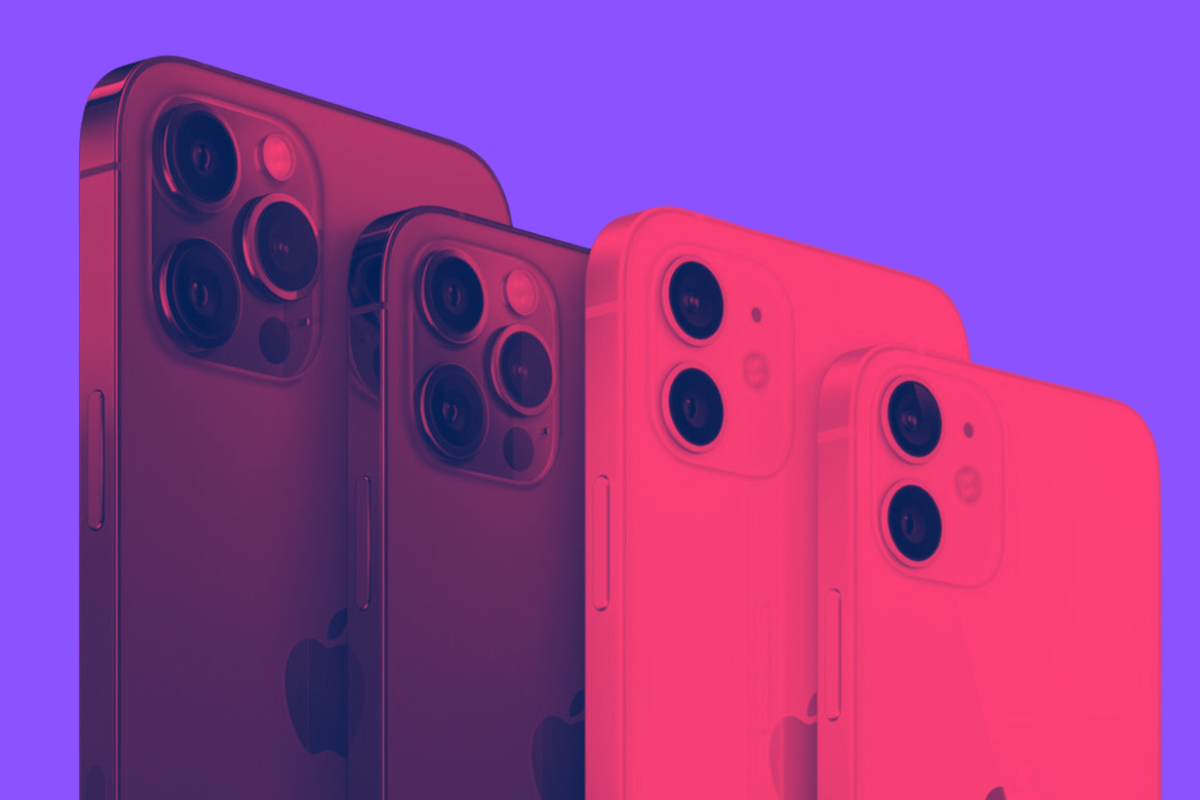
iPhone
Оригинальный iPhone выпал в 2007 году.. Это было первое мобильное устройство, выпущенное Apple, и в то время сильно критиковали прессой.
Телефон был небольшим, его часто называли iPhone 2G, потому что он не поддерживал 3G и вместо этого работал на четырехдиапазонном GSM с GPRS и EDGE. iPhone стоил 499 долларов за модель начального уровня, и после объявления Стива Джобса тысячи людей выстроились в очередь у магазинов Apple Store, чтобы купить его.
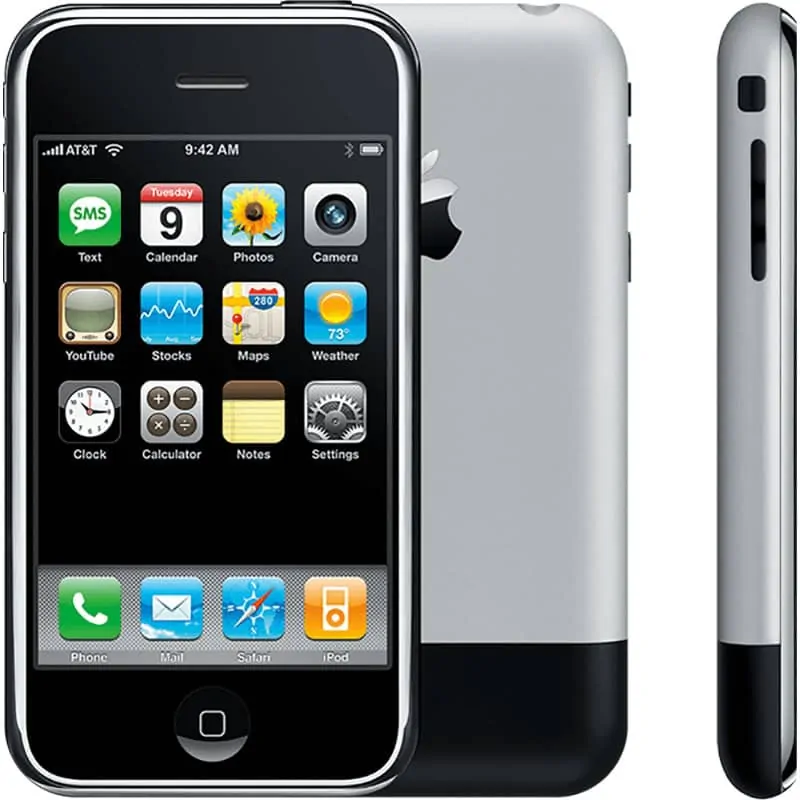
Будучи чем-то вроде прототипа будущих iPhone, iPhone 2G в значительной степени изменил мнение общественности о том, как должен выглядеть мобильный телефон. В iPhone был полнофункциональный сенсорный экран, в нем не было клавиатуры и работала под управлением совершенно новой операционной системы iPhone OS, которая позже стала iOS.
- Размеры: 115 х 61 х 11.6 мм
- Размер экрана: 3.5 дюйма, 320 х 480 пикселей
- Процессор: 412 МГц ARM 11
- Аккумулятор: несъемный литий-ионный аккумулятор
iPhone 3G
IPhone 3G был преемником iPhone; он добавил много недостающих вещей, но решающим улучшением стала возможность доступа к мобильным данным 3G (в частности, трехдиапазонный UMTS / HSDPA). Apple не стала трогать дизайн телефона, iPhone 3G работал с тем же программным обеспечением, что и его предшественник, а внутренние спецификации, за исключением возможностей подключения, остались прежними.
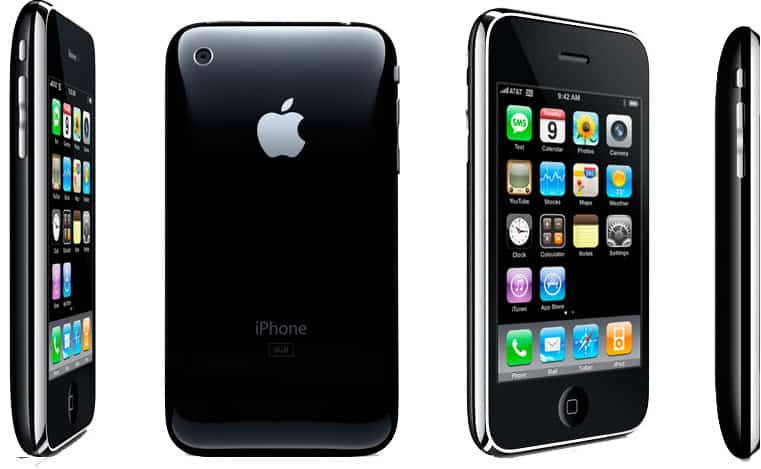
IPhone 3G был первым телефоном Apple, на котором он работал. «Быстрые» мобильные данные. Рецензенты описали телефон как улучшенную версию своего предшественника, но многие по-прежнему сетовали на его стоимость — iPhone 3G был значительно дороже своих аналогов. Но все это было частью плана Apple; он знал, что высокие цены сделают его «событием», чем-то желанным для людей, жаждущих.
- Размеры: 115.5 х 62.1 х 12.3 мм
- Размер экрана: 3.5 дюйма, 320 х 480 пикселей
- Процессор: 412 МГц ARM 11
- Аккумулятор: несъемный литий-ионный аккумулятор
iPhone 3Gs
IPhone 3Gs, опять же, был очень похож по дизайну как на iPhone 3G, так и на iPhone 3G. Однако большая разница с этим телефоном заключалась в скорости — Apple увеличила и процессор, и память телефона, чтобы сделать его быстрее. Это тоже сработало; iPhone 3Gs был одним из самых продаваемых телефонов своей эпохи., привлекая миллионы новых пользователей в экосистему Apple.
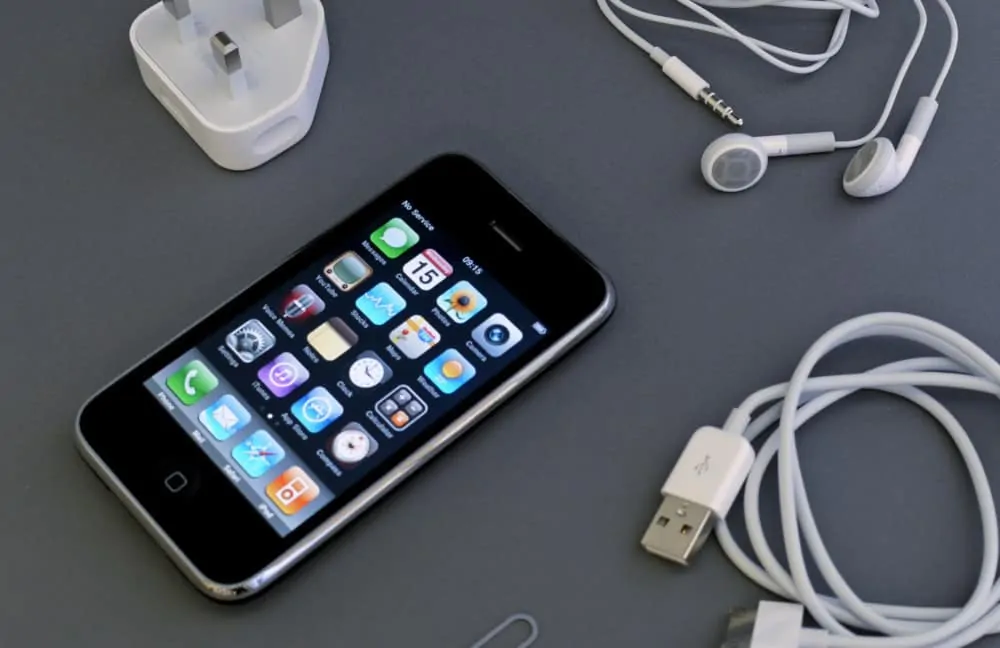
Apple также обновила камеры на iPhone 3Gs, добавив поддержку записи видео, а также увеличив количество мегапикселей на основной камере. В совокупности эти изменения принесли Apple много новых друзей. Телефон понравился прессе и игрокам тоже; iPhone 3G от Apple продавался очень хорошо и продержался пару лет. до прекращения производства в 2012 г..
- Размеры: 115.5 х 62.1 х 12.3 мм
- Размер экрана: 3.5 дюйма, 320 х 480 пикселей
- Процессор: 600 МГц Cortex-A8
- Аккумулятор: несъемный литий-ионный аккумулятор
iPhone 4
IPhone 4 стал для Apple огромным шагом вперед.. Это был первый раз, когда компания полностью изменила дизайн iPhone, и людям это понравилось. Я помню, когда он впервые вышел; он выглядел поистине потрясающе с его стильным дизайном и материалами премиум-класса. Apple также значительно улучшила характеристики и оборудование, создав впечатление, что это был телефон, над которым она работала с 2007 года.
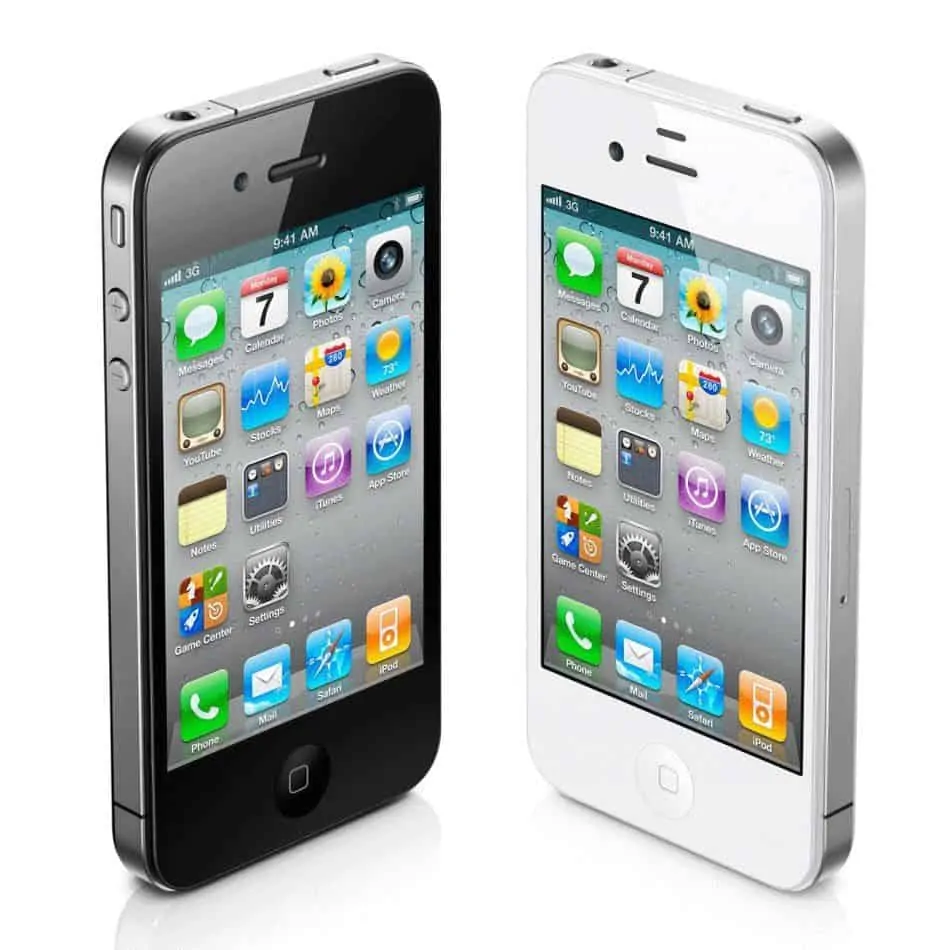
Внутри у вас была первая система Apple на кристалле с процессором A4, сильно обновленная новая версия iOS (iOS 4), включающая многозадачность (впервые) и дисплей Apple с самым высоким разрешением. когда-либо производил, который компания назвала «Retina Display». IPhone 4 имел оглушительный успех, получив 600,000 24 предварительных заказов в течение XNUMX часов с момента запуска.
- Размеры: 115.2 х 58.6 х 9.3 мм
- Размер экрана: 3.5 дюйма, 640 х 960 пикселей
- Процессор: 1.0 ГГц Cortex-A8
- Аккумулятор: аккумулятор 1420 мАч
iPhone 4s
IPhone 4s снаружи выглядел так же, как iPhone 4. Однако внутри была другая история; он поставляется с новейшим процессором Apple A5, новой 8-мегапиксельной камерой на задней панели, которая поддерживает запись видео 1080p, и, конечно же, голосовым помощником Apple Siri.
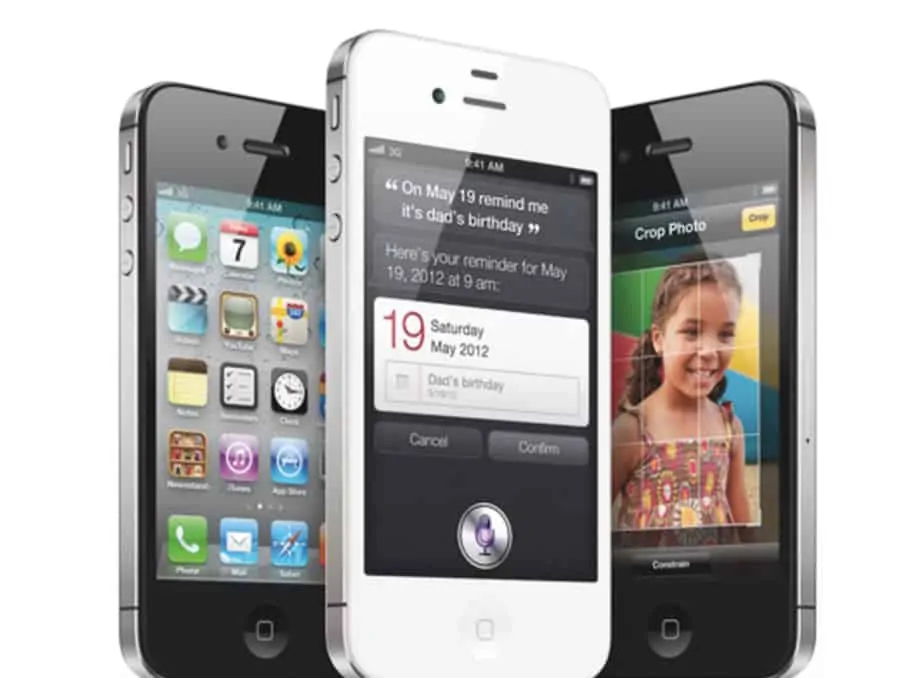
Пресса хорошо восприняла iPhone 4s; рецензентам сразу же понравился Siri, и новый двухъядерный процессор Apple A5 получил высокую оценку. В целом, iPhone 4s, несмотря на то, что в отделе дизайна был довольно инкрементным, сделал несколько довольно значительных шагов вперед в отношении характеристик, общей производительности и функций. В то время никто даже не подозревал о голосовых помощниках, не говоря уже о том, чтобы они были внутри iPhone.
- Размеры: 115.2 х 58.6 х 9.3 мм
- Размер экрана: 3.5 дюйма, 640 х 960 пикселей
- Процессор: Двухъядерный 1.0 ГГц Cortex-A9
- Аккумулятор: аккумулятор 1432 мАч
iPhone 5
iPhone 5, возможно, очень похож на iPhone 4s, но в нем есть довольно содержательные обновления. Самым значительным из них было то, что это был первый iPhone с поддержкой 4G. LTE. Вдобавок ко всему, он также работал на недавно выпущенном процессоре Apple A6, который принес с собой довольно значительные улучшения производительности.
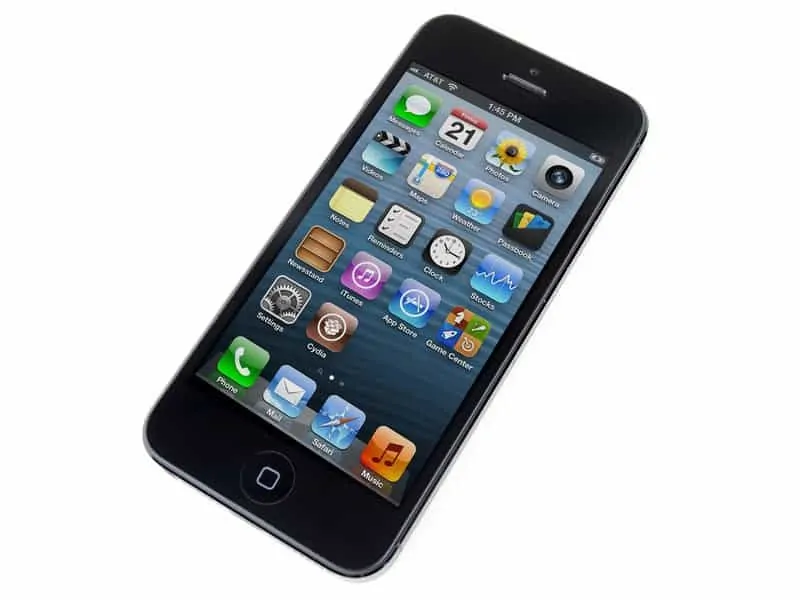
Визуально iPhone 5 выглядел как iPhone 4s. Но были физические различия; Во-первых, у него было совершенно другое соотношение сторон (16: 9), что делало его немного длиннее, чем 4s. Однако благодаря продуманной инженерии Apple iPhone 5 оказался тоньше и легче, чем 4s. Он также очень хорошо продавался; Apple зарегистрировала 2 миллиона предварительных заказов за 24 часа после запуска.
- Размеры: 123.8 х 58.6 х 7.6 мм
- Размер экрана: 4.0 дюйма, 640 х 1136 пикселей
- Процессор: двухъядерный 1.3 ГГц Swift (на базе ARM v7)
- Аккумулятор: аккумулятор 1440 мАч
iPhone 5s
IPhone 5s выглядел более или менее идентично iPhone 5 и iPhone 4s, но это был совершенно другой зверь. Внутри у вас был новый процессор Apple A7, и он сопровождался новым сопроцессором Apple M7, который обрабатывал такие вещи, как подсчет шагов. Однако самое большое изменение коснулось кнопки «Домой»; Apple заменила его на TouchID.
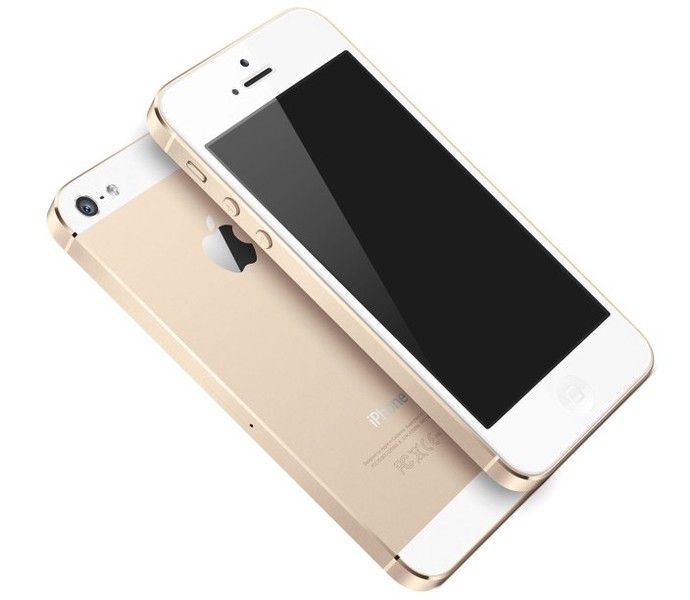
TouchID оказал огромное влияние на рынок телефонов. Это также помогло Apple получить миллиарды долларов дохода от Apple Pay. В целом iPhone 5s выглядел скучно. Но оглядываясь назад, iPhone 5s на самом деле был одним из самых значительных релизов Apple.. Он популяризировал сканеры отпечатков пальцев, это был первый iPhone от Apple с приличной камерой на полпути, и он продавался большими партиями — 9 миллионов предварительных заказов за 24 часа — это не шутка!
- Размеры: 123.8 х 58.6 х 7.6 мм
- Размер экрана: 4.0 дюйма, 640 х 1136 пикселей
- ЦП: двухъядерный 1.3 ГГц Cyclone (на базе ARM v8)
- Аккумулятор: аккумулятор 1560 мАч
iPhone 5c
К iPhone 5s при запуске присоединился iPhone 5c. Ему не хватало TouchID, который был зарезервирован для iPhone 5s. Но он действительно был в нескольких цветах, и на этом все. IPhone 5c был в основном красочным сокращением iPhone 5.. Пресса не особо хорошо ее восприняла, но продавалась очень хорошо — вы видели, как люди использовали их повсюду.
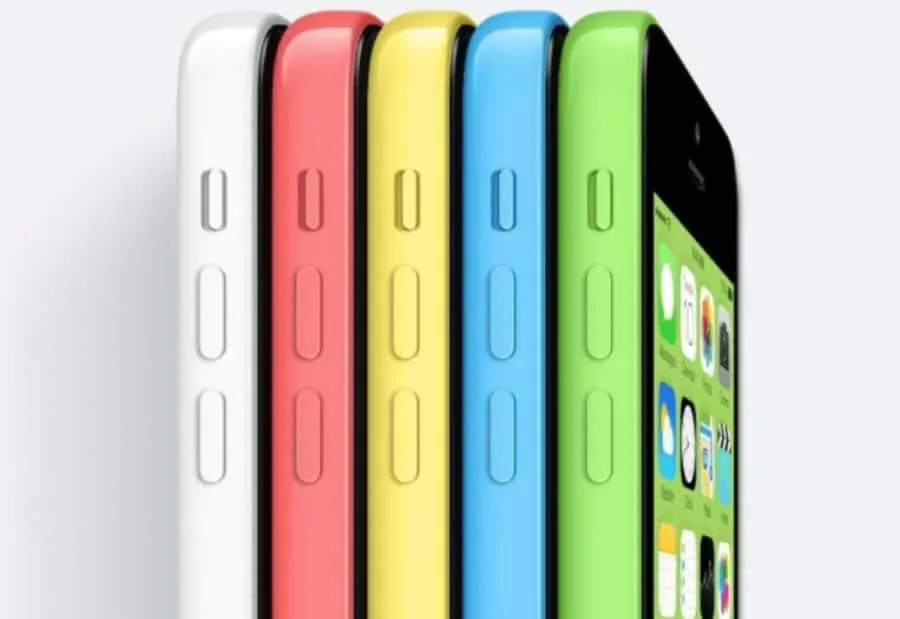
Почему iPhone 5c был так популярен? Ну, это было не из-за обзоров; они были ужасны. Нет, причина такой популярности iPhone 5c заключалась в том, что он был а) дешев для iPhone и б) имел множество цветов, поэтому он выглядел довольно ново. У меня был зеленый, но я недолго держался за него, заменив его на iPhone 5s примерно через 2 месяца использования.
- Размеры: 124.4 х 59.2 х 9 мм
- Размер экрана: 4.0 дюйма, 640 х 1136 пикселей
- Процессор: двухъядерный 1.3 ГГц Swift (на базе ARM v7)
- Аккумулятор: аккумулятор 1510 мАч
iPhone 6 и iPhone 6 Plus
После ГОДОВ сохранить тот же дизайн, Apple бросила пасть, выпустив iPhone 6 и iPhone 6 Plus. Это были не только самые большие iPhone, которые Apple выпустила на сегодняшний день, но еще и не было 4-дюймового iPhone. И это разозлило МНОГО людей, хотя они скоро успокоятся с выпуском iPhone SE.
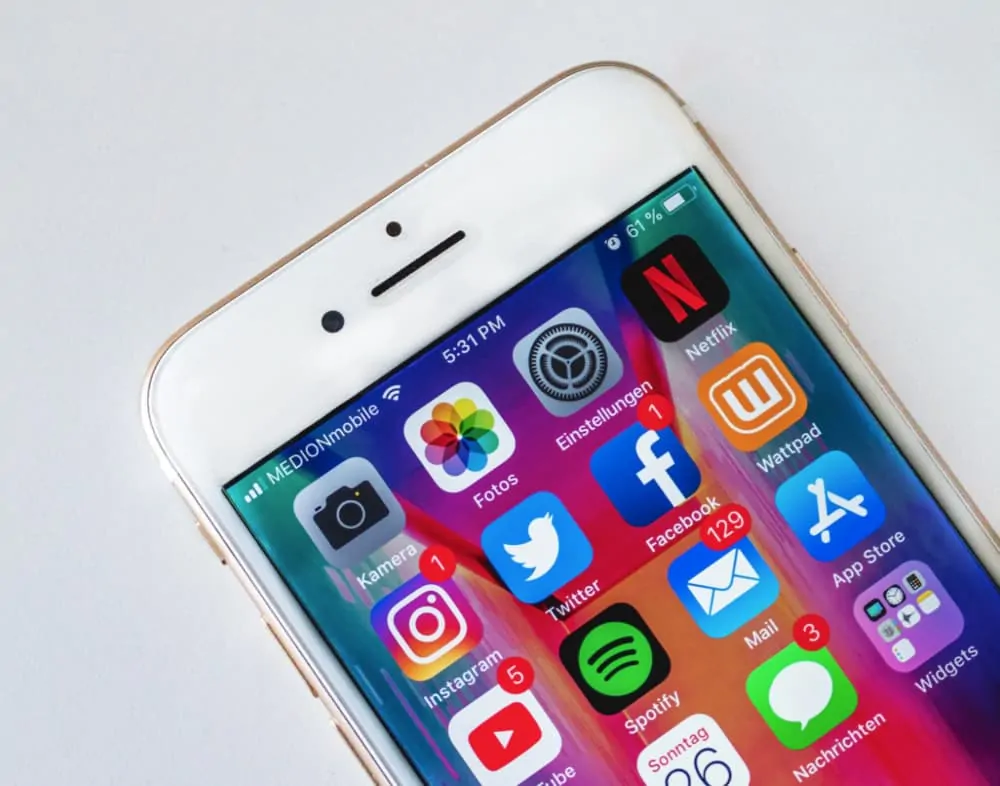
Когда вышел iPhone 6? Apple выпустила iPhone 6 и iPhone 6 Plus 19 сентября 2014 г.. IPhone 6 и iPhone 6 Plus были восьмым поколением iPhone, и они внесли довольно большие изменения в работу iPhone.
IPhone 6 и iPhone 6 Plus были значительными, потому что они были первым случаем, когда Apple действительно обновила свой промышленный дизайн после iPhone 4. iPhone 6 Plus также имел дисплей с разрешением 5.5 дюйма и разрешением 1080p, самый большой дисплей, когда-либо устанавливаемый на iPhone. Люди были шокированы, напуганы и обмануты. Тем не менее, многие из них купили телефоны.
На сегодняшний день iPhone 6 и iPhone 6 Plus от Apple остаются одними из самых продаваемых моделей компании за все время. Думаю, люди все-таки любят перемены, а?
Технические характеристики: iPhone 6
- Размеры: 138.1 х 67 х 6.9 мм
- Размер экрана: 4.7 дюйма, 750 х 1334 пикселей
- Процессор: Apple A8 (20 нм)
- Аккумулятор: аккумулятор 1810 мАч
Технические характеристики: iPhone 6 Plus
- Размеры: 158.1 х 77.8 х 7.1 мм
- Размер экрана: 5.5 дюйма, 1080 х 1920 пикселей
- Процессор: Apple A8 (20 нм)
- Аккумулятор: аккумулятор 2915 мАч
iPhone SE
Помните, когда я сказал, что многие люди были недовольны размер iPhone 6 и iPhone 6 Plus? Все стало настолько плохо, что Apple сделала самое не-Apple то, что она когда-либо делала: она на самом деле прислушивалась к своим клиентам и выпустила iPhone SE чтобы удовлетворить тех, кто хотел меньший, но такой же мощный iPhone.
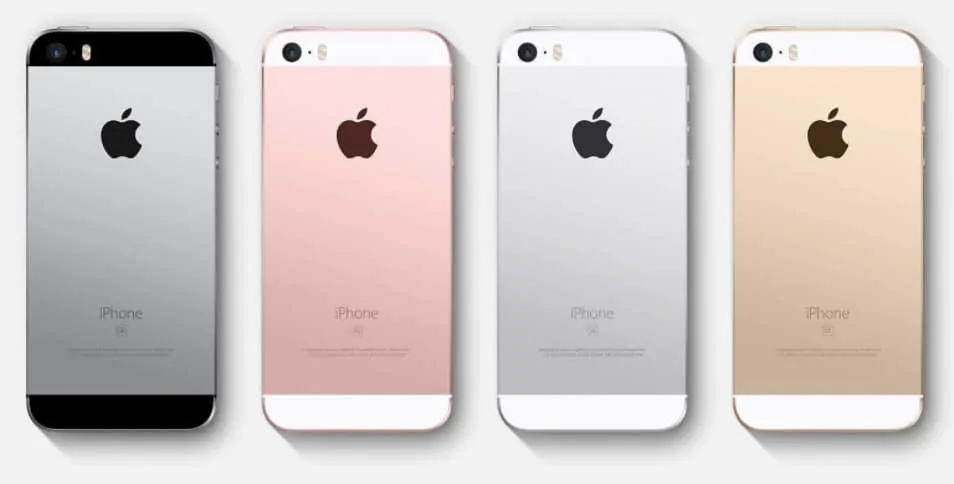
IPhone SE стал очень популярным. На самом деле у меня все еще есть один; он по-прежнему отлично работает, хотя сейчас кажется очень маленьким. Но тот факт, что он все еще работает и все еще получает обновления iOS, должен рассказать вам все, что вам нужно знать о том, почему люди так любят iPhone.
- Размеры: 123.8 х 58.6 х 7.6 мм
- Размер экрана: 4.0 дюйма, 640 х 1136 пикселей
- Процессор: Apple A9 (14 нм)
- Аккумулятор: аккумулятор 1624 мАч
iPhone 6s и 6s Plus
Компания iPhone 6 и iPhone 6s Plus были постепенными обновлениями, которые продолжались с того места, где остановилась линейка iPhone 6. Они выглядели так же, как и их предшественники, но в них были довольно существенные обновления. Самым заметным дополнением стало 3D Touch, которое позволяло вводить сенсорный ввод, чувствительный к давлению, поэтому, например, пользователь мог «пикнуть» внутри приложения, чтобы получить уведомление, не открывая его.
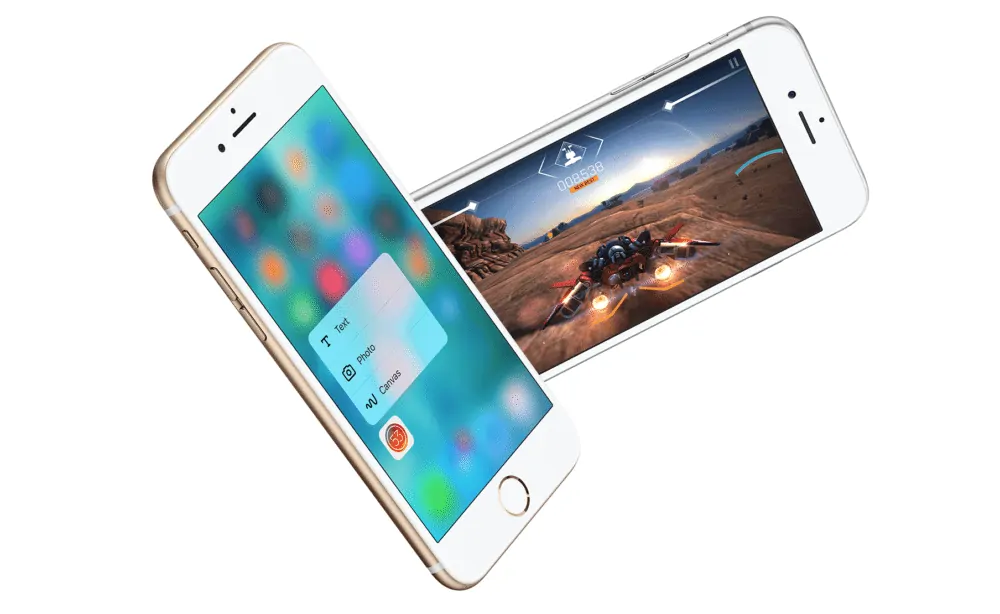
Технические характеристики: iPhone 6s
- Размеры: 138.1 х 67 х 6.9 мм
- Размер экрана: 4.7 дюйма, 750 х 1334 пикселей
- Процессор: Apple A9 (14 нм)
- Аккумулятор: аккумулятор 1715 мАч
Технические характеристики: iPhone 6s Plus
- Размеры: 158.2 х 77.9 х 7.3 мм
- Размер экрана: 5.5 дюйма, 1080 х 1920 пикселей
- Процессор: Apple A9 (14 нм)
- Аккумулятор: аккумулятор 2915 мАч
iPhone 7 и 7 Plus
IPhone 7 был спорным релизом для Apple. Это было первый iPhone без разъема для наушников, и этот поступок расстроил многих людей. IPhone 7 Plus также стал первым iPhone, оснащенным камерой с двумя объективами, оптической стабилизацией изображения и 2-кратным оптическим зумом.
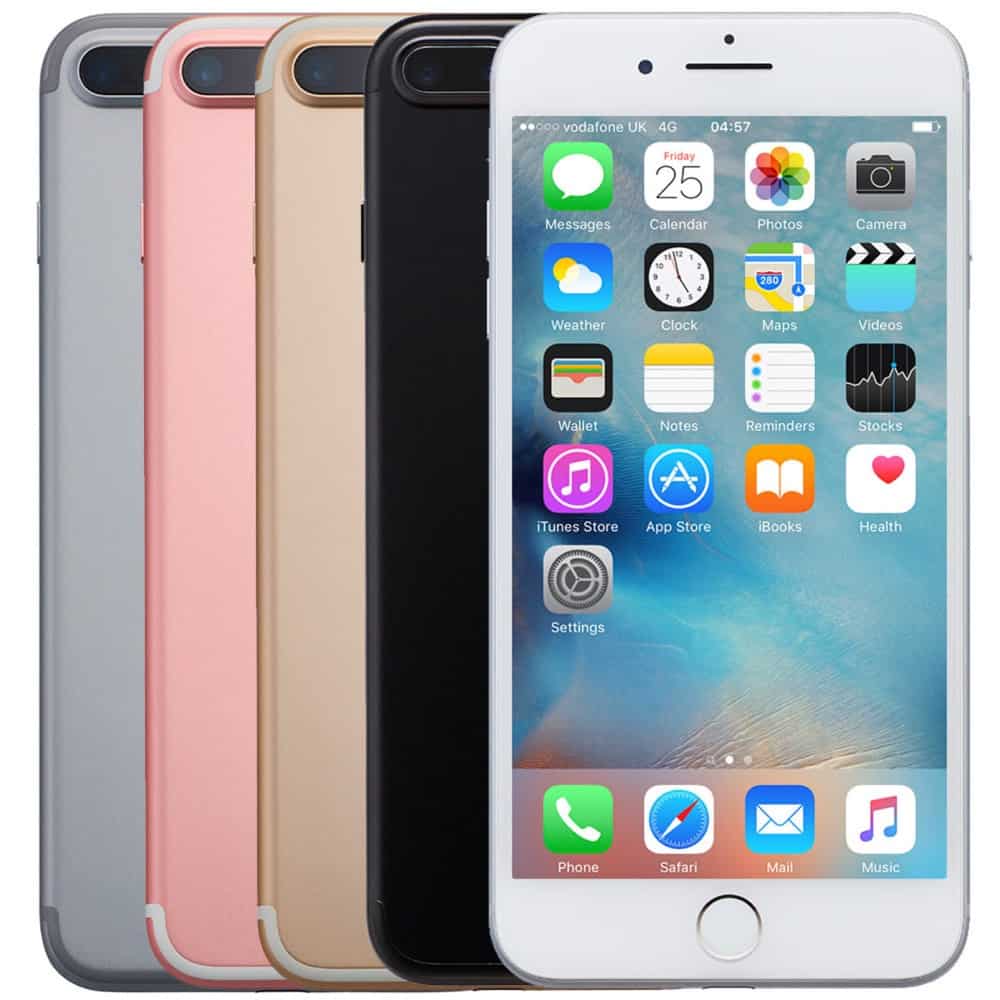
IPhone 7 Plus получил все большие обновления, но iPhone 7 по-прежнему работал с тем же процессором, четырехъядерным процессором Apple A10 Fusion и использовал OIS внутри своей однообъективной 12-мегапиксельной камеры. IPhone 7 был меньшей моделью начального уровня. IPhone 7 Plus стал де-факто флагманом, установив тенденцию, которой Apple будет следовать долгие годы, за исключением iPhone X (этот телефон был выпущен сам по себе).
Технические характеристики: iPhone 7
- Размеры: 138.3 х 67.1 х 7.1 мм
- Размер экрана: 4.7 дюйма, 750 х 1334 пикселей
- Процессор: Apple A10 Fusion
- Аккумулятор: аккумулятор 1960 мАч
Технические характеристики: iPhone 7 Plus
- Размеры: 158.2 х 77.9 х 7.3 мм
- Размер экрана: 5.5 дюйма, 1080 х 1920 пикселей
- Процессор: Apple A10 Fusion
- Аккумулятор: аккумулятор 2900 мАч
iPhone 8 и 8 Plus
IPhone 8 и iPhone 8 Plus были, ну… вроде как скучные релизы. Об этих телефонах особо нечего сказать, за исключением того факта, что у них была беспроводная зарядка, немного более мощный процессор и улучшенные дисплеи благодаря технологии Apple True Tone, которая позволяла телефонам воспроизводить контент HDR10 и Dolby Vision, несмотря на то, что у них нет дисплей с поддержкой HDR.
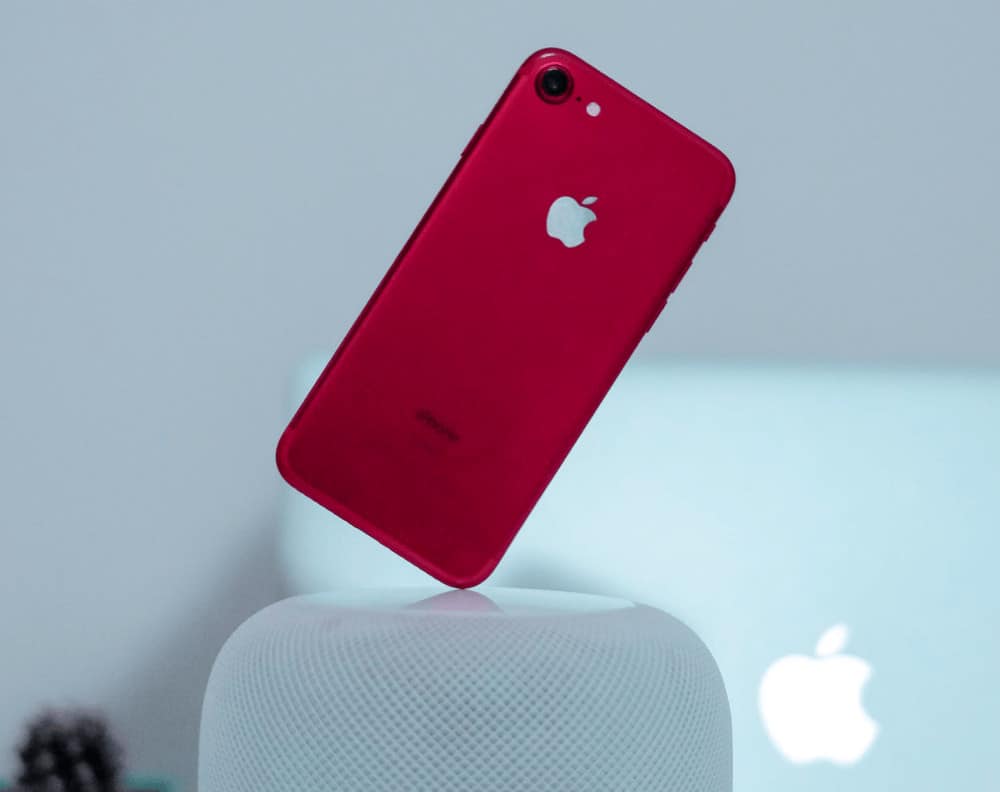
Apple также обновила задние панели; в линейке iPhone 8 использовались стеклянные задние панели. И это все, что касается iPhone 8. За годы, прошедшие после выпуска iPhone 8 и iPhone 8 Plus, телефоны действительно стали очень популярными. Apple оставила и то, и другое примерно до 2020 года; их позиционировали как «дешевый» iPhone от Apple, и в результате они очень хорошо продавались.
Технические характеристики: iPhone 8
- Размеры: 138.4 х 67.3 х 7.3 мм
- Размер экрана: 4.7 дюйма, 750 х 1334 пикселей
- Процессор: Apple A11 Bionic
- Аккумулятор: аккумулятор 1821 мАч
Технические характеристики: iPhone 8 Plus
- Размеры: 158.4 х 67.3 х 7.5 мм
- Размер экрана: 5.5 дюйма, 1080 х 1920 пикселей
- Процессор: Apple A11 Bionic
- Аккумулятор: аккумулятор 2691 мАч
iPhone X
IPhone X олицетворял 10-летие iPhone, и Apple запланировала что-то грандиозное по этому случаю. До его запуска ходили слухи об iPhone с множеством утечек, предполагающих радикально другой iPhone, непохожий на все, что мы видели раньше. Утечки были правильными. Apple iPhone X был совершенно другим — и не только с точки зрения того, как это выглядело.
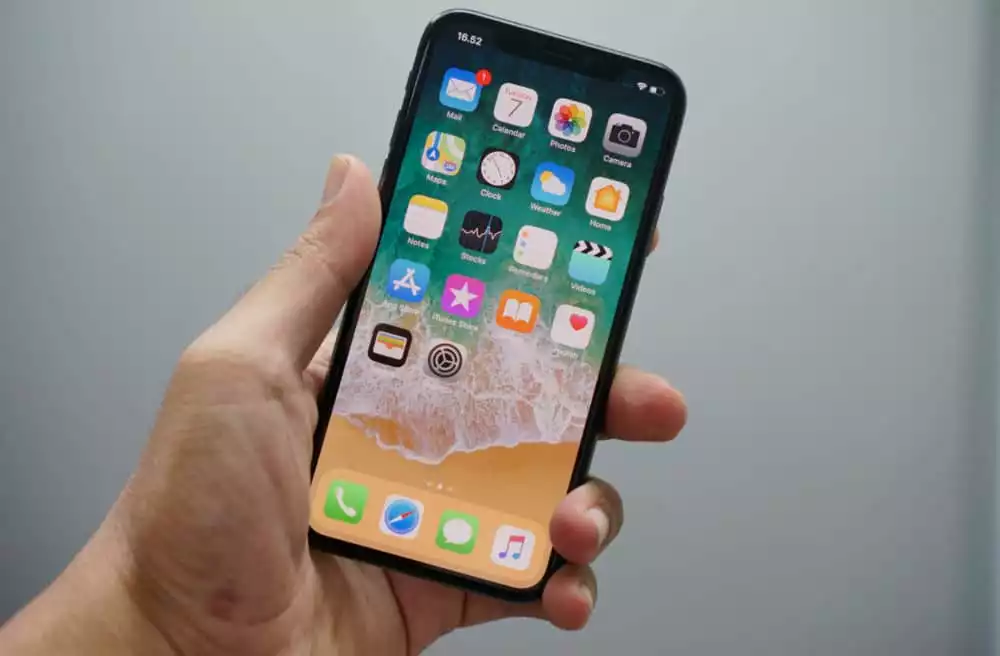
IPhone X был первый iPhone с OLED-дисплеями. Это был первый iPhone за 999.99 долларов. И это был первый iPhone, который запускался без кнопки «Домой». Вместо этого у него есть FACE ID, новая технология распознавания лиц, которая позволяет пользователям разблокировать телефон, просто взглянув на него. По сути, iPhone X был довольно большим обновлением, и он положил начало дизайну iPhone от Apple на ближайшие пять лет …
Технические характеристики: iPhone X
- Размеры: 143.6 х 70.9 х 7.7 мм
- Размер экрана: 5.8 дюйма, 1125 х 2436 пикселей
- Процессор: Apple A11 Bionic
- Аккумулятор: аккумулятор 2716 мАч
iPhone XR
IPhone XR был исключительно популярен; он продавался непосильно благодаря Apple, использовавшей свой запатентованный маркетинговый трюк с красивыми вариантами цвета, низкой (ишой) цене и тому факту, что он работал блестяще благодаря чрезвычайно мощному процессору Apple A12 Bionic. В iPhone XR также имел массивный дисплей., 6.1in, но у него не было OLED-дисплея, как у iPhone X.
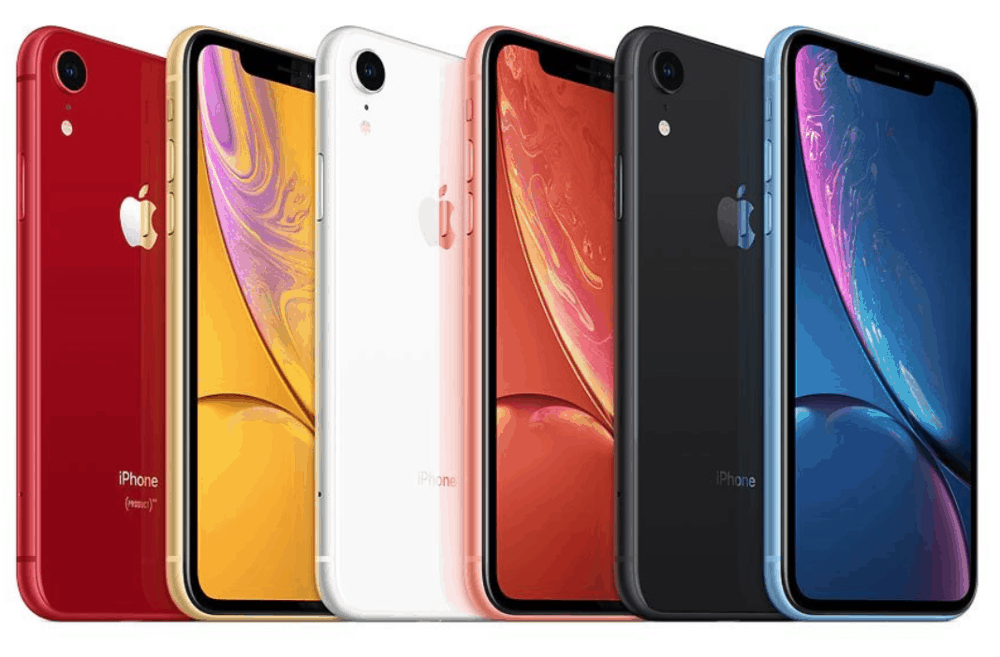
В общем, iPhone XR оказался самым успешным выпуском Apple в эпоху iPhone X, которая включала iPhone X и iPhone XS/XS Max. Это был самый продаваемый телефон компании как в 2018, так и в 2019 году. низкая цена на восстановленный iPhone такие сайты, как Газель — сейчас вы можете купить ее менее чем за 400 долларов.
Технические характеристики: iPhone XR
- Размеры: 150.9 х 75.7 х 8.3 мм
- Размер экрана: 6.0 дюйма, 1125 х 2436 пикселей
- Процессор: Apple A12 Bionic
- Аккумулятор: аккумулятор 2942 мАч
iPhone XS / XS Max
IPhone XS и iPhone XS Max оснащены OLED-панелями и процессором Apple A12 Bionic. IPhone XS Max был де-факто флагманом, у него был больший дисплей (6.4 дюйма против 5.8 дюйма у XS) и большая батарея, однако внутренние компоненты телефона, включая камеру, были идентичны на обеих моделях.
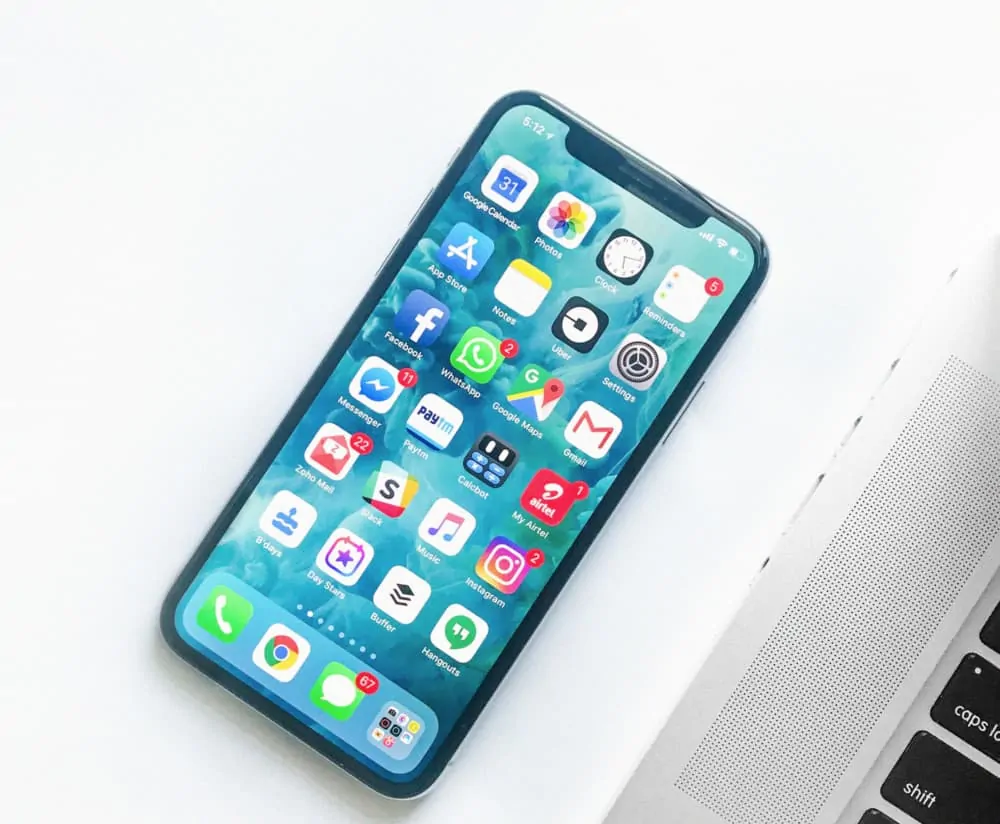
Цены на iPhone XS начинались с 999 долларов и превысили 1300 долларов за модель хранилища высшего уровня. теперь вы можете забрать их менее чем за 500 долларов. Что касается критического приема, iPhone XS и iPhone XS Max были хорошо приняты, получив солидные отзывы повсюду, многие обозреватели выразили сожаление по поводу решения Apple не обновлять язык дизайна.
Помните: этот язык дизайна используется с момента выпуска iPhone X. Помня о модели «эпохи» Apple, эпохе X, в которой iPhone 9 быть пропущенным — не завершится до 2019 года выпуском линейки iPhone 11, однако даже эти телефоны очень напоминали XS и XS Max.
Технические характеристики: iPhone XS
- Размеры: 143.6 х 70.9 х 7.7 мм
- Размер экрана: 5.8 дюйма, 1125 х 2436 пикселей
- Процессор: Apple A12 Bionic
- Аккумулятор: аккумулятор 2658 мАч
Технические характеристики: iPhone XS Max
- Размеры: 157.5 х 77.4 х 7.7 мм
- Размер экрана: 6.4 дюйма, 1242 х 2688 пикселей
- Процессор: Apple A12 Bionic
- Аккумулятор: аккумулятор 3174 мАч
iPhone 11/11 Pro / 11 Pro Max
Модельный ряд Apple iPhone 11 был значительным, потому что он эффективно использовал уроки, извлеченные Apple с линейкой iPhone X, в частности, вам нужна более дешевая модель, меньшая флагманская модель и флагман с большим дисплеем, чтобы должным образом удовлетворить потребности всех потребителей. Линейка iPhone 11 оказалась очень популярной, чему без конца не помешало то, как iPhone 11 начального уровня было на практике — 699.99 долларов, это дешевле и все же мощнее, чем Samsung Galaxy S10 и его новый Galaxy S20.
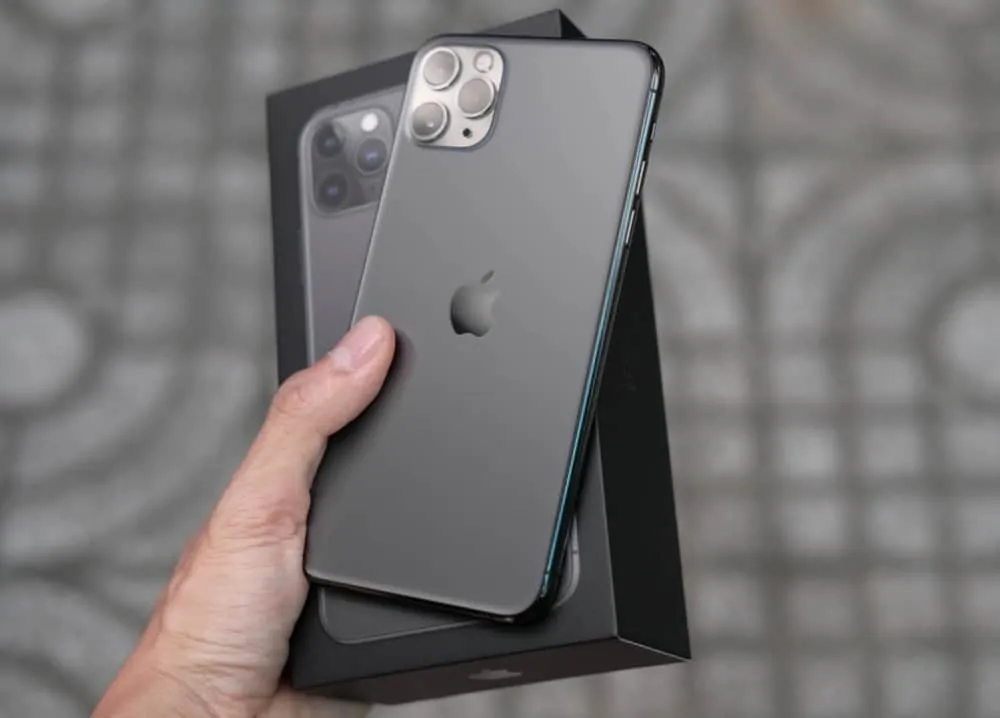
Компания iPhone 11 Pro и iPhone Pro Max были первыми iPhone, в которых были установлены камеры с тремя объективами, и этот шаг был долгим. Apple действительно увеличила производительность камеры для линейки iPhone 11, и это сработало — камера iPhone 11 Pro очень и очень впечатляет. Сами телефоны были похожи на линейку iPhone XS: iPhone 11 пришел на смену iPhone XR. Внутри телефонов был установлен чипсет Apple A13, чрезвычайно мощный SoC, который может работать с большинством ноутбуков среднего класса.
Технические характеристики: iPhone 11
- Размеры: 150.9 х 75.7 х 8.3 мм
- Размер экрана: 6.1 дюйма, 828 х 1792 пикселей
- Процессор: Apple A13 Bionic
- Аккумулятор: аккумулятор 3110 мАч
Технические характеристики: iPhone 11 Pro
- Размеры: 144 х 71.4 х 8.1 мм
- Размер экрана: 5.8 дюйма, 1125 х 2436 пикселей
- Процессор: Apple A13 Bionic
- Аккумулятор: аккумулятор 3046 мАч
Технические характеристики: iPhone 11 Pro Max
- Размеры: 158 х 77.8 х 8.1 мм
- Размер экрана: 6.4 дюйма, 1242 х 2688 пикселей
- Процессор: Apple A13 Bionic
- Аккумулятор: аккумулятор 3969 мАч
iPhone SE (2020 г.)
Apple удачно начала 2020 год, выпуск iPhone SE 2020 24 апреля. IPhone SE 399.99 по цене 419 долларов в США и 2020 фунтов стерлингов в Великобритании — это самый дешевый iPhone, который Apple когда-либо выпускала. По сути, iPhone SE 8 является редуктором iPhone 2020, он оснащен тем же процессором, что и iPhone 11 Pro Max, то есть чипом A13 Bionic компании. SE 2020 также оказался быстрее, чем Samsung Galaxy S20 Ultra — и этот телефон стоит 1200 долларов.
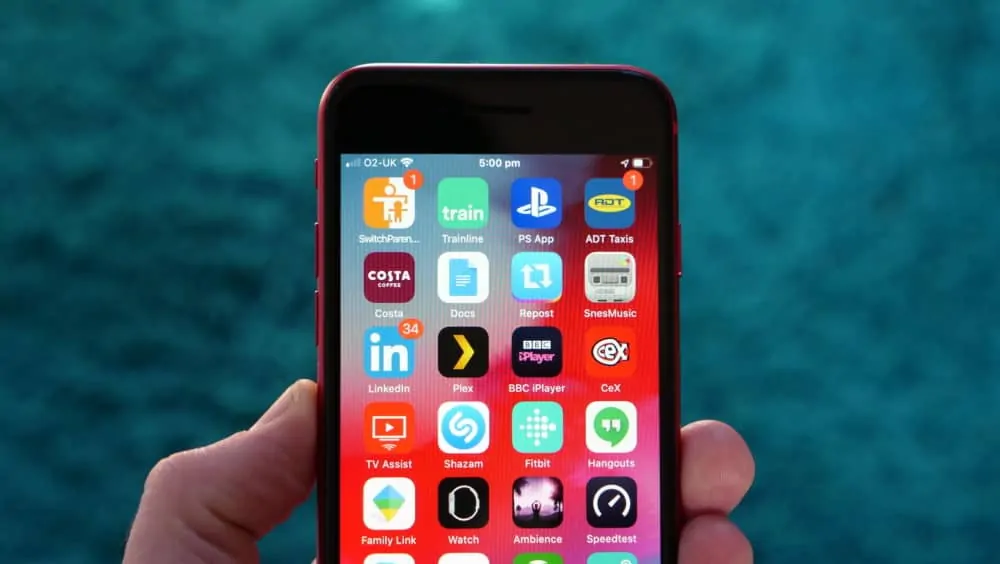
IPhone SE 2020 был хорошо принят обозревателями; Дэмиен — наш рецензент — провел взрывное тестирование iPhone SE 2020, утверждая, что это был двигатель с точки зрения производительности. Срок службы батареи не так хорош, как хотелось бы, из-за небольшого размера телефона, но это всегда будет иметь место с телефонами меньшего форм-фактора. Однако самое интересное в iPhone SE 2020: перспектива iPhone SE Plus модель, которая заменит iPhone 8 Plus в качестве более дешевого, но более крупного iPhone начального уровня от Apple.
На iPhone 8 и iPhone 8 Plus по-прежнему приходилась довольно большая часть продаж iPhone от Apple в 2019 году, поэтому логично предположить, что компания захочет заменить оба телефона. У нас есть замена iPhone 8 в виде iPhone SE 2020, так что теперь нам просто нужно дождаться приземления iPhone SE Plus. Если говорить лично, мне будет очень интересен iPhone SE Plus. IPhone 8 Plus по-прежнему отличный телефон; камера прочная и у нее массивный аккумулятор. Добавьте чипсет A13, и вы увидите чертовски красивую комбинацию!
Технические характеристики: iPhone SE (2020)
- Размеры: 138.4 х 67.3 х 7.3 мм
- Размер экрана: 4.7 дюйма, 750 х 1334 пикселей
- Процессор: Apple A13 Bionic
- Аккумулятор: аккумулятор 1821 мАч
Мини 12 iPhone
Компания iPhone 12 Mini — самый маленький iPhone сделал за годы. Ближе к оригинальному iPhone SE по размеру, чем текущая модель SE 2020, iPhone 12 Mini — это полнофункциональный iPhone, обладающий теми же характеристиками, что и более крупный iPhone 12.
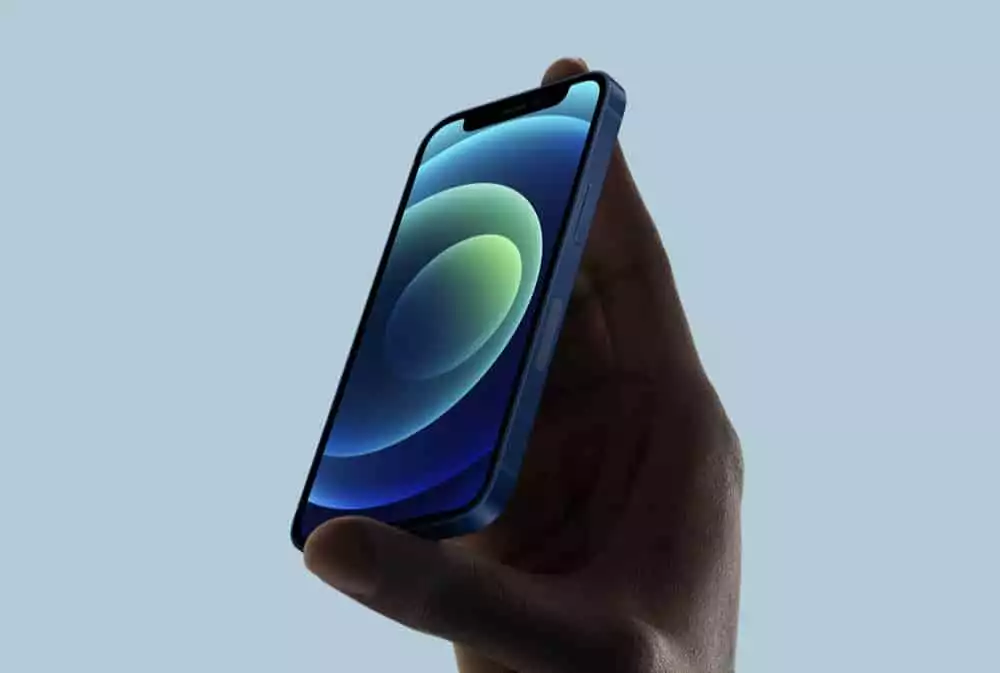
У вас есть 5.4-дюймовый OLED-дисплей, возможность подключения 5G, процессор Apple A14, а также тот же объем оперативной памяти и доступного хранилища, что и у модели. iPhone 12. По сути, iPhone 12 Mini — это просто уменьшенный iPhone 12.
И это действительно круто, потому что, если вам нужен маленький iPhone как и многим людям, вам больше не нужно идти на уступки в отношении оборудования и спецификаций. Нравиться Телефоны Google Pixel, большой и маленький iPhone 12 идентичны во всех ключевых областях, за исключением размера батареи и размера экрана.
Технические характеристики: iPhone 12 mini
- Размеры: 131.5 х 64.2 х 7.4 мм
- Размер экрана: 5.4 дюйма, 1080 х 2340 пикселей
- Процессор: Apple A14 Bionic
- Аккумулятор: аккумулятор 2227 мАч
iPhone 12
IPhone 12 заменяет iPhone 11; это базовая модель линейки наряду с iPhone 12 Mini, хотя Apple внесла здесь некоторые довольно значительные изменения. Для начинающих есть OLED-дисплей. И 5G тоже.
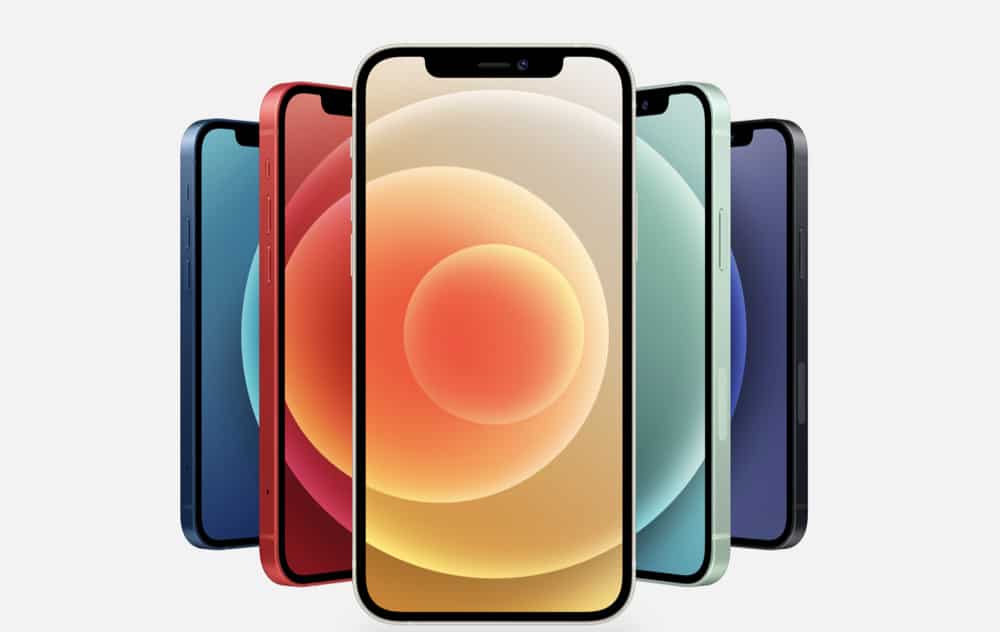
Что касается дизайна, Apple немного изменила дизайн телефонов в линейке iPhone 12. Все они теперь имеют квадратный боковой профиль, как у iPhone 4 и iPhone 4s. В сочетании с дизайном эпохи iPhone X это приводит к более компактному виду спереди и сзади.
У iPhone 12 6.1-дюймовый дисплей и процессор Apple A14. У вас снова есть камера с двумя объективами, хотя на этот раз Apple настроила датчики для лучшей работы при слабом освещении.
IPhone 12 не является массовым обновлением по сравнению с iPhone 11, но если вы используете iPhone X или старше, переход на iPhone 12 будет ощущаться как масштабное обновление — он значительно быстрее, у него лучший дисплей, он работает под управлением 5G и имеет новый, более продуманный дизайн.
Технические характеристики: iPhone 12
- Размеры: 146.7 х 71.5 х 7.4 мм
- Размер экрана: 6.1 дюйма, 1170 х 2532 пикселей
- Процессор: Apple A14 Bionic
- Аккумулятор: аккумулятор 2815 мАч
iPhone 12 Pro
Компания iPhone 12 Pro в этом году выросла в размерах. У iPhone 11 Pro был OLED-дисплей с диагональю 5.8 дюйма. На этот раз Apple установила в iPhone 12 Pro 6.1-дюймовую OLED-панель. У него также вторая лучшая камера в линейке iPhone 12 с тройным объективом, установленным на задней панели.
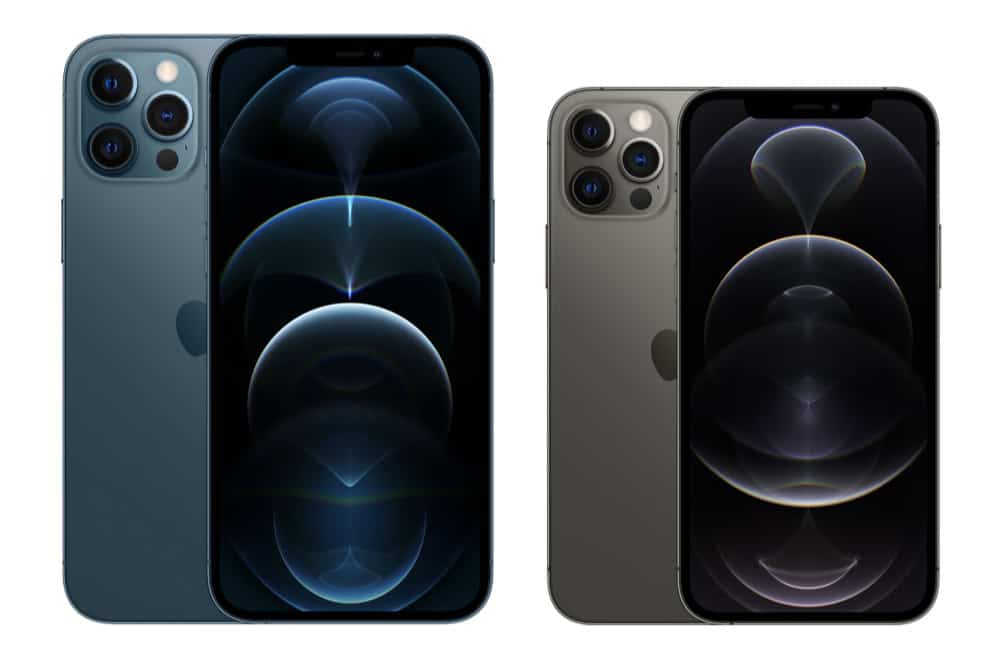
Прозвище PRO означает, что этот телефон является частью двухуровневого флагманского предложения Apple на 2020 год. Вы получаете лучшие характеристики внутри и более продвинутую камеру, чем iPhone 12 и iPhone 12 Mini. Технология камеры — это то, чем iPhone 12 и iPhone 12 Pro различаются больше всего, поэтому, если технология камеры важна для вас, вы захотите выбрать одну из моделей iPhone 12 Pro.
В плане камеры iPhone 12 Pro выглядит немного менее впечатляюще, чем iPhone 12 Pro Max. Но для большинства пользователей разница будет незначительной. Если вы выберете любую из моделей Pro, вы получите поистине потрясающую производительность камеры — фото и видео.
Хотя для лучших из лучших, вам нужно обратиться к iPhone 12 Pro Max.
Технические характеристики: iPhone 12 Pro
- Размеры: 146.7 х 71.5 х 7.4 мм
- Размер экрана: 6.1 дюйма, 1170 х 2532 пикселей
- Процессор: Apple A14 Bionic
- Аккумулятор: аккумулятор 2815 мАч
iPhone 12 Pro Max
iPhone 12 Pro Max — самый большой iPhone, выпущенный Apple на сегодняшний день, с 6.7-дюймовым OLED-дисплеем. Внутри, внутренние характеристики почти такие же, как у iPhone 12 Pro — у него тот же процессор, те же параметры памяти и тот же объем оперативной памяти..
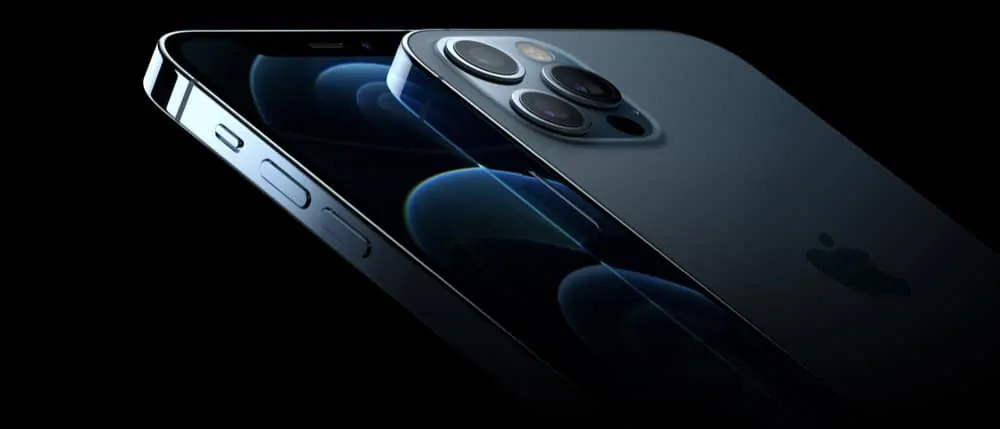
С камерой все становится немного более впечатляющим на iPhone 12 Pro Max. И это действительно то, за что вы здесь платите: самый большой из возможных OLED-дисплей и лучшую на сегодняшний день камеру iPhone, в комплекте с Датчик ToF LiDAR от Apple.
Благодаря более длинному объективу с фокусным расстоянием, эквивалентным 65 мм, iPhone 12 Pro Max имеет больший оптический зум, чем модель Pro, и 12-кратный цифровой зум. Добавьте такие вещи, как LiDAR и вы смотрите на самую совершенную камеру iPhone на сегодняшний день.
До 2021 года, когда мы увидим, что iPhone 13 начнет обретать форму.
Технические характеристики: iPhone 12 Pro Max
- Размеры: 160.8 х 78.1 х 7.4 мм
- Размер экрана: 6.7 дюйма, 1284 х 2778 пикселей
- Процессор: Apple A14 Bionic
- Аккумулятор: аккумулятор 3687 мАч
iPhone 13
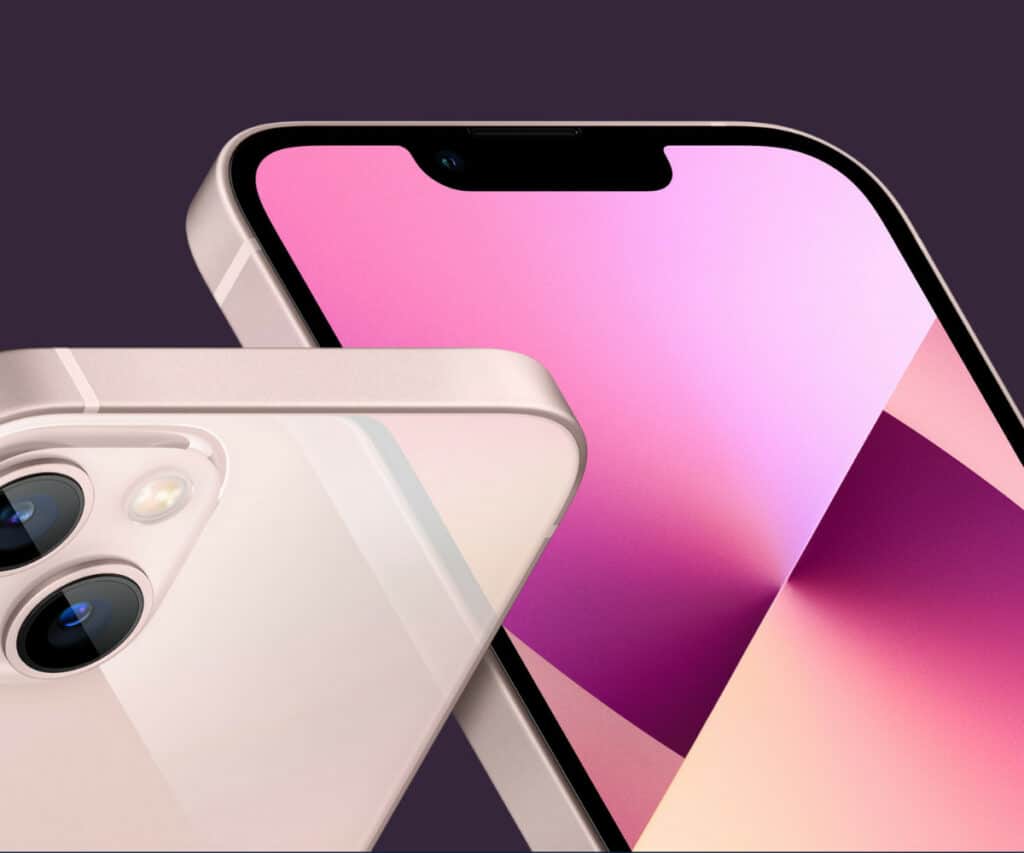
В iPhone 13 Apple увеличила время автономной работы ВСЕХ моделей, вернув производительность к тому, что было на iPhone 11. У вас все еще есть 5G, но благодаря использованию более крупных аккумуляторных элементов внутри телефонов у вас их больше нет. проблемы с временем автономной работы при работе 5G.
Вот краткое описание всех изменений, которые Apple представила во всех своих моделях iPhone 13:
Список обновлений iPhone 13
- iPhone 13 получает постепенные обновления от iPhone 12 Pro; Теперь он оснащен тем же 12-мегапиксельным объективом с диафрагмой f / 1.6, что и iPhone 2020 Pro 12 года. Новая сверхширокоугольная камера iPhone 13 также имеет более светосильный объектив с диафрагмой f / 2.4 и поле обзора 120 градусов, а также технологию стабилизации со смещением сенсора.
- Все модели iPhone 13 имеют кинематографический режим; эта технология будет автоматически переключать фокус в реальном времени, что сделает все телефоны в диапазоне более удобными для съемки видео. Apple использовала пародию на Ножи чтобы продемонстрировать, как Кинематографический режим работ.
- Линия iPhone 13 имеет меньшую выемку. Вырез на iPhone 13 на 20% меньше, чем был раньше.
- iPhone 13 имеет лучшую производительность 5G, чем iPhone 12. По данным Apple, iPhone 13 подключается к сетям 5G быстрее, и к концу 200 года он будет поддерживать более 60 операторов связи в более чем 2021 странах.
- IPhone 13 оснащен новым процессором Apple A15. Apple заявляет, что новый чипсет A15, все еще 5-нм SoC, на 50% быстрее, чем его ближайший конкурент (Snapdragon 888), хотя эти утверждения еще не были проверены.
- Чипсет A15 включает два новых высокопроизводительных ядра и четыре новых высокоэффективных ядра.
Список обновлений iPhone 13 Pro и iPhone Pro Max
- Все модели Apple iPhone 13 Pro оснащены новыми экранами Super Retina XDR с частотой 120 Гц и повышенной яркостью (до 1000 нит).
- IPhone 13 Pro и Pro Max доступны в следующих цветах: графитовый, золотой, серебряный и новый голубой.
- Все три камеры были обновлены внутри линейки iPhone 13 Pro; у вас лучшие характеристики при слабом освещении благодаря более крупным датчикам, более широкой диафрагме для сверхширокоугольного объектива и 3-кратному зуму для телеобъектива. Ночной режим теперь поддерживается всеми тремя объективами.
- 13 Pro и 13 Pro Max теперь оснащены новым макрообъективом, который позволяет снимать объекты с расстояния всего 2 см. Все модели Apple Pro теперь оснащены оптической стабилизацией изображения со сдвигом сенсора.
- Модели Pro также имеют кинематографический режим, но также получат выгоду от Новая технология Apple ProRes. Вы можете снимать в 4K со скоростью до 30 кадров в секунду с моделями iPhone 13 Pro, а с ProRes, видеоформатом более высокого качества, вы можете редактировать более детально после того, как отснятый материал будет отснят.
- Все модели iPhone 13 Pro получают дополнительный уровень памяти, 1 ТБ — вероятно, это связано с использованием ProRes.
- Apple улучшила время автономной работы iPhone 13 Pro и 13 Pro; iPhone 13 Pro проработает на 1.5 часа дольше, чем iPhone 12 Pro, а iPhone 13 Pro Max проработает на 2.5 часа дольше, чем iPhone 12 Pro Max.
iPhone 14 серии
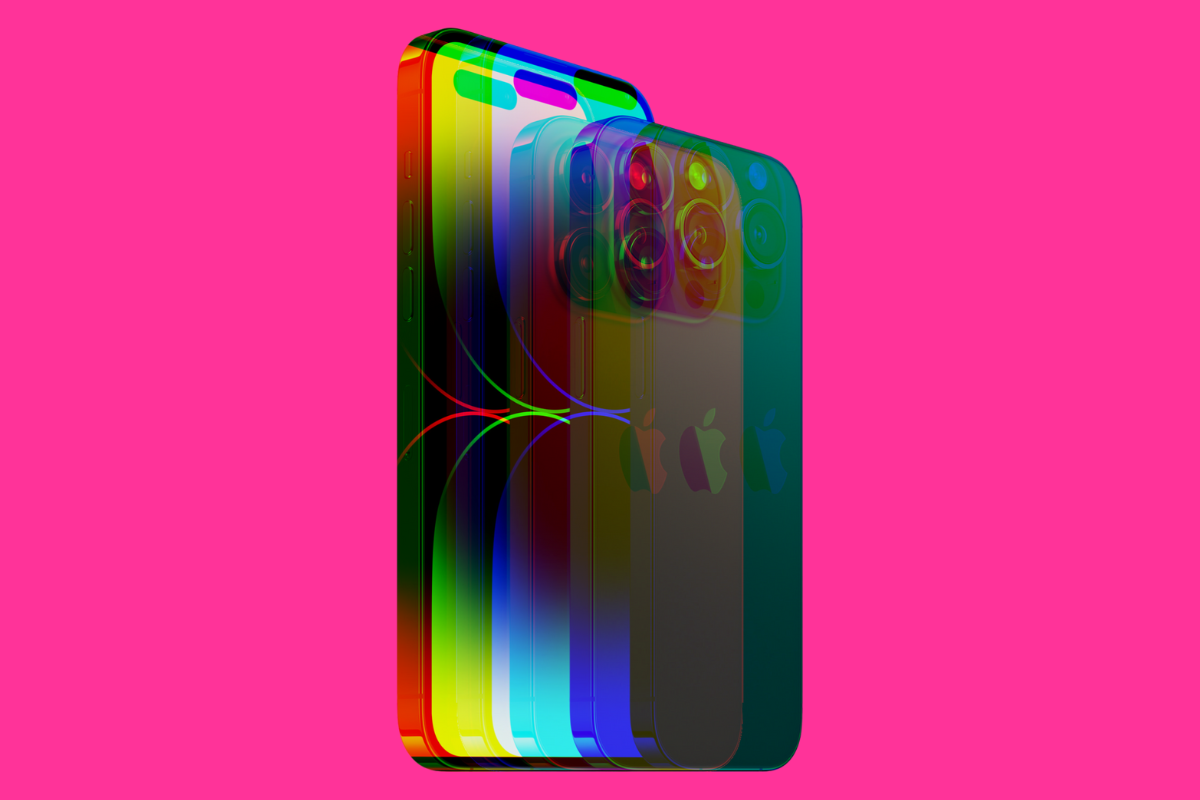
В серии iPhone 14 Apple представила одно из первых физических изменений в дизайне iPhone с момента выпуска iPhone X. Динамический остров, новая технология Apple, резко изменила внешний вид моделей Apple Pro и Pro Max, добавив новые функции и, вообще говоря, сделав вырез более полезным.
Apple также обновила модули камер Pro и Pro Max, улучшив их возможности масштабирования и общую производительность при слабом освещении. iPhone 14 и iPhone 14 Plus не привлекли особого внимания к изменениям — вы получаете небольшие обновления камеры и больше оперативной памяти. Но оба телефона выглядят идентично тому, что было раньше.
В этом отношении серия iPhone 14 была немного дополнительной. Если вы сейчас используете iPhone 13, ни один из телефонов не стоит обновлять. Но если вы в настоящее время используете iPhone 11 или iPhone 12 (или более раннюю версию), аргументы в пользу любой из моделей Apple iPhone 14 очень веские, особенно Pro и Pro Max.
Дополнительные ресурсы:
- iPhone 14: полное руководство на 2022 год — Plus, Pro и Pro Max
- iPhone 14 Plus ПОЛУЧИЛ НЕУДАЧУ — вот почему…
- Обзор iPhone 14: ЗА и ПРОТИВ — стоит ли?
- Обзор iPhone 14 Pro Max: на 100% заслуживает шумихи?
- Насколько велик iPhone 14 Pro Max? Размер и размеры Подробные…
- Аккумулятор iPhone 14 Plus: насколько большой и как долго?
- Цвета iPhone 14: подробности всех новых оттенков
- iPhone 14 Pro и iPhone 14 Pro Max: чем они отличаются?
- Стоит ли покупать iPhone 14? Да, но только для определенных пользователей…
- iPhone 14 против iPhone 14 Plus: как они сравниваются?
- iPhone 14 против iPhone 14 Pro: чем они отличаются
И если вы хотите приобрести iPhone 14, обязательно ознакомьтесь со всеми последние предложения для iPhone 14 и iPhone 14 Pro Max.
Часто задаваемые вопросы об истории iPhone
Каким был первый айфон?
Первый iPhone был выпущен 29 июня 2007 года. Он назывался iPhone, и на нем работала рудиментарная версия того, что впоследствии стало платформой Apple iOS. На момент запуска практически не было доступных приложений, а телефон поставлялся с очень простым процессором.
Какой самый лучший iPhone?
Лучший айфон обычно тот, который вы можете себе позволить. В настоящее время Apple выпускает целый ряд iPhone, и все они нацелены на разные типы пользователей. Pro и Pro Max — лучшие модели с лучшими камерами, но модели Apple начального уровня — iPhone 14 — по-прежнему являются великолепными телефонами, которые идеально подходят для 99.9% пользователей.
Кто изобрел айфон?
iPhone был изобретен Apple под руководством Стив Джобс
при ключевом участии Скотта Форстолла, человека, стоящего за командой Apple iPod, и Джони Айва, главного дизайнера Джобса во время его пребывания в должности.
Хотите сэкономить на следующем iPhone? Ознакомьтесь с нашим руководством по покупке восстановленных iPhone — Можно сэкономить до 50%!
Ричард Гудвин
Ричард Гудвин работает техническим журналистом более 10 лет. Он редактор и владелец KnowYourMobile.

Каждая новая модель телефона Apple отличается новыми доработками и функциями поэтому интересно их сравнивать. Мы собрали всю линейку популярных гаджетов — Айфоны все модели фото и цены ЗДЕСЬ!
Оглавление
- 1 Ранние модели айфонов по порядку
- 1.1 Apple iPhone 3GS — 5400 ₽
- 1.2 Apple iPhone 4 16 Гб — от 7499 ₽
- 1.3 Apple iPhone 4S — 6999 ₽
- 1.4 Apple iPhone — 5 5990 ₽
- 1.5 Apple iPhone — 5c 5990 ₽
- 1.6 Apple iPhone 5s — 5990 ₽
- 2 Фото всех моделей айфона
- 2.1 Apple iPhone 6 16 ГБ — от 7499 ₽
- 2.2 iPhone 6S 16Gb — от 12990 ₽
- 2.3 iPhone 6S 32Gb — от 15990 ₽
- 2.4 iPhone 6S 64Gb — от 17990 ₽
- 2.5 iPhone 6s Plus 16Gb — 17990 ₽
- 2.6 iPhone 6s Plus 32Gb — 17 990 ₽
- 2.7 iPhone 6s Plus 64Gb — 19 990 ₽
- 2.8 iPhone 6s Plus 128Gb — от 19 997 ₽
- 2.9 iPhone SE 16Gb — 9 990 ₽
- 2.10 iPhone SE 32Gb — 14 990 ₽
- 2.11 iPhone SE 64Gb — 35500 ₽
- 2.12 iPhone SE 128Gb — 20540 ₽ и iPhone SE 128Gb (2020) 37450 Р
- 2.13 iPhone 7 32Gb — 24500 ₽
- 2.14 iPhone 7 128Gb — 28990 ₽
- 2.15 iPhone 7 256Gb — 32950 ₽
- 2.16 iPhone 7 Plus 32Gb — 31 490 ₽
- 2.17 iPhone 7 Plus 128Gb — 37 990 ₽
- 2.18 iPhone 7 Plus 256Gb — 37 990 ₽
- 2.19 iPhone 8 64Gb — 30 990 ₽
- 2.20 iPhone 8 128 Gb — 36580 P
- 2.21 iPhone 8 256Gb — 41 920 ₽
- 2.22 iPhone 8 Plus 64Gb — 38 090 ₽
- 2.23 iPone 8Pius 128 Gb — 38990 P
- 2.24 iPhone 8 Plus 256Gb — 49 920 ₽
- 2.25 iPhone Xs 64GB — 52 990 ₽
- 2.26 iPhone Xs 256GB — 57 800 ₽
- 2.27 iPhone Xs 512GB — 58 990 ₽
- 2.28 iPhone Xs Max 64GB — 50 990 ₽
- 2.29 iPhone Xs Max 256GB — 51 990 ₽
- 2.30 iPhone Xs Max 512GB — 55 990 ₽
- 2.31 iPhone Xr 64GB — 39 990 ₽
- 2.32 iPhone Xr 128GB — 46 750 ₽
- 2.33 iPhone Xr 256GB — 51 990 ₽
- 2.34 iPhone X 64Gb — 49 990 ₽
- 2.35 iPhone X 256Gb — 51 990 ₽
- 2.36 Apple iPhone 11 64 ГБ — 52100 ₽
- 2.37 Apple iPhone 11 128GB — 64990 ₽
- 2.38 Apple iPhone 11 256GB — 69990 ₽
- 2.39 iPhone 11 Pro 64 Гб — 75900 ₽
- 2.40 iPhone 11 Pro 256 Гб — 86390 ₽
- 2.41 Apple iPhone 11 Pro 512GB — 115490 ₽
- 2.42 iPhone 11 Pro Max 64 Гб — 79990 ₽
- 2.43 Apple iPhone 11 Pro Max 256GB — 91790 ₽
- 2.44 Apple iPhone SE (2020) 64GB — 39990 ₽
- 2.45 Apple iPhone SE (2020) 128GB — 44990 ₽
- 2.46 Apple iPhone SE (2020) 256GB — 53990 ₽
- 3 Бюджет
Ранние модели айфонов по порядку
В далеком 2007 году компания Apple представила свой первый iPhone. Но даже по меркам того времени прорывом его было назвать трудно. В следующем году мир увидит iPhone 3G и годом позже 3Gs с обновленной ОС, вследствие чего добавятся новые функции: поддержка A-GPS, камера с автофокусом и видеосъемка, HSDPA.
В 2010 году на рынок выходит iPhone 4, с ним все узнают, что такое дисплей с высокой плотностью пикселей, этот аппарат уже оснащен фронтальной камерой.
На следующий год Apple выпускает доработанную версию и называет ее iPhone 4S. Улучшенный процессор и iOS 5 дают гаджету большую производительность. Появляются возможности раздачи Wi-Fi и съемки FullHD видео а главное, голосовой помощник Сири.
Айфоны 5 и 5S обладают экранами диагональю 3.5 дюймов. Последняя модель айфона имеет сканер отпечатков пальцев. Долгое время они были самыми топовыми смартфонами, но сейчас эти модели уже сняты с производства, их можно приобрести только в восстановленных Б/У версиях.
Apple iPhone 3GS — 5400 ₽
 Экран: 3.5, 480×320 Память: 16 ГБ, слот для карты micro SD Hardware:0.6 ГГц, оперативка 0.2 ГБ Корпус:135 г, толщина 12 мм
Экран: 3.5, 480×320 Память: 16 ГБ, слот для карты micro SD Hardware:0.6 ГГц, оперативка 0.2 ГБ Корпус:135 г, толщина 12 мм
Apple iPhone 4 16 Гб — от 7499 ₽

Экран: 4.7, 1334х750 Камера: fullHD 60 к/с Память: 16 ГБ, слот для карты отсутствует Hardware:2 ядра, 1.4 ГГц, оперативка 1 ГБ Аккумулятор: 1810 мАч Корпус:129 г, толщина 7 мм
Apple iPhone 4S — 6999 ₽

Смартфон с iOS 5, экран 3.5″, разрешение 960×640, камера 8 МП, автофокус, память 32 ГБ, без слота для карт памяти, 3G, Wi-Fi, Bluetooth, вес 140 г, ШxВxТ 58.60×115.20×9.30 мм
Apple iPhone — 5 5990 ₽

Экран:4, 1136×640 Память:16 ГБ, слот для карты отсутствует Hardware:2 ядра, 1.3 ГГц, оперативка 1 ГБ Аккумулятор:1570 мАч Корпус:112 г, толщина 8 мм
Apple iPhone — 5c 5990 ₽

Память:16 ГБ, слот для карты отсутствует Hardware:2 ядра, 1.3 ГГц, оперативка 1 ГБ Аккумулятор:1507 мАч Корпус:132 г, толщина 9 мм
Apple iPhone 5s — 5990 ₽

Экран:4, 1136×640 Память:16 ГБ, слот для карты отсутствует Hardware:2 ядра, 1.3 ГГц, оперативка 1 ГБ Аккумулятор:1570 мАч Корпус:112 г, толщина 8 мм
Фото всех моделей айфона
С 2014 года Apple начинает выпускать свои первые «лопаты». Модели шестого поколения оснащены экраном 4.7 дюйма, не хилым процессором и хорошей камерой. Надежные и производительные модели, по порядку убывания соответствуют своим ценам.
Apple iPhone 6 16 ГБ — от 7499 ₽
Представитель девятого поколения iPhone, выпущенный осенью 2015 года. Как и предшествующая модель без индекса S, имеет 4,7″ экран с разрешением 1334х750, алюминиевый корпус и сенсор отпечатка пальца. Корпус получил новый вариант расцветки Rose Gold и стал несколько жёстче, а экран обзавёлся «трёхмерным» сенсором, распознающим прикосновения. «Начинка» смартфона Apple iPhone 6S также была обновлена для увеличения производительности. А вот встроенной памяти в данной модели немного — всего 16 ГБ. Также стоит упомянуть высококачественную основную 12-Мп камеру и фронтальный «глазок» на 5 Мп, роль вспышки для которого играет дисплей.
iPhone 6S 16Gb — от 12990 ₽

- Диагональ экрана: 4,7 дюйма
- Разрешение экрана: 1334×750
- Вес: 143 г
- Количество SIM-карт: 1
- Процессор: Apple A9
- Объем памяти: 16 Гб
- Объем ОЗУ: 2 Гб
- Емкость аккумулятора: 1715 мАч
- Камера: 12 МП
- Поддержка карт памяти: нет
- Поддержка сетей 4G: есть
iPhone 6S 32Gb — от 15990 ₽

- Диагональ экрана: 4,7 дюйма
- Разрешение экрана: 1334×750
- Вес: 143 г
- Количество SIM-карт: 1
- Процессор: Apple A9
- Объем памяти: 32 Гб
- Объем ОЗУ: 2 Гб
- Емкость аккумулятора: 1715 мАч
- Камера: 12 МП
- Поддержка карт памяти: нет
- Поддержка сетей 4G: есть
iPhone 6S 64Gb — от 17990 ₽

- Диагональ экрана: 4,7 дюйма
- Разрешение экрана: 1334×750
- Вес: 143 г
- Количество SIM-карт: 1
- Процессор: Apple A9
- Объем памяти: 64 Гб
- Объем ОЗУ: 2 Гб
- Емкость аккумулятора: 1715 мАч
- Камера: 12 МП
- Поддержка карт памяти: нет
- Поддержка сетей 4G: есть
iPhone 6s Plus 16Gb — 17990 ₽
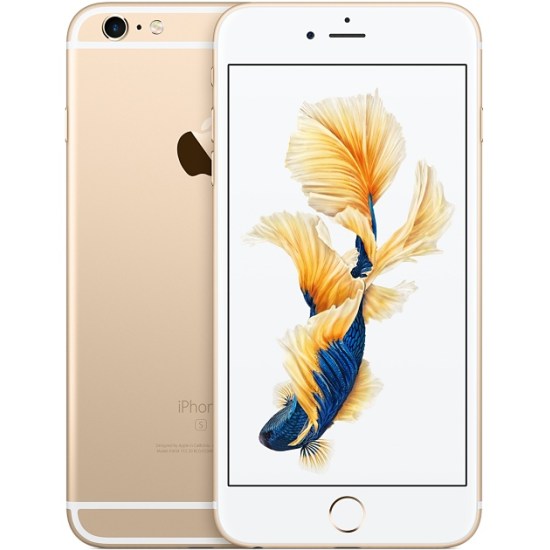
- Диагональ экрана: 5,5 дюйма
- Разрешение экрана: 1920×1080
- Вес: 192 г
- Количество SIM-карт: 1
- Процессор: Apple A9
- Объем памяти: 16 Гб
- Объем ОЗУ: 2 Гб
- Емкость аккумулятора: 2750 мАч
- Камера: 12 МП
- Поддержка карт памяти: нет
- Поддержка сетей 4G: есть
iPhone 6s Plus 32Gb — 17 990 ₽

- Диагональ экрана: 5,5 дюйма
- Разрешение экрана: 1920×1080
- Вес: 192 г
- Количество SIM-карт: 1
- Процессор: Apple A9
- Объем памяти: 32 Гб
- Объем ОЗУ: 2 Гб
- Емкость аккумулятора: 2750 мАч
- Камера: 12 МП
- Поддержка карт памяти: нет
- Поддержка сетей 4G: есть
iPhone 6s Plus 64Gb — 19 990 ₽

- Диагональ экрана: 5,5 дюйма
- Разрешение экрана: 1920×1080
- Вес: 192 г
- Количество SIM-карт: 1
- Процессор: Apple A9
- Объем памяти: 64 Гб
- Объем ОЗУ: 2 Гб
- Емкость аккумулятора: 2750 мАч
- Камера: 12 МП
- Поддержка карт памяти: нет
- Поддержка сетей 4G: есть
iPhone 6s Plus 128Gb — от 19 997 ₽

- Диагональ экрана: 5,5 дюйма
- Разрешение экрана: 1920×1080
- Вес: 192 г
- Количество SIM-карт: 1
- Процессор: Apple A9
- Объем памяти: 128 Гб
- Объем ОЗУ: 2 Гб
- Емкость аккумулятора: 2750 мАч
- Камера: 12 МП
- Поддержка карт памяти: нет
- Поддержка сетей 4G: есть
iPhone SE 16Gb — 9 990 ₽
Как и все гаджеты линейки SE, данная модель внешне идентична iPhone 5S и выпущена в расчёте на любителей «классики» и владельцев аксессуаров под оригинальные 5S. И как и во всех SE, «классическая» внешность сочетается с солидной современной начинкой, не уступающей более крупным смартфонам от Apple. Основой этой начинки в смартфоне Apple iPhone SE является чип A9 и 2 ГБ оперативной памяти, «позаимствованные» у iPhone 6s.
Что касается встроенной памяти, то данная модель несёт 32 ГБ и с 2017 года официально является младшей в линейке (до 2017 года минимумом было 16 ГБ, однако 16-ГБ версия была снята с производства с выходом данной модели). Модуль основной камеры примечателен не столько 12-Мп сенсором, сколько высоким качеством изображения и продвинутыми возможностями — вроде видеозаписи 4K с возможностью снимать фото прямо во время съёмки, или замедленной съёмки 240 fps в разрешении 720p. Аппарат работает от аккумулятора на 1642 мАч, обеспечивающего до 13 ч в режиме веб-серфинга.
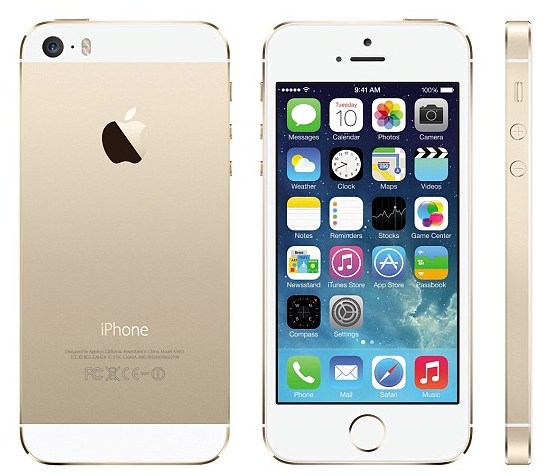
- Диагональ экрана: 4 дюйма
- Разрешение экрана: 1136х640
- Вес: 113 г
- Количество SIM-карт: 1
- Процессор: Apple A9
- Объем памяти: 16 Гб
- Объем ОЗУ: 2 Гб
- Емкость аккумулятора: 1624 мАч
- Камера: 12 МП
- Поддержка карт памяти: нет
- Поддержка сетей 4G: есть
iPhone SE 32Gb — 14 990 ₽

- Диагональ экрана: 4 дюйма
- Разрешение экрана: 1136х640
- Вес: 113 г
- Количество SIM-карт: 1
- Процессор: Apple A9
- Объем памяти: 32 Гб
- Объем ОЗУ: 2 Гб
- Емкость аккумулятора: 1624 мАч
- Камера: 12 МП
- Поддержка карт памяти: нет
- Поддержка сетей 4G: есть
iPhone SE 64Gb — 35500 ₽

- Диагональ экрана: 4 дюйма
- Разрешение экрана: 1136х640
- Вес: 113 г
- Количество SIM-карт: 1
- Процессор: Apple A9
- Объем памяти: 64 Гб
- Объем ОЗУ: 2 Гб
- Емкость аккумулятора: 1624 мАч
- Камера: 12 МП
- Поддержка карт памяти: нет
- Поддержка сетей 4G: есть
iPhone SE 128Gb — 20540 ₽ и iPhone SE 128Gb (2020) 37450 Р

- Диагональ экрана: 4 дюйма
- Разрешение экрана: 1136х640
- Вес: 113 г
- Количество SIM-карт: 1
- Процессор: Apple A9
- Объем памяти: 128 Гб
- Объем ОЗУ: 2 Гб
- Емкость аккумулятора: 1624 мАч
- Камера: 12 МП
- Поддержка карт памяти: нет
- Поддержка сетей 4G: есть
Гаджеты седьмого поколения не боятся воды и влаги. Также выдают стереозвук. Дизайн – «больная» тема для айфон. Все модели минимально отличаются друг от друга по дизайну и цене.
iPhone 7 32Gb — 24500 ₽
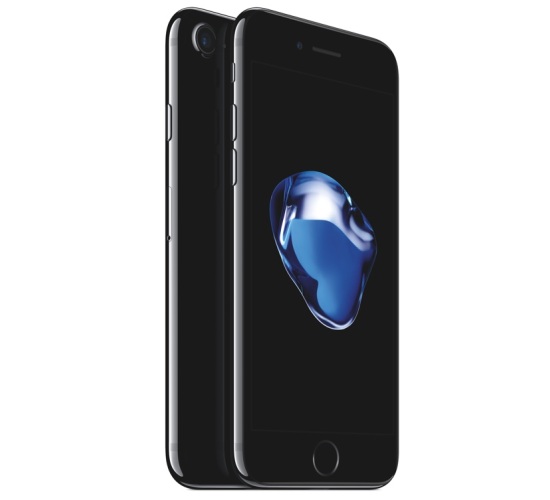
- Диагональ экрана: 4,7 дюйма
- Разрешение экрана: 1334×750
- Вес: 138 г
- Количество SIM-карт: 1
- Процессор: Apple A10 Fusion
- Объем памяти: 32 Гб
- Объем ОЗУ: 2 Гб
- Емкость аккумулятора: 1960 мАч
- Камера: 12 МП
- Поддержка карт памяти: нет
- Поддержка сетей 4G: есть
iPhone 7 128Gb — 28990 ₽ 
- Диагональ экрана: 4,7 дюйма
- Разрешение экрана: 1334×750
- Вес: 138 г
- Количество SIM-карт: 1
- Процессор: Apple A10 Fusion
- Объем памяти: 128 Гб
- Объем ОЗУ: 2 Гб
- Емкость аккумулятора: 1960 мАч
- Камера: 12 МП
- Поддержка карт памяти: нет
- Поддержка сетей 4G: есть
iPhone 7 256Gb — 32950 ₽

- Диагональ экрана: 4,7 дюйма
- Разрешение экрана: 1334×750
- Вес: 138 г
- Количество SIM-карт: 1
- Процессор: Apple A10 Fusion
- Объем памяти: 256 Гб
- Объем ОЗУ: 2 Гб
- Емкость аккумулятора: 1960 мАч
- Камера: 12 МП
- Поддержка карт памяти: нет
- Поддержка сетей 4G: есть
iPhone 7 Plus 32Gb — 31 490 ₽
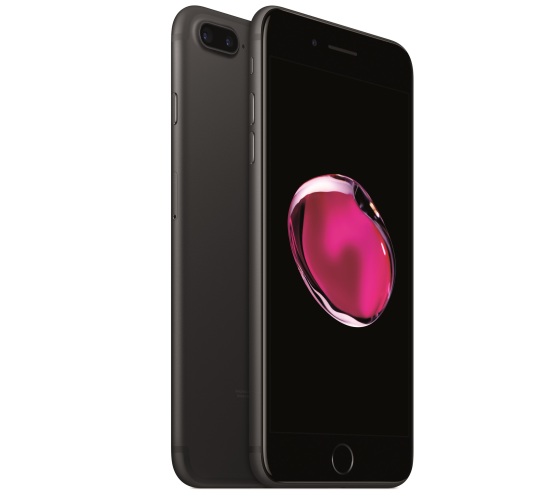
- Диагональ экрана: 5,5 дюйма
- Разрешение экрана: 1920×1080
- Вес: 188 г
- Количество SIM-карт: 1
- Процессор: Apple A10 Fusion
- Объем памяти: 32 Гб
- Объем ОЗУ: 3 Гб
- Емкость аккумулятора: 2900 мАч
- Камера: 12 МП
- Поддержка карт памяти: нет
- Поддержка сетей 4G: есть
iPhone 7 Plus 128Gb — 37 990 ₽

- Диагональ экрана: 5,5 дюйма
- Разрешение экрана: 1920×1080
- Вес: 188 г
- Количество SIM-карт: 1
- Процессор: Apple A10 Fusion
- Объем памяти: 128 Гб
- Объем ОЗУ: 3 Гб
- Емкость аккумулятора: 2900 мАч
- Камера: 12 МП
- Поддержка карт памяти: нет
- Поддержка сетей 4G: есть
iPhone 7 Plus 256Gb — 37 990 ₽

- Диагональ экрана: 5,5 дюйма
- Разрешение экрана: 1920×1080
- Вес: 188 г
- Количество SIM-карт: 1
- Процессор: Apple A10 Fusion
- Объем памяти: 256 Гб
- Объем ОЗУ: 3 Гб
- Емкость аккумулятора: 2900 мАч
- Камера: 12 МП
- Поддержка карт памяти: нет
- Поддержка сетей 4G: есть
IPhone 8 намного производительней, мощней и функциональней своих предшественников. Здесь появились возможности беспроводной и быстрой зарядки. Цена вопроса на сегодняшний день.
iPhone 8 64Gb — 30 990 ₽
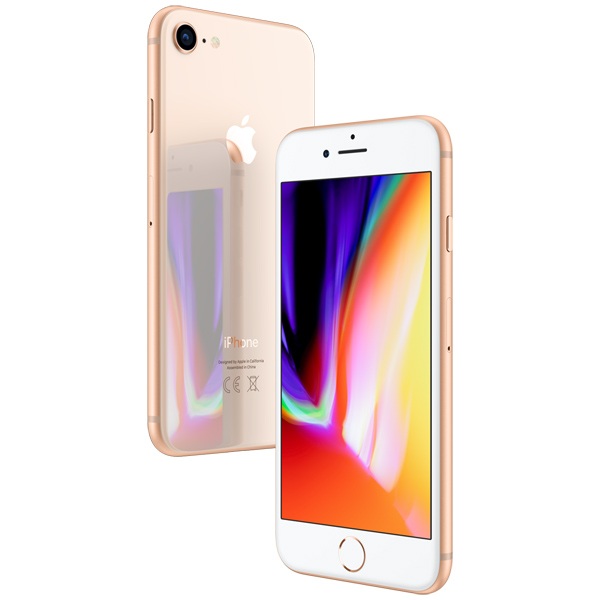
- Диагональ экрана: 4,7 дюйма
- Разрешение экрана: 1334×750
- Вес: 148 г
- Количество SIM-карт: 1
- Процессор: Apple A11 Bionic
- Объем памяти: 64 Гб
- Объем ОЗУ: 2 Гб
- Емкость аккумулятора: 1 821 мАч
- Камера: 12 МП
- Поддержка карт памяти: нет
- Поддержка сетей 4G: есть
iPhone 8 128 Gb — 36580 P
iPhone 8 256Gb — 41 920 ₽

- Диагональ экрана: 4,7 дюйма
- Разрешение экрана: 1334×750
- Вес: 148 г
- Количество SIM-карт: 1
- Процессор: Apple A11 Bionic
- Объем памяти: 256 Гб
- Объем ОЗУ: 2 Гб
- Емкость аккумулятора: 1 821 мАч
- Камера: 12 МП
- Поддержка карт памяти: нет
- Поддержка сетей 4G: есть
iPhone 8 Plus 64Gb — 38 090 ₽
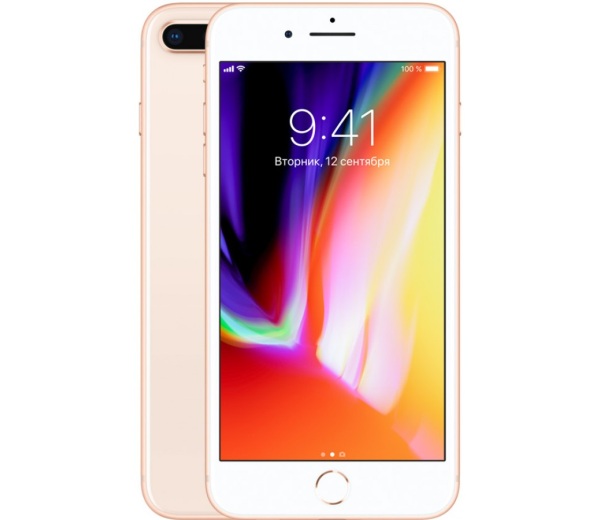
- Диагональ экрана: 5,5 дюйма
- Разрешение экрана: 1920×1080
- Вес: 202 г
- Количество SIM-карт: 1
- Процессор: Apple A11 Bionic
- Объем памяти: 64 Гб
- Объем ОЗУ: 3 Гб
- Емкость аккумулятора: 2689 мАч
- Камера: 12/12 МП
- Поддержка карт памяти: нет
- Поддержка сетей 4G: есть
iPone 8Pius 128 Gb — 38990 P
iPhone 8 Plus 256Gb — 49 920 ₽

- Диагональ экрана: 5,5 дюйма
- Разрешение экрана: 1920×1080
- Вес: 202 г
- Количество SIM-карт: 1
- Процессор: Apple A11 Bionic
- Объем памяти: 256 Гб
- Объем ОЗУ: 3 Гб
- Емкость аккумулятора: 2689 мАч
- Камера: 12/12 МП
- Поддержка карт памяти: нет
- Поддержка сетей 4G: есть
Iphone X оснащен крутым и производительным 4-ядерным процессором А11 Bionic. Дисплей 5.8 дюйма. Камеры 12 МП. Съемка 4К видео. Высококачественная цветопередача. Дальше-больше!
iPhone Xs 64GB — 52 990 ₽

- Диагональ экрана: 5,8 дюйма
- Разрешение экрана: 2436×1125
- Вес: 177 г
- Количество SIM-карт: 2 (eSIM)
- Процессор: Apple A12 Bionic
- Объем памяти: 64 Гб
- Объем ОЗУ: 4 Гб
- Емкость аккумулятора: 2659 мАч
- Тыловая камера: двойная 12/12 МП
- Фронтальная камера: 7 МП
- Поддержка карт памяти: нет
iPhone Xs 256GB — 57 800 ₽

- Диагональ экрана: 5,8 дюйма
- Разрешение экрана: 2436×1125
- Вес: 177 г
- Количество SIM-карт: 2 (eSIM)
- Процессор: Apple A12 Bionic
- Объем памяти: 256 Гб
- Объем ОЗУ: 4 Гб
- Емкость аккумулятора: 2659 мАч
- Тыловая камера: двойная 12/12 МП
- Фронтальная камера: 7 МП
- Поддержка карт памяти: нет
iPhone Xs 512GB — 58 990 ₽

- Диагональ экрана: 5,8 дюйма
- Разрешение экрана: 2436×1125
- Вес: 177 г
- Количество SIM-карт: 2 (eSIM)
- Процессор: Apple A12 Bionic
- Объем памяти: 512 Гб
- Объем ОЗУ: 4 Гб
- Емкость аккумулятора: 2659 мАч
- Тыловая камера: двойная 12/12 МП
- Фронтальная камера: 7 МП
- Поддержка карт памяти: нет
iPhone Xs Max 64GB — 50 990 ₽

- Диагональ экрана: 6,5 дюйма
- Разрешение экрана: 2688×1242
- Вес: 208 г
- Количество SIM-карт: 2 (eSIM)
- Процессор: Apple A12 Bionic
- Объем памяти: 64 Гб
- Объем ОЗУ: 4 Гб
- Емкость аккумулятора: 3179 мАч
- Тыловая камера: двойная 12/12 МП
- Фронтальная камера: 7 МП
- Поддержка карт памяти: нет
iPhone Xs Max 256GB — 51 990 ₽

- Диагональ экрана: 6,5 дюйма
- Разрешение экрана: 2688×1242
- Вес: 208 г
- Количество SIM-карт: 2 (eSIM)
- Процессор: Apple A12 Bionic
- Объем памяти: 256 Гб
- Объем ОЗУ: 4 Гб
- Емкость аккумулятора: 3179 мАч
- Тыловая камера: двойная 12/12 МП
- Фронтальная камера: 7 МП
- Поддержка карт памяти: нет
iPhone Xs Max 512GB — 55 990 ₽

- Диагональ экрана: 6,5 дюйма
- Разрешение экрана: 2688×1242
- Вес: 208 г
- Количество SIM-карт: 2 (eSIM)
- Процессор: Apple A12 Bionic
- Объем памяти: 512 Гб
- Объем ОЗУ: 4 Гб
- Емкость аккумулятора: 3179 мАч
- Тыловая камера: двойная 12/12 МП
- Фронтальная камера: 7 МП
- Поддержка карт памяти: нет
iPhone Xr 64GB — 39 990 ₽ 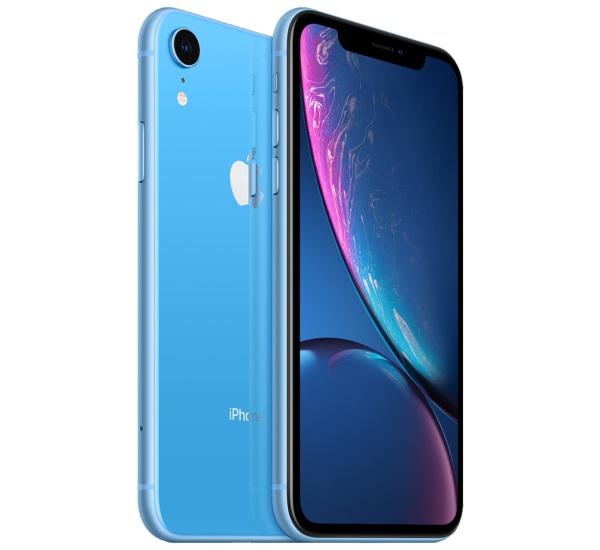
- Диагональ экрана: 6,1 дюйма
- Разрешение экрана: 1792×828
- Вес: 194 г
- Количество SIM-карт: 2 (eSIM)
- Процессор: Apple A12 Bionic
- Объем памяти: 64 Гб
- Объем ОЗУ: 3 Гб
- Емкость аккумулятора: 2942 мАч
- Тыловая камера: 12 МП
- Фронтальная камера: 7 МП
- Поддержка карт памяти: нет
iPhone Xr 128GB — 46 750 ₽

- Диагональ экрана: 6,1 дюйма
- Разрешение экрана: 1792×828
- Вес: 194 г
- Количество SIM-карт: 2 (eSIM)
- Процессор: Apple A12 Bionic
- Объем памяти: 128 Гб
- Объем ОЗУ: 3 Гб
- Емкость аккумулятора: 2942 мАч
- Тыловая камера: 12 МП
- Фронтальная камера: 7 МП
- Поддержка карт памяти: нет
iPhone Xr 256GB — 51 990 ₽

- Диагональ экрана: 6,1 дюйма
- Разрешение экрана: 1792×828
- Вес: 194 г
- Количество SIM-карт: 2 (eSIM)
- Процессор: Apple A12 Bionic
- Объем памяти: 256 Гб
- Объем ОЗУ: 3 Гб
- Емкость аккумулятора: 2942 мАч
- Тыловая камера: 12 МП
- Фронтальная камера: 7 МП
- Поддержка карт памяти: нет
iPhone X 64Gb — 49 990 ₽
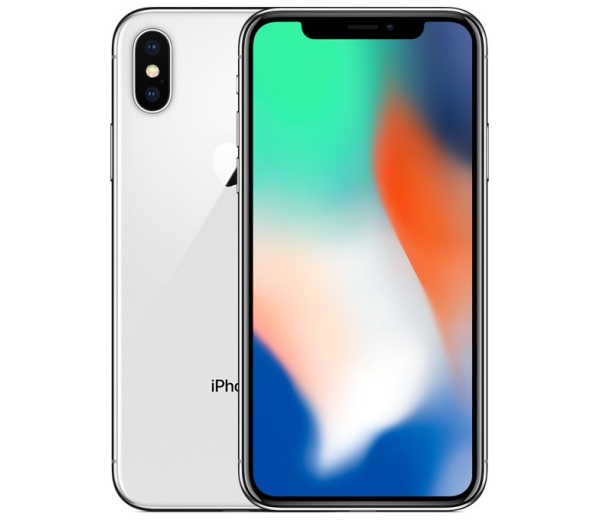
- Диагональ экрана: 5,8 дюйма
- Разрешение: 2436×1125
- Вес: 174 г
- Количество SIM-карт: 1
- Процессор: Apple A11 Bionic
- Объем памяти: 64 Гб
- Объем ОЗУ: 3 Гб
- Емкость аккумулятора: 2716 мАч
- Тыловая камера: двойная 12/12 МП
- Фронтальная камера: 7 МП
- Поддержка карт памяти: нет
iPhone X 256Gb — 51 990 ₽

- Диагональ экрана: 5,8 дюйма
- Разрешение: 2436×1125
- Вес: 174 г
- Количество SIM-карт: 1
- Процессор: Apple A11 Bionic
- Объем памяти: 256 Гб
- Объем ОЗУ: 3 Гб
- Емкость аккумулятора: 2716 мАч
- Тыловая камера: двойная 12/12 МП
- Фронтальная камера: 7 МП
- Поддержка карт памяти: нет
Apple iPhone 11 64 ГБ — 52100 ₽
- смартфон с iOS 13
- поддержка двух SIM-карт (nano SIM+eSIM)
- экран 6.1″, разрешение 1792×828
- двойная камера 12 МП/12 МП, автофокус
- память 64 ГБ, без слота для карт памяти
- 3G, 4G LTE, LTE-A, Wi-Fi, Bluetooth, NFC
- вес 194 г, ШxВxТ 75.70×150.90×8.30 мм
Apple iPhone 11 128GB — 64990 ₽
- смартфон с iOS 13
- поддержка двух SIM-карт (nano SIM+eSIM)
- экран 6.1″, разрешение 1792×828
- двойная камера 12 МП/12 МП, автофокус
- память 128 ГБ, без слота для карт памяти
- 3G, 4G LTE, LTE-A, Wi-Fi, Bluetooth, NFC
- вес 194 г, ШxВxТ 75.70×150.90×8.30 мм
Apple iPhone 11 256GB — 69990 ₽
- смартфон с iOS 13
- поддержка двух SIM-карт (nano SIM+eSIM)
- экран 6.1″, разрешение 1792×828
- двойная камера 12 МП/12 МП, автофокус
- память 256 ГБ, без слота для карт памяти
- 3G, 4G LTE, LTE-A, Wi-Fi, Bluetooth, NFC
- вес 194 г, ШxВxТ 75.70×150.90×8.30 мм
iPhone 11 Pro 64 Гб — 75900 ₽
- смартфон с iOS 13
- поддержка двух SIM-карт (nano SIM+eSIM)
- экран 5.8″, разрешение 2436×1125
- три камеры 12 МП/12 МП/12 МП, автофокус
- память 64 ГБ, без слота для карт памяти
- 3G, 4G LTE, LTE-A, Wi-Fi, Bluetooth, NFC
- вес 188 г, ШxВxТ 71.40x144x8.10 мм
iPhone 11 Pro 256 Гб — 86390 ₽
- смартфон с iOS 13
- поддержка двух SIM-карт (nano SIM+eSIM)
- экран 5.8″, разрешение 2436×1125
- три камеры 12 МП/12 МП/12 МП, автофокус
- память 256 ГБ, без слота для карт памяти
- 3G, 4G LTE, LTE-A, Wi-Fi, Bluetooth, NFC
- вес 188 г, ШxВxТ 71.40x144x8.10 мм
Apple iPhone 11 Pro 512GB — 115490 ₽
- смартфон с iOS 13
- поддержка двух SIM-карт (nano SIM+eSIM)
- экран 6.5″, разрешение 2688×1242
- три камеры 12 МП/12 МП/12 МП, автофокус
- память 512 ГБ, без слота для карт памяти
- 3G, 4G LTE, LTE-A, Wi-Fi, Bluetooth, NFC
- вес 226 г, ШxВxТ 77.80x158x8.10 мм
iPhone 11 Pro Max 64 Гб — 79990 ₽
- смартфон с iOS 13
- поддержка двух SIM-карт (nano SIM+eSIM)
- экран 6.5″, разрешение 2688×1242
- три камеры 12 МП/12 МП/12 МП, автофокус
- память 64 ГБ, без слота для карт памяти
- 3G, 4G LTE, LTE-A, Wi-Fi, Bluetooth, NFC
- вес 226 г, ШxВxТ 77.80x158x8.10 мм
Apple iPhone 11 Pro Max 256GB — 91790 ₽
- смартфон с iOS 13
- поддержка двух SIM-карт (nano SIM+eSIM)
- экран 6.5″, разрешение 2688×1242
- три камеры 12 МП/12 МП/12 МП, автофокус
- память 256 ГБ, без слота для карт памяти
- 3G, 4G LTE, LTE-A, Wi-Fi, Bluetooth, NFC
- вес 226 г, ШxВxТ 77.80x158x8.10 мм
Apple iPhone SE (2020) 64GB — 39990 ₽
- смартфон с iOS 13
- поддержка двух SIM-карт (nano SIM+eSIM)
- экран 4.7″, разрешение 1334×750
- камера 12 МП, автофокус
- память 64 ГБ, без слота для карт памяти
- 3G, 4G LTE, Wi-Fi, Bluetooth, NFC
- аккумулятор 1812 мА⋅ч
- вес 148 г, ШxВxТ 67.30×138.40×7.30 мм
Apple iPhone SE (2020) 128GB — 44990 ₽
- смартфон с iOS 13
- поддержка двух SIM-карт (nano SIM+eSIM)
- экран 4.7″, разрешение 1334×750
- камера 12 МП, автофокус
- память 128 ГБ, без слота для карт памяти
- 3G, 4G LTE, Wi-Fi, Bluetooth, NFC
- объем оперативной памяти 3 ГБ
- вес 148 г, ШxВxТ 67.30×138.40×7.30 мм
Apple iPhone SE (2020) 256GB — 53990 ₽
- смартфон с iOS 13
- поддержка двух SIM-карт (nano SIM+eSIM)
- экран 4.7″, разрешение 1334×750
- камера 12 МП, автофокус
- память 256 ГБ, без слота для карт памяти
- 3G, 4G LTE, Wi-Fi, Bluetooth, NFC
- вес 148 г, ШxВxТ 67.30×138.40×7.30 мм
Бюджет
Не каждому по карману приобрести только что вышедшую модель. Но, можно приобрести б/у аппарат по весьма привлекательной стоимости, или восстановленный годный гаджет.
Читайте далее: Какую старую модель iPhone стоит поменять на iPhone SE (2020) и Когда упадут цены на Айфоны — ЗДЕСЬ!!!
 The front face of an iPhone 14 Pro in Deep Purple | |
| Developer | Apple Inc. |
|---|---|
| Manufacturer | Foxconn, Pegatron, Wistron (contract manufacturers) |
| Type | Smartphone Phablet (only models with 6.7 inch display) |
| Units sold | 2.2 billion (as of November 1, 2018)[1] |
| Operating system | iOS |
| Storage | 64, 128, 256, 512 GB or 1 TB[a] flash memory[2] |
| Sound |
|
| Power | Built-in rechargeable lithium-ion battery |
| Online services |
|
| Related |
|
| Website | apple.com/iphone/ |
The iPhone is a line of smartphones designed and marketed by Apple Inc. These devices use Apple’s iOS mobile operating system. The first-generation iPhone was announced by then-Apple CEO Steve Jobs on January 9, 2007. Since then, Apple has annually released new iPhone models and iOS updates. As of November 1, 2018, more than 2.2 billion iPhones had been sold. As of 2022, the iPhone accounts for 15.6% of global smartphone market share.[3]
The iPhone was the first mobile phone with multi-touch technology.[4] Since the iPhone’s launch, it gained larger screen sizes, video-recording, waterproofing, and many accessibility features. Up to iPhone 8 and 8 Plus, iPhones had a single button on the front panel with the Touch ID fingerprint sensor. Since iPhone X, iPhone models have switched to a nearly bezel-less front screen design with Face ID facial recognition, and app switching activated by gestures. Touch ID is still used for the budget iPhone SE series.
The iPhone is one of the two largest smartphone platforms in the world alongside Android, and is a large part of the luxury market. The iPhone has generated large profits for Apple, making it one of the world’s most valuable publicly traded companies. The first-generation iPhone was described as a «revolution» for the mobile phone industry and subsequent models have also garnered praise.[5] The iPhone has been credited with popularizing the smartphone and slate form factor, and with creating a large market for smartphone apps, or «app economy». As of January 2017, Apple’s App Store contained more than 2.2 million applications for the iPhone.
History
Development of an Apple smartphone began in 2004, when Apple started to gather a team of 1,000 employees led by hardware engineer Tony Fadell, software engineer Scott Forstall, and design officer Jony Ive,[6] to work on the highly confidential «Project Purple».[7][8]
Then-Apple CEO Steve Jobs steered the original focus away from a tablet (which was later revisited in the form of the iPad) towards a phone.[9] Apple created the device during a secretive collaboration with Cingular Wireless (later renamed AT&T Mobility) at the time—at an estimated development cost of US$150 million over thirty months.[10] According to Jobs in 1998, the «i» word in «iMac» (and therefore «iPod», «iPhone» and «iPad») stands for internet, individual, instruct, inform, and inspire.[11][12]
Apple rejected the «design by committee» approach that had yielded the Motorola ROKR E1, a largely unsuccessful «iTunes phone» made in collaboration with Motorola. Among other deficiencies, the ROKR E1’s firmware limited storage to only 100 iTunes songs to avoid competing with Apple’s iPod nano.[13][14] Cingular gave Apple the liberty to develop the iPhone’s hardware and software in-house, a rare practice at the time,[15][16] and paid Apple a fraction of its monthly service revenue (until the iPhone 3G),[17] in exchange for four years of exclusive U.S. sales, until 2011.[18]
Jobs unveiled the first-generation iPhone to the public on January 9, 2007, at the Macworld 2007 convention at the Moscone Center in San Francisco.[19] The iPhone incorporated a 3.5-inch multi-touch display with few hardware buttons, and ran the iPhone OS operating system with a touch-friendly interface, then marketed as a version of Mac OS X.[20] It launched on June 29, 2007, at a starting price of US$499 in the United States, and required a two-year contract with AT&T.[21]

Worldwide iPhone availability:
iPhone available since its original release
iPhone available since the release of iPhone 3G
On July 11, 2008, at Apple’s Worldwide Developers Conference (WWDC) 2008, Apple announced the iPhone 3G, and expanded its launch-day availability to twenty-two countries, and it was eventually released in 70 countries and territories.[22][23] The iPhone 3G introduced faster 3G connectivity, and a lower starting price of US$199 (with a two-year AT&T contract).[24] Its successor, the iPhone 3GS, was announced on June 8, 2009, at WWDC 2009, and introduced video recording functionality.[25]
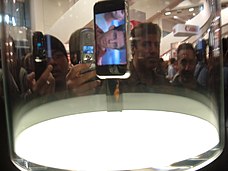
First iPhone on display under glass at the January 2007 Macworld show
The iPhone 4 was announced on June 7, 2010, at WWDC 2010, and introduced a redesigned body incorporating a stainless steel frame and a rear glass panel.[26] At release, the iPhone 4 was marketed as the «world’s thinnest smartphone»;[26] it uses the Apple A4 processor, being the first iPhone to use an Apple custom-designed chip. It introduced the Retina display, having four-times the display resolution of preceding iPhones, and was the highest-resolution smartphone screen at release;[26] a front-facing camera was also introduced, enabling video calling functionality via FaceTime.
Users of the iPhone 4 reported dropped/disconnected telephone calls when holding their phones in a certain way, and this issue was nicknamed «antennagate».[27] In January 2011, as Apple’s exclusivity agreement with AT&T was expiring, Verizon announced that the would be carrying the iPhone 4, with a model compatible with Verizon’s CDMA network releasing on February 10.[28][29]
The iPhone 4S was announced on October 4, 2011, and introduced the Siri virtual assistant, a dual-core A5 processor, and an 8 megapixel camera with 1080p video recording functionality. The iPhone 5 was announced on September 12, 2012, and introduced a larger 4-inch screen, up from the 3.5-inch screen of all previous iPhone models, as well as faster 4G LTE connectivity.[30] It also introduced a thinner and lighter body made of aluminum alloy, and the 30-pin dock connector of previous iPhones was replaced with the new, reversible Lightning connector.[30]
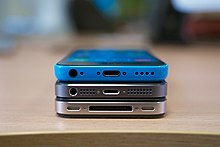
Bottom angle comparison between iPhone 5C (top), iPhone 5s (middle), and iPhone 4S (bottom).
The iPhone 5S and iPhone 5C were announced on September 10, 2013. The iPhone 5S included a 64-bit A7 processor, becoming the first ever 64-bit smartphone;[31] it also introduced the Touch ID fingerprint authentication sensor. The iPhone 5C was a lower-cost device that incorporated hardware from the iPhone 5, into a series of colorful plastic frames.[32]
On September 9, 2014, Apple introduced the iPhone 6 and iPhone 6 Plus, and included significantly larger screens than the iPhone 5S, at 4.7-inch and 5.5-inch respectively; both models also introduced mobile payment technology via Apple Pay.[33] Optical image stabilization was introduced to the 6 Plus’ camera. The Apple Watch was also introduced on the same day, and is a smartwatch that operates in conjunction with a connected iPhone. Some users experienced bending issues from normal use with the iPhone 6 and 6 Plus, particularly on the latter model, and this issue was nicknamed «bendgate».[34]
The iPhone 6S and 6S Plus were introduced on September 9, 2015, and included a more bend-resistant frame made of a stronger aluminum alloy, as well as a higher resolution 12-megapixel main camera capable of 4K video recording.[35] The first-generation iPhone SE was introduced on March 21, 2016, and was a low-cost device that incorporated newer hardware from the iPhone 6S, in the frame of the older iPhone 5S.[36]
The iPhone 7 and 7 Plus were announced on September 7, 2016, which introduced larger camera sensors, IP67-certified water and dust resistance, and a quad-core A10 Fusion processor utilizing big.LITTLE technology;[37] the 3.5mm headphone jack was removed, and was followed by the introduction of the AirPods wireless earbuds.[38] Optical image stabilization was added to the 7’s camera. A second telephoto camera lens was added on the 7 Plus, enabling two-times optical zoom, and «Portrait» photography mode which simulates bokeh in photos.[39]
The iPhone 8, 8 Plus, and iPhone X were announced on September 12, 2017, in Apple’s first event held at the Steve Jobs Theater in Apple Park. All models featured rear glass panel designs akin to the iPhone 4, wireless charging, and a hexa-core A11 Bionic chip with «Neural Engine» AI accelerator hardware. The iPhone X additionally introduced a 5.8-inch OLED «Super Retina» display with a «bezel-less» design, with a higher pixel density and contrast ratio than previous iPhones with LCD displays, and introduced a stronger frame made of stainless steel. It also introduced Face ID facial recognition authentication hardware, in a «notch» screen cutout, in place of Touch ID;[40][41] the home button was removed to make room for additional screen space, replacing it with a gesture-based navigation system.[42] At its US$999 starting price, the iPhone X was the most expensive iPhone at launch.[43]
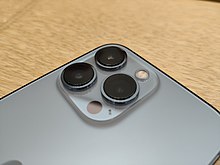
Picture of the cameras on the iPhone 13 Pro. Newer iPhone models have been praised for their camera quality.
The iPhone XR, iPhone XS, and XS Max were announced on September 12, 2018. All models featured the «Smart HDR» computational photography system, and a significantly more powerful «Neural Engine».[44] The XS Max introduced a larger 6.5-inch screen. The iPhone XR included a 6.1-inch LCD «Liquid Retina» display, with a «bezel-less» design similar to the iPhone X, but does not include a second telephoto lens; it was made available in a series of vibrant colors, akin to the iPhone 5C, and was a lower-cost device compared to the iPhone X and XS.[45]
The iPhone 11, 11 Pro, and 11 Pro Max were announced on September 10, 2019. The iPhone 11 was the successor to the iPhone XR, while the iPhone 11 Pro and 11 Pro Max succeeded the iPhone XS and XS Max. All models gained an ultra-wide lens, enabling two-times optical zoom out, as well as larger batteries for longer battery life.[46][47] The second-generation iPhone SE was introduced on April 17, 2020, and was a low-cost device that incorporated newer hardware from the iPhone 11, in the frame of the older iPhone 8, while retaining the home button and the Touch ID sensor.[48]
The iPhone 12, 12 Mini, 12 Pro, and 12 Pro Max were announced via a livestream event on October 13, 2020. All models featured OLED «Super Retina XDR» displays, introduced faster 5G connectivity, and the MagSafe magnetic charging and accessory system; a slimmer flat-edged design was also introduced, which combined with stronger glass-ceramic front glass, added better drop protection compared to previous iPhones.[49][50] The iPhone 12 Mini introduced a smaller 5.4-inch screen, while the 12 Pro and 12 Pro Max had larger screens of 6.1-inch and 6.7-inch respectively. The iPhone 12 Pro and 12 Pro Max additionally added a Lidar sensor for better accuracy in augumented reality (AR) applications.
The iPhone 13, 13 Mini, 13 Pro, and 13 Pro Max were announced via a livestream event on September 14, 2021. All models featured larger camera sensors, larger batteries for longer battery life, and a narrower «notch» screen cutout.[51] The iPhone 13 Pro and 13 Pro Max additionally introduced smoother adaptive 120 Hz refresh rate «ProMotion» technology in its OLED display, and three-times optical zoom in the telephoto lens.[52] The low-cost third-generation iPhone SE was introduced on March 8, 2022, and incorporated the A15 Bionic chip from the iPhone 13, but otherwise retained similar hardware to the second-generation iPhone SE.
The iPhone 14, 14 Plus, 14 Pro, and 14 Pro Max were announced on September 7, 2022. All models introduced satellite phone emergency calling functionality. The iPhone 14 Plus introduced the large 6.7-inch screen size, first seen on the iPhone 12 Pro Max, into a lower-cost device.[53] The iPhone 14 Pro and 14 Pro Max additionally introduced a higher-resolution 48-megapixel main camera, the first increase in megapixel count since the iPhone 6S; it also introduced always-on display technology to the lock screen, and an interactive status bar interface integrated in a redesigned screen cutout, entitled «Dynamic Island».[54]
Production
Up to the iPhone 4, all iPhones and other iOS devices were manufactured by Foxconn, based in Taiwan. In 2011, new CEO Tim Cook changed Apple’s manufacturing strategy to diversify its suppliers. The iPhone 4S in 2012 was the first model to be manufactured simultaneously by two stand-alone companies: Foxconn and Pegatron, the latter also based in Taiwan. Although Foxconn still produces more iPhones, Pegatron’s orders have been slowly increased: the company made part of the iPhone 5C line in 2013, and 30% of iPhone 6 devices in 2014. The 6 Plus model was produced solely by Foxconn.[55] In 2019, Apple investigated reports that some Foxconn managers had used rejected parts to build iPhones.[56] In India, Apple pays Wistron, a Taiwan-based manufacturer with a plant near Bangalore, to assemble iPhones to sell in the region.[57]
In 2022, Apple announced that a portion of iPhone 14 would be manufactured in Tamil Nadu, India, as a response to China’s «zero-COVID» policy that has negatively affected global supply chains for many industries.[58] Apple has stated that they plan to shift 25% of iPhone production to India by 2025.[59]
Models
38 iPhone models have been produced. The models in bold are devices of the latest generation:
| Release date | Model | System-on-a-chip |
|---|---|---|
| October 23, 2020 | iPhone 12 | Apple A14 |
| September 24, 2021 | iPhone 13 | Apple A15 |
| iPhone 13 Mini | ||
| March 18, 2022 | iPhone SE (3rd generation) | |
| September 16, 2022 | iPhone 14 | |
| iPhone 14 Pro | Apple A16 | |
| iPhone 14 Pro Max | ||
| October 8, 2022 | iPhone 14 Plus | Apple A15 |
| model | release(d) | discontinued | support | launch price ($US) | ||||
|---|---|---|---|---|---|---|---|---|
| with OS | date | ended | final OS | lifespan | ||||
| max | min[b] | |||||||
| iPhone | iPhone OS 1.0 | June 29, 2007 | June 9, 2008 | June 20, 2010 | iPhone OS 3.1.3 | 2 years, 11 months | 2 years | $499/$599[c] |
| iPhone 3G | iPhone OS 2.0 | July 11, 2008 | August 9, 2010 | March 3, 2011 | iOS 4.2.1 | 2 years, 7 months | 6 months | $199/$299[c] $599/$699 |
| iPhone 3GS | iPhone OS 3.0 | June 19, 2009 | September 12, 2012 | September 18, 2013 (late, single update: February 21, 2014) | iOS 6.1.6 | 4 years, 2 months | 1 year | |
| iPhone 4 | iOS 4.0 | June 24, 2010 | September 10, 2013 | September 17, 2014 | iOS 7.1.2 | |||
| iPhone 4S | iOS 5.0 | October 14, 2011 | September 9, 2014 | September 12, 2016 (late, single update: July 22, 2019) | iOS 9.3.5 (9.3.6) | 4 years, 10 months | 2 years | $649/$749/$849 |
| iPhone 5 | iOS 6.0 | September 21, 2012 | September 10, 2013 | September 18, 2017 (late, single update: July 22, 2019) | iOS 10.3.3 (10.3.4) | 4 years, 11 months | 4 years | |
| iPhone 5C | iOS 7.0 | September 20, 2013 | September 9, 2015 | September 18, 2017 | iOS 10.3.3 | 3 years, 11 months | 2 years | $549/$649 |
| iPhone 5S | iOS 7.0 | September 20, 2013 | March 21, 2016 | September 18, 2019 (late, single update: August 31, 2022) | iOS 12.4.1 (12.5.6) | 5 years, 11 months | 3 years, 5 months | $649/$749/$849 |
| iPhone 6 / 6 Plus | iOS 8.0 | September 19, 2014 | September 7, 2016 | 4 years, 11 months | 3 years | $649/$749/$849 Plus:$749/$849/$949 | ||
| iPhone 6S / 6S Plus | iOS 9.0 | September 25, 2015 | September 12, 2018 | supported (bug fixes only) | iOS 15.7.2 | 7 years, 2 months | 4 years, 3 months | $649/$749/$849 Plus:$749/$849/$949 |
| iPhone SE (1st) | iOS 9.3 | March 31, 2016 | September 12, 2018 | 6 years, 6 months | 4 years, 1 month | $399/$499 | ||
| iPhone 7 / 7 Plus | iOS 10.0 | September 16, 2016 | September 10, 2019 | 6 years, 1 month | 3 years, 1 month | $649/$749/$849 Plus:$769/$869/$969 | ||
| iPhone 8 / 8 Plus | iOS 11.0 | September 22, 2017 | April 15, 2020 | current | latest iOS | 5 years, 3 months | 2 years, 8 months | $699/$849 Plus:$799/$949 |
| iPhone X | iOS 11.0.1 | November 3, 2017 | September 12, 2018 | 5 years, 2 months | 4 years, 4 months | $999/$1149 | ||
| iPhone XR | iOS 12.0 | October 26, 2018 | September 14, 2021 | 4 years, 2 months | 1 year, 4 months | $749/$799/$899 | ||
| iPhone XS / XS Max | iOS 12.0 | September 21, 2018 | September 10, 2019 | 4 years, 4 months | 3 years, 4 months | $999/$1149/$1349 Max:$1099/$1249/$1449 | ||
| iPhone 11 | iOS 13.0 | September 20, 2019 | September 7, 2022 | 3 years, 3 months | 4 months | $699/$749/$849 | ||
| iPhone 11 Pro / 11 Pro Max | iOS 13.0 | September 20, 2019 | October 13, 2020 | 3 years, 3 months | 2 years, 3 months | $999/$1149/$1349 Max: $1099/$1249/$1449 | ||
| iPhone SE (2nd) | iOS 13.4 | April 24, 2020 | March 8, 2022 | 2 years, 8 months | 10 months | $399/$449/$549 | ||
| iPhone 12 / 12 Mini | iOS 14.1 (12) iOS 14.2 (12 Mini) | October 23, 2020 (12) November 13, 2020 (12 Mini) | September 7, 2022 (12 mini) | 2 years, 2 months (12) 2 years, 2 months (12 Mini) | 4 months (12 Mini) | $829/$879/$979 Mini: $729/$779/$879 | ||
| iPhone 12 Pro / 12 Pro Max | iOS 14.1 (12 Pro) iOS 14.2 (12 Pro Max) | October 23, 2020 (12 Pro) November 13, 2020 (12 Pro Max) | September 14, 2021 | 2 years, 2 months (12 Pro) 2 years, 2 months (12 Pro Max) | 1 year, 4 months | $999/$1099/$1299 Max: $1099/$1199/$1399 | ||
| iPhone 13 / 13 Mini | iOS 15.0 | September 24, 2021 | current | latest iOS | 1 year, 3 months | $829/$929/$1129 Mini: $729/$829/$1029 | ||
| iPhone 13 Pro / 13 Pro Max | iOS 15.0 | September 24, 2021 | September 7, 2022 | current | latest iOS | 1 year, 3 months | 4 months | $999/$1099/$1299/$1499 Max: $1099/$1199/$1399/$1599 |
| iPhone SE (3rd) | iOS 15.4 | March 18, 2022 | current | latest iOS | 9 months | $429/$479/$579 | ||
| iPhone 14 / 14 Plus | iOS 16.0 | September 16, 2022 October 8, 2022 (14 Plus) | 3 months | $799/$899/$1099 Plus: $899/$999/$1199 | ||||
| iPhone 14 Pro / 14 Pro Max | iOS 16.0 | September 16, 2022 | 3 months | $999/$1099/$1299/$1499 Max: $1099/$1199/$1399/$1599 | ||||
|

Hardware
Apple directly sub-contracts hardware production to external OEM companies, maintaining a high degree of control over the end product. The iPhone contains most of the hardware parts of a typical modern smartphone. Some hardware elements, such as 3D Touch and the Taptic Engine, are unique to the iPhone. The main hardware of the iPhone is the touchscreen, with current models offering screens of 4.7 inches and larger. All iPhones include a rear-facing camera; the front-facing camera dates back to the iPhone 4. The iPhone 7 Plus introduced multiple lenses to the rear-facing camera. A range of sensors are also included on the device, such as a proximity sensor, ambient light sensor, accelerometer, gyroscopic sensor, magnetometer, facial recognition sensor or fingerprint sensor (depending on the model) and barometer. In 2022, Apple added satellite communications to the iPhone, with the release of the iPhone 14 and iPhone 14 Pro.[61]
Software
Operating system
The iPhone runs iOS.[62] It is based on macOS’s Darwin and many of its userland APIs, with Cocoa replaced by Cocoa Touch, and AppKit replaced by UIKit. The graphics stack runs on Metal, Apple’s low-level graphics API. The iPhone comes with a set of bundled applications developed by Apple,[63] and supports downloading third-party applications through the App Store.[64]
Apple provides free updates to iOS over-the-air, or through Finder and iTunes on a computer.[65] Major iOS releases have historically accompanied new iPhone models.[66][67]
App Store and third-party apps
At WWDC 2007 on June 11, 2007, Apple announced that the iPhone would support third-party Ajax web applications that share the look and feel of the iPhone interface.[68] On October 17, 2007, Steve Jobs, in an open letter posted to Apple’s «Hot News» weblog, announced that a software development kit (SDK) would be made available to third-party developers in February 2008.[69] The iPhone SDK was officially announced and released on March 6, 2008.[70] The App Store was launched with the release of iPhone OS 2.0, on July 11, 2008.[71]
Apple requires all third-party apps to be downloaded from the App Store, with exceptions for ad-hoc apps used within enterprises. Developers must pay a yearly $99 fee as part of Apple’s Developer Program;[72] if their membership expires, their apps are removed from the App Store, though existing users retain the ability to redownload the app.[73] Developers can release free apps, or paid apps for which Apple takes a 30% cut of proceeds.[74] Developers earning less than $1 million in annual sales qualify for the App Store Small Business Program, with Apple only taking a 15% fee.[75]
Though iOS has far lower market share than Android, its app ecosystem has been described as superior, with higher-quality apps, and more iOS-exclusive releases.[76] Android’s version fragmentation,[77] less uniform hardware, and lower app revenues have been cited as key factors.
All apps must pass Apple’s app review process before being distributed in the App Store.[78] Apple may also stop distributing apps it deems inappropriate. For example, in 2009, Apple rejected the Newspapers app due to The Sun’s «obscene» topless Page 3 girls.[79] In 2018, Apple removed Tumblr from the App Store, citing illegal content, causing Tumblr to ban all adult content from their platform.[80] The App Store’s review process has been criticized by developers as «frustrating», «anti-competitive», and «asinine».[81][82][83][84]
Users can also install native apps outside of the App Store through jailbreaking.[85] Jailbreaking may cause security issues, and is not supported by Apple.[86]
As of October 2013, Apple has passed 60 billion app downloads.[87] As of September 2016, there have been over 140 billion app downloads from the App Store.[88] As of January 2017, the App Store has over 2.2 million apps for the iPhone.[89][90]
Jailbreaking
Apple restricts the installation of unapproved third-party apps and does not allow full access to the iPhone’s filesystem. According to Jonathan Zittrain, the emergence of closed devices like the iPhone has made computing more proprietary than it was in the PC era.[91] Jailbreaking allows users to install apps not available on the App Store, customize their device in ways not allowed by Apple, and bypass SIM locks without carrier approval.[92] Some jailbreak tweaks were later copied by Apple and implemented into iOS, like multitasking, widgets, and copy and paste.[93]
Apple attempted to use the DMCA to fight jailbreaking; however in 2010, the U.S. found jailbreaking to be legal.[94] Jailbroken iPhones are at higher risk of malware.[95] In the United States, Apple cannot void an iPhone’s warranty solely due to jailbreaking.[96] Jailbreaks rely on exploits. Apple has improved the iPhone’s hardware and software security, making these exploits harder to find; as a result, recent iPhones cannot currently be jailbroken.[97]
Accessibility
The iPhone contains a range of accessibility features to support users’ visual, auditory, and motor needs. iPhones can notify users through onscreen banners, audio alerts, vibrations, or the LED flash; vibration patterns can be customized by users. Since iOS 15, Siri can read notifications out loud through earphones, and, since iOS 16, through the device’s speakers.[98]
Users with motor needs can use Assistive Touch to customize the way they navigate through menus; it can assist users who have difficulties with some gestures, like pinching, and makes these gestures available by tapping on a menu. The user can create their own gestures and customize the layout of the AssistiveTouch menu. If the user has trouble pressing the Home button, it can be set so that it can be activated with an onscreen tap. Gestures, like rotate and shake, are available even when if the iOS device is mounted on a wheelchair. Head Tracking can be used to control an iPhone using facial movements recognized by the front camera.[99]
Low-vision users can enable VoiceOver, a screen reader which describes what is on the screen, while Siri allows for hands-free interaction. The iPhone also supports wireless braille displays to help users read its interface. Text can be enlarged system-wide. The Magnifier app uses the iPhone’s Lidar scanner to identify objects, for example doors, people, and objects, and can describe them to the user, as well as their distance. Door Detection can alert the user through sound, speech, and haptics.[99]
Hearing aids that are part of the Made for iPhone program can be controlled from an iPhone. These hearing aids also feature Live Listen, which enables the iPhone to act as a directional microphone, beaming its audio to compatible hearing aids.[100] Live Listen can help the user hear a conversation in a noisy room or hear someone speaking across the room.[101] Apple built Live Listen support into all AirPods, which can also relay audio from a connected iPhone’s microphone. Closed captioning and external TTY devices are supported, while Live Caption can transcribe audio across all apps and display it onscreen. Sound Recognition can recognize surrounding noises, including door bells, kettles, water running, and babies crying, and notify the user with an onscreen alert.[99]
Guided Access helps people with autism, ADHD, or sensory challenges stay focused on a single app. With Guided Access, a parent, teacher, or therapist can limit an iOS device to stay on one app by disabling the Home button and limit the amount of time spent in an app. The user can restrict access to the keyboard or touch input on certain areas of the screen.
Marketing
The original iPhone was heavily promoted before its official announcement, creating buzz and anticipation.[102] Upon its release, it was marketed heavily in television, web and print ads created in partnership with TBWA/Chiat/Day.[103]
Apple’s premium market positioning has led the iPhone to be seen as a status symbol.[104][105][106]
The Apple ecosystem has been described as a key moat that increases iPhone brand loyalty. iMessage has especially been singled out, with its «green bubbles» phenomena. In iMessage, SMS messages from Android users appear as green bubble, rather than the blue bubbles used for texts from other iPhone users. Group chats between iOS and Android are poorly supported; reactions display as text, rather than bubbles, and images are sent through MMS, which degrades image quality. Some teens have described being «ostracized» after switching to Android,[107] which Google has labelled «bullying.»[108] This has been described by critics as a key factor leading 87% of U.S. teenagers to use iPhones.[109]
Retail
SIM unlocking
Many iPhones bought through a monthly carrier contract are SIM locked, restricting their use to one particular carrier.[110] While the iPhone was initially sold in the U.S. only on the AT&T network with a SIM lock in place, various hackers found methods to bypass that SIM lock.[111] More than a quarter of first-generation iPhones sold in the U.S. were not registered with AT&T. Apple speculated that they were likely shipped overseas and unlocked, a lucrative market before the iPhone 3G’s worldwide release.[112][113] Today, many carriers either remove the SIM lock automatically after a certain period, or do it upon request, either for free or for a small fee.[114] iPhones bought from Apple are not SIM locked.[110] Many carriers also sell the iPhone unlocked when purchased outright rather than on a long-term contract.
Retail strategy
Since 2013, iPhone buyers can obtain a trade-in discount when buying a new iPhone directly from Apple. The program aims to increase the number of customers who purchase iPhones at Apple Stores rather than carrier stores.[115] In 2015, Apple unveiled the iPhone Upgrade Program, a 24-month leasing agreement, which Fortune described as a «change [in] iPhone owners’ relationships with mobile carriers».[116]
Repairability
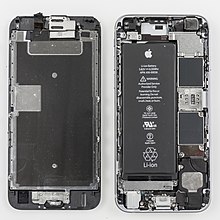
iPhone 6S’s interior; the left half contains the display and the right half contains hardware and battery
Only Apple Stores and Apple Authorized Service Providers are allowed by Apple to perform genuine replacements.[117] Apple has taken steps to make third-party repairs more difficult. iPhone components are soldered, and many are glued together.[118] iPhones receive low repairability scores, in part due to the difficulty of obtaining genuine parts, and the difficulty undertaking each repair.[119] This has given rise to the right to repair movement, aimed at giving users cheaper options for repairing their phones. Apple has lobbied against right to repair legistation.[120] Multiple jurisdictions aim to introduce right to repair laws, including the EU,[121] U.K.,[122] and U.S.[123]
In the past, Apple bricked iPhone 6 models after their home buttons were replaced, displaying an Error 53 message; Apple called this a bug, and released an update to address the issue.[124] On iPhones with a Touch ID sensor, the home button cannot be replaced by users or independent repair shops without losing Touch ID functionality, since Apple has not made their calibration tool public.[125]
In more recent models, starting with the iPhone XR, Apple displays warnings in the Settings app if the battery, display, or camera are replaced by a third party.[126] Additionally, some features are disabled when a part labelled «non-genuine» is detected, like True Tone, or the battery health measurement. iFixit notes that a proprietary, cloud-linked System Configuration tool is required to «complete» a part repair, meaning that even replacing a genuine part with another genuine part will fail Apple’s «genuine parts» check unless said tool is used.[127]
In 2022, Apple rolled out a self-service repair program, allowing any user to buy parts, rent repair tools from Apple, and obtain repair manuals. The program received a degree of praise by iFixit and repair advocates, who also critically noted that Apple maintains control over the parts supply.[128][129]
Privacy
Tracking prevention
Apple introduced App Tracking Transparency (ATT) with iOS 14.5 in April 2021. ATT requires apps to ask for explicit permission before being allowed to track the user across other apps and websites. If the user refuses, the app cannot access Apple’s Identifier for Advertisers (IDFA), an identifier used to serve personalized ads.[130] ATT does not prevent personalized ads that are based on the user’s behavior within the app itself,[131] The feature has been criticised by some as anti-competitive, including Facebook, whose shares fell by 26% after its rollout.[132] Apple exempts their own apps from their anti-tracking measures, which has led to anti-trust investigations by the French and German governments.[133][134]
Location tracking controversy
In July 2010, Apple claimed that it collected iPhone users’ GPS coordinates and nearby Wi-Fi networks twice a day; a Wall Street Journal investigation found that Android sent this data «several times an hour».[135][136]
In September 2010, forensic expert Christopher Vance discovered a hidden unencrypted file named «consolidated.db» that contained a record of iPhone users’ locations.[137][138] The file was added with the June 2010 iOS 4 update, though previous versions of iOS stored similar information in a file called «h-cells.plist».[139] On April 20, 2011, The Guardian publicized research by Alasdair Allen and Pete Warden, who found that anyone with physical access to an iPhone could obtain a detailed record of its owner’s location and movements over the past year.[140] Moreover, the file was automatically backed up by iTunes onto any computer the iPhone was synchronized with.[141] A Wall Street Journal investigation found that users’ locations were still stored when location services are disabled.[142] The controversy led to U.S. congressional scrutiny and an FCC investigation,[138] and was dubbed «Locationgate» by the media.[143]
Apple responded on April 27, 2011, claiming that the data was used to cache nearby Wi-Fi hotspots and cell towers in order to improve location speed and accuracy. The company also claimed that locations being collected when location services were off, and being stored for more than a year, were both bugs.[143] Apple issued an update for iOS (version 4.3.3, or 4.2.8 for the CDMA iPhone 4) which reduced the size of the cache, encrypted it, stopped it being backed up to iTunes, and erased it entirely whenever location services were turned off.[144] Nevertheless, in July 2014, a report on state-owned China Central Television called iPhone tracking a «national security concern.»[145]
Currently, iPhones contain a «Frequent Locations» database which records where users have been, along with exact times they arrived and left, raising concerns that the data could be used in court.[146] This feature can be turned off.[147]
Child safety controversy
In August 2021, Apple announced plans to scan iCloud Photos for child abuse imagery (through an algorithm called «NeuralHash»), and filter explicit images sent and received by children using iPhones (dubbed «Conversation Safety»), to be rolled out later that year.[148] More than 90 policy and human rights groups wrote an open letter to condemn both features.[149] Apple’s plan to implement NeuralHash on-device rather than in the cloud led the EFF and security experts to call it a «backdoor» that could later be expanded to detect other types of contents, and would decrease users’ privacy.[150] Apple claims the system was «misunderstood,» but silently withdrew NeuralHash.[151] Conversation Safety was later added to iOS 15.2.[152]
Security
The iPhone is regarded by security experts as more secure against common malware than Android.[153] Less than 1% of mobile malware targets iOS.[154]
Encryption
Prior to 2014, the iPhone stored all «messages, pictures and videos, contacts, audio recordings […] and call history» in unencrypted form, enabling easy access by law enforcement.[155] This changed with iOS 8, which adopted file-based encryption. Apple does not hold the decryption key, and cannot be compelled to turn over user data, even when presented with a government warrant.[156] Companies like Grayshift and Cellebrite developed exploits that enable law enforcement to extract user data from iPhones without needing the user’s passcode.[157][158]
In 2015 and 2016, a dispute unfolded between Apple and the FBI. The FBI had recovered the iPhone 5C of one of the San Bernardino attackers, and iCloud backups of that phone from a month and a half before the shooting. The U.S. government attempted to obtain a court order under the All Writs Act compelling Apple to produce a modified version of iOS that would allow investigators to brute force the device passcode.[159][160] Tim Cook responded on the company’s website, outlining a need for encryption, arguing that a backdoor would compromise the privacy of all iPhone users.[161] The DOJ withdrew its request after the FBI bought an exploit to bypass the iPhone’s passcode.[162] As a countermeasure, Apple implemented USB Restricted Mode,[163] which was subsequently exploited too.[158]
Pegasus malware
In 2016, researchers discovered the Pegasus suite of exploits targeting iOS and Android, which led to significant international media coverage.[164] Some Pegasus exploits are zero-click, meaning that they can fully compromise the device with no user interaction, for example by sending a malformed iMessage to the user that would not even trigger a notification.[165] Pegasus can collect most data, including chats, passwords, and photos, and can turn on the phone’s microphone and camera remotely.[166][167] Apple quickly issued an update fixing FORCEDENTRY and other known Pegasus exploits,[168] though Pegasus continued to be used, relying on new exploits.[169] Apple also sued NSO, the organization behind Pegasus, announced a new security bounty, and added an optional Lockdown Mode to iOS 16 that reduces the iPhone’s attack surface.[170][171]
Prominent victims of Pegasus include Jamal Khashoggi, and numerous activists, businessmen and politicians.[172] Pegasus has been widely used since 2011,[173] and is still used by law enforcement and governments as of July 2022.[174]
Reception and legacy
The original iPhone has been described as «revolutionary»[175] a «breakthrough handheld computer»,[176] and «the best phone that anybody has ever made.»[177] It is now Apple’s bestselling product, has been credited with helping to make Apple one of the world’s most valuable publicly traded companies by 2011.[178] Newer iterations have also received praise and awards.[179][180]
Before the iPhone, smartphones were mostly used for texting, calls, and email; more advanced functions were harder to use and inconvenient on a small screen.[181] They were also hard to develop for, and lacked a thriving app ecosystem like the App Store (released in 2008).[182][183] Many phones were heavily customized by mobile carriers, which led to feature fragmentation and prevented these phones from turning into thriving software platforms.[184] In contrast, Apple’s iPhone SDK provided a wide range of APIs, made mobile development far more accessible,[185][186] and was instrumental in turning the iPhone into a «Swiss army knife» with a wide range of features and apps.[181]
Successive iPhone models have generated significant fan enthusiasm, with many customers queuing up in front of Apple Stores on launch day.[187] As of 2021, the iPhone has higher brand loyalty than any other smartphone.[188]
The iPhone’s success has led to the decline of incumbents Nokia, BlackBerry, and Motorola.[189][190] RIM, Symbian and Microsoft all attempted to develop more modern operating systems to compete with the iPhone, like Maemo, Windows Phone, and BlackBerry 10; all were unsuccessful. Google successfully started over on their Android project,[181] and designed it for mass adoption by carriers and phone hardware manufacturers.[191] Today, the iOS and Android account for 99% of smartphones used worldwide.[192]
Sales

Steve Jobs’s initial target was to reach 1% of phone market share in 2008.[193] Apple sold 6.1 million units of the original iPhone between Q3 FY2007[note 1] and Q4 FY2008, and 11.3 million units of the iPhone 3G in Q4 FY2008 and Q1 FY2009.[194] In 2008, the iPhone reached 1.1% of worldwide mobile phone market share,[195] and 8.2% of the smartphone market.[196] During this time it was quickly becoming relevant in North America, and in market share was ranked second in the U.S. in 2009, behind the BlackBerry;[197] in 2010 the iPhone 3GS was the best-selling smartphone in the U.S., the first time that an iPhone device reached top spot in that market.[198]
iPhone sales grew continuously year-over-year since its introduction until Q2 FY2016.[199][200] The iPhone briefly surpassed BlackBerry in Q4 FY2008,[201] and permanently overtook it starting in Q3 FY2010.[202] By 2011, Apple sold 100 million iPhones worldwide,[203] and became the largest mobile phone vendor in the world by revenue, surpassing long-time leader Nokia.[204] Q1 FY2012 marked Apple’s best quarterly earnings in its history, with 53% of the company’s revenues coming from iPhone sales.[205] Phone sales are strongly seasonal, peaking in the holiday season (Apple’s Q1). With the release of the iPhone 13 in Q1 FY2022, Apple temporarily topped Samsung, with 84.9 million units shipped compared to Samsung’s 68.9 million. In most quarters, Apple is the second largest smartphone vendor by units.[202][note 2]
Today, Samsung and Apple dominate the smartphone market, with 21.8% and 15.6% worldwide market share respectively.[206] Due to Apple’s small lineup, Apple often dominates the list of bestselling smartphone models.[207][208] Despite its lower market share, the iPhone’s premium positioning has led it to capture nearly half of global smartphone revenue,[209] and 80% of global smartphone profits, with Samsung taking the other 20%.[210] Carriers compete with each other to subsidize iPhone upgrades, which is seen as a significant factor in iPhone sales, though this has reduced carrier profits.[211] On July 27, 2016, Apple announced that it had sold their 1 billionth iPhone.[212]
Compared to other high-tech products, a greater proportion of iPhone users are female.[213] The iPhone has been adopted by both consumers and business users.[214] iPhone users are wealthier and spend more time on their phones than Android users on average.[215][216] The iPhone is especially popular in the U.S., where it has a 50% market share,[217] and is used by 87% of teenagers.[109] Worldwide, the iPhone accounts for 78% of the high-end ($1,000+) smartphone market.[217]
Android overtook the iPhone’s installed base in 2010, according to NPD Group.[218] During Apple’s earnings call on January 27, 2021, Tim Cook said that 1 billion iPhones were being actively used worldwide.[219]
Emerging markets
While other manufacturers make separate entry-level phones, Apple’s entry-level phones are the previous years’ models, part of an effort to increase its market share in emerging markets without diluting its premium brand.[220][221] It also considers emerging market tastes in its product designs; for example, it introduced a gold iPhone after finding that gold was seen as a popular sign of a luxury product among Chinese customers.[222] In 2017, Apple started manufacturing previous years’ iPhone models in India; in 2022, it began manufacturing the current iPhone 14 there too.[223] Analysts have speculated that this was partly caused by Apple’s desire to reduce its dependence on China, and to overcome Indian import duties.[223][224]
See also
- History of the iPhone
- Newton (platform), an early personal digital assistant and the first tablet platform developed by Apple
- Pocket-sized computer
Notes
- ^ 1 GB = 1 billion bytes, 1 TB = 1 trillion bytes
- ^ [clarification needed]
- ^ a b 24-month contract required
- ^ Each company may choose different quarters for their fiscal year. Apple’s fiscal quarters correspond to the following months: Q1 ends in late December, Q2 ends in late March, Q3 ends in late June, and Q4 ends in late September.
All references to quarters in this section reference Apple’s fiscal year quarters. The holiday quarter, the fourth quarter of the calendar year, is referred to as Apple’s Q1.
Since 2011, iPhone releases have consistently occurred in September at the end of Q4, meaning that sales of a new model are mostly reflected in Q1 of the following fiscal year, covering October to December.
- ^ Note that Statista presents data in calendar year quarters; Q4 in Statista data corresponds to Apple’s FY Q1.
References
- ^ «How Many iPhones have been sold». Lifewire. Archived from the original on June 22, 2022. Retrieved July 27, 2019.
- ^ «iPhone 14 Pro Max vs iPhone SE (third generation) vs iPhone 13». Apple Inc. Archived from the original on July 14, 2007. Retrieved October 3, 2013.
- ^ «Apple iPhone smartphone shipments worldwide 2010–2022». Statista. Archived from the original on October 3, 2022. Retrieved October 3, 2022.
- ^ Merchant, Brian (June 22, 2017). The One Device: The Secret History of the iPhone. Transworld. ISBN 978-1-4735-4254-9. Archived from the original on October 13, 2022. Retrieved October 3, 2022.
- ^ Egan, Timothy (July 7, 2017). «Opinion | The Phone Is Smart, but Where’s the Big Idea?». The New York Times. ISSN 0362-4331. Archived from the original on October 3, 2022. Retrieved October 3, 2022.
- ^ Gladwell, Malcolm (November 14, 2011). «The Tweaker: The real genius of Steve Jobs.» Archived March 8, 2013, at the Wayback Machine The New Yorker. p. 2
- ^ «The Secret Origin Story of the IPHONE. An exclusive excerpt from the book «The One Device: The secret history of the iPhone»«. The Verge (published 2017). June 13, 2017. Archived from the original on August 27, 2022.
- ^ Rowinski, Dan (August 7, 2012). «4 Real Secrets We’ve Learned So Far About Apple». Readwriteweb.com. Archived from the original on August 8, 2012. Retrieved October 25, 2012.
- ^ Murtazin, Eldar (June 20, 2010). «Apple’s Phone: From 1980s’ Sketches to iPhone. Part 3». Mobile-review. Archived from the original on May 11, 2011. Retrieved March 27, 2011.
- ^ «The Untold Story: How the iPhone Blew Up the Wireless Industry». Wired. January 9, 2008. Archived from the original on February 13, 2015.
- ^ «iPhone: What the «i» in Apple’s handset names for». Andrew Griffin. The Independent. February 18, 2016. Archived from the original on July 6, 2022. Retrieved November 12, 2017.
- ^ Wei, Will (September 7, 2016). «The meaning of the ‘i’ in ‘iPhone’ – as explained by Steve Jobs». Business Insider. Archived from the original on June 27, 2022. Retrieved November 12, 2017.
- ^ Andreescu, Alex (September 27, 2005). «iPod nano: The End of the Motorola-Apple Story – Ed Zander, Motorola CEO: «Screw the nano»«. Softpedia. Archived from the original on July 1, 2022. Retrieved June 5, 2010.
- ^ Rojas, Peter (September 8, 2005). «It’s official: ROKR E1 iTunes phone can only store max. 100 tracks». Engadget. Archived from the original on May 25, 2022. Retrieved March 23, 2017.
- ^ Lewis, Peter (January 12, 2007). «How Apple kept its iPhone secrets». CNN. Archived from the original on December 10, 2008. Retrieved January 11, 2009.
- ^ Vogelstein, Fred (January 9, 2008). «The Untold Story: How the iPhone Blew Up the Wireless Industry». Wired. Archived from the original on May 9, 2008. Retrieved January 10, 2008.
- ^ Cheng, Jacqui (June 9, 2008). «AT&T remains sole iPhone carrier in US, revenue sharing axed (Updated)». Ars Technica. Archived from the original on March 24, 2017. Retrieved March 23, 2017.
- ^ Brodkin, Jon (June 29, 2017). «With iPhone, Apple showed AT&T and Verizon who’s boss». Ars Technica. Archived from the original on July 3, 2017. Retrieved July 4, 2017.
- ^ Farber, Dan (January 9, 2014). «When iPhone met world, 7 years ago today». CNET. Archived from the original on July 5, 2022. Retrieved March 23, 2017.
- ^ «iPhone (2007) review: A game-changer years in the making». Macworld. Archived from the original on October 5, 2022. Retrieved October 5, 2022.
- ^ «Apple Inc. Q3 2007 Unaudited Summary Data» (PDF) (Press release). Apple Inc. July 25, 2007. Archived from the original (PDF) on May 29, 2008. Retrieved June 6, 2008.
Consists of iPhones and Apple-branded and third-party iPhone accessories.
- ^ «iPhone 3G Coming to countries everywhere». Apple Inc. Archived from the original on July 21, 2008. Retrieved April 12, 2009.
- ^ «iPhone 3G now available in 22 other countries». Macworld. Retrieved October 5, 2022.
- ^ Tweney, Dylan. «WWDC Keynote: Steve Jobs Announces a $200, 3G iPhone». Wired. ISSN 1059-1028. Archived from the original on October 5, 2022. Retrieved October 5, 2022.
- ^ «Apple iPhone 3GS review: Same clothes, new feel». GSMArena.com. Archived from the original on October 5, 2022. Retrieved October 5, 2022.
- ^ a b c «iPhone 4: The Definitive Guide». Gizmodo. June 7, 2010. Archived from the original on July 24, 2017. Retrieved October 5, 2022.
- ^ Ionescu, Daniel. (July 17, 2010) Apple’s iPhone 4 Antennagate Timeline Archived November 3, 2011, at the Wayback Machine. PCWorld. Retrieved November 6, 2011.
- ^ «Liveblog: The Verizon iPhone». The Washington Post. Archived from the original on July 18, 2022. Retrieved January 11, 2011.
- ^ Raice, Shayndi (January 12, 2011). «Verizon Unwraps iPhone». The Wall Street Journal. Archived from the original on July 18, 2022. Retrieved August 12, 2017.
- ^ a b Ziegler, Chris (September 12, 2012). «Apple’s iPhone 5 announcement: everything you need to know». The Verge. Archived from the original on October 5, 2022. Retrieved October 5, 2022.
- ^ Koetsier, John (September 10, 2013). «Apple’s new iPhone 5S: The world’s first 64-bit mobile phone … with fingerprint login». VentureBeat. Archived from the original on October 6, 2022. Retrieved October 6, 2022.
- ^ Tibken, Shara. «Apple launches iPhone 5S and $99 iPhone 5C with five colors». CNET. Archived from the original on October 5, 2022. Retrieved October 5, 2022.
- ^ Rushe, Dominic; Hern, Alex; Gibbs, Samuel; Dredge, Stuart (September 9, 2014). «The Apple Watch, iPhone 6 and iPhone 6 Plus – as it happened». The Guardian. Archived from the original on August 14, 2022. Retrieved March 23, 2017.
- ^ Sacco, Al (September 29, 2014). «Apple (Mostly) Not to Blame in iPhone 6 Plus ‘Bendgate’ Fiasco». CIO. Archived from the original on June 27, 2022. Retrieved May 28, 2021.
- ^ Miller, Chance (September 25, 2015). «Here’s how iPhone 6s Plus handles bendgate brutality». 9to5Mac. Archived from the original on October 5, 2022. Retrieved October 5, 2022.
- ^ «Apple Introduces iPhone SE – The Most Powerful Phone with a Four-inch Display». Apple Newsroom (Singapore). Archived from the original on October 5, 2022. Retrieved October 5, 2022.
- ^ Seifert, Dan (September 7, 2016). «iPhone 7 and 7 Plus announced with water resistance, dual cameras, and no headphone jack». The Verge. Archived from the original on April 27, 2019. Retrieved March 23, 2017.
- ^ Novet, Jordan (January 19, 2017). «Apple’s AirPods are a no-brainer – if you have the latest iPhone». VentureBeat. Archived from the original on October 5, 2022. Retrieved October 5, 2022.
- ^ «Camera». Trusted Reviews. Archived from the original on October 5, 2022. Retrieved October 5, 2022.
- ^ «The future is here: iPhone X». Apple Inc. Archived from the original on September 24, 2017. Retrieved September 14, 2017.
- ^ Warren, Tom (September 14, 2017). «Apple’s iPhone X notch is an odd design choice». The Verge. Archived from the original on December 4, 2017. Retrieved October 5, 2022.
- ^ Stein, Scott. «No home button? No problem: How to do everything on the iPhone X». CNET. Archived from the original on October 13, 2022. Retrieved October 5, 2022.
- ^ Clifford, Catherine. «Apple CEO Tim Cook on the $999 new iPhone X: ‘We’re not trying to charge the highest price we could get or anything like that’«. CNBC. Archived from the original on October 5, 2022. Retrieved October 5, 2022.
- ^ «iPhone Xs and iPhone Xs Max bring the best and biggest displays to iPhone». Apple Inc. Archived from the original on April 27, 2019. Retrieved September 12, 2018.
- ^ «Apple introduces iPhone XR». Apple Inc. Archived from the original on March 27, 2019. Retrieved September 12, 2018.
- ^ «Apple’s new iPhone 11 is $50 cheaper than last year’s model, despite Trump’s planned tariffs on Chinese imports». Business Insider. September 11, 2019. Archived from the original on June 20, 2022. Retrieved September 10, 2019.
- ^ «iPhone 11 Pro and iPhone 11 Pro Max: the most powerful and advanced smartphones». Apple Inc. (Press release). September 10, 2019. Archived from the original on September 10, 2019. Retrieved September 4, 2019.
- ^ «iPhone SE: A powerful new smartphone in a popular design». Apple Newsroom. Archived from the original on April 28, 2020. Retrieved October 5, 2022.
- ^ «Apple announces iPhone 12 and iPhone 12 mini: A new era for iPhone with 5G». Apple Newsroom. Archived from the original on August 14, 2022. Retrieved January 9, 2021.
- ^ «Apple introduces iPhone 12 Pro and iPhone 12 Pro Max with 5G». Apple Newsroom. Archived from the original on October 13, 2020. Retrieved January 9, 2021.
- ^ «Apple introduces iPhone 13 and iPhone 13 mini, delivering breakthrough camera innovations and a powerhouse chip with an impressive leap in battery life». Apple Newsroom. Archived from the original on June 22, 2022. Retrieved October 9, 2021.
- ^ «Apple unveils iPhone 13 Pro and iPhone 13 Pro Max – more pro than ever before». Apple Newsroom. Archived from the original on September 15, 2021. Retrieved October 9, 2021.
- ^ «Apple introduces iPhone 14 and iPhone 14 Plus». Apple Newsroom. Archived from the original on September 24, 2022. Retrieved September 24, 2022.
- ^ «Apple debuts iPhone 14 Pro and iPhone 14 Pro Max». Apple Newsroom. Archived from the original on September 24, 2022. Retrieved September 24, 2022.
- ^ «Taiwan’s Pegatron to get most iPhone 6S orders in 2015: brokerage». Focus Taiwan. Archived from the original on June 29, 2017. Retrieved December 9, 2014.
- ^ Lovejoy, Ben (December 18, 2019). «$43M fraud by Foxconn managers selling iPhones made from rejected parts». 9to5Mac. Archived from the original on June 22, 2022. Retrieved December 20, 2019.
- ^ «Arrests as Indian workers ransack iPhone plant over wages». BBC News. December 14, 2020. Archived from the original on July 10, 2022. Retrieved December 15, 2020.
- ^ «Apple iPhone: Can India be China’s ‘plus one’ to the world?». BBC News. October 5, 2022. Archived from the original on October 6, 2022. Retrieved October 6, 2022.
- ^ Singh, Manish (September 21, 2022). «Apple to move 25% iPhone production to India by 2025, 20% iPad and Apple Watch to Vietnam, analysts say». TechCrunch. Archived from the original on October 12, 2022. Retrieved October 12, 2022.
- ^ «Apple — Support — Technical Specifications». support.apple.com. Archived from the original on December 7, 2022. Retrieved December 7, 2022.
- ^ Nellis, Stephen (September 7, 2022). «Apple offers adventure watch, satellite SOS iPhone – and steady prices». Reuters. Archived from the original on September 8, 2022. Retrieved September 8, 2022.
- ^ Patel, Nilay (June 7, 2010). «iPhone OS 4 renamed iOS 4, launching June 21 with 1500 new features». Engadget. Archived from the original on May 23, 2022. Retrieved March 23, 2017.
- ^ Frommer, Dan (June 14, 2016). «Here’s how to remove Apple’s built-in system apps in iOS 10». Recode. Archived from the original on April 29, 2019. Retrieved May 28, 2017.
- ^ Miller, Paul (March 6, 2008). «Apple announces App Store for iPhone, iPod touch». Engadget. Archived from the original on December 31, 2017. Retrieved May 28, 2017.
- ^ «Update your iPhone, iPad, or iPod touch». Apple Support. Archived from the original on August 28, 2022. Retrieved May 30, 2018.
- ^ Painter, Lewis. «Which iPhones & iPads are compatible with iOS 11?». Macworld. Archived from the original on March 28, 2018. Retrieved May 30, 2018.
- ^ «Apple releases iOS 11 for iPhone and iPad, here’s everything new». 9to5Mac. September 19, 2017. Archived from the original on June 22, 2022. Retrieved May 30, 2018.
- ^ «iPhone to Support Third-Party Web 2.0 Applications» (Press release). Apple Inc. June 11, 2007. Archived from the original on December 15, 2008. Retrieved December 15, 2008.
- ^ «Hot News». Apple. Archived from the original on October 18, 2007. Retrieved September 9, 2017.
- ^ Block, Ryan (March 6, 2008). «Live from Apple’s iPhone SDK press conference». Engadget. Archived from the original on March 23, 2020. Retrieved March 23, 2017.
- ^ «Apple Introduces the New iPhone 3G» (Press release). Apple Inc. June 9, 2008. Archived from the original on May 1, 2011.
iPhone 2.0 software will be available on July 11 as a free software update via iTunes 7.7 or later for all iPhone customers
- ^ «Should Apple raise its $99 developer program fee, or scrap it entirely?». ZDNET. Archived from the original on October 3, 2022. Retrieved October 3, 2022.
- ^ «Program Renewal – Support – Apple Developer». developer.apple.com. Archived from the original on October 3, 2022. Retrieved October 3, 2022.
If your Apple Developer Program membership expires, your apps will no longer be available for download and you won’t be able to submit new apps or updates. […] However, your apps will still function for users who have already installed or downloaded them, and you will still have access to App Store Connect and free development resources.
- ^ Quinn, Michelle (July 10, 2008). «Apple will open App Store in bid to boost iPhone sales». Los Angeles Times. Archived from the original on October 16, 2008. Retrieved July 10, 2008.
- ^ Statt, Nick (November 18, 2020). «Apple will reduce App Store cut to 15 percent for most developers starting January 1st». The Verge. Archived from the original on October 3, 2022. Retrieved October 3, 2022.
- ^ Hill, Simon; Jansen, Mark (April 14, 2021). «Android vs. iOS: Which Smartphone Platform Is the Best?». Digital Trends. Archived from the original on October 11, 2022. Retrieved October 12, 2022.
- ^ Brodkin, Jon (June 29, 2017). «With iPhone, Apple showed AT&T and Verizon who’s boss». Ars Technica. Archived from the original on September 12, 2022. Retrieved October 11, 2022.
- ^ Leswing, Kif. «Inside Apple’s team that greenlights iPhone apps for the App Store». CNBC. Archived from the original on October 3, 2022. Retrieved October 3, 2022.
- ^ Andrews, Robert (May 6, 2009). «The Sun’s ‘obscene’ Page 3 girls get iPhone newspaper app banned by Apple». the Guardian. Archived from the original on October 7, 2022. Retrieved October 3, 2022.
- ^ «Tumblr Explains Why It Still Bans Porn: Blame Credit Card Companies, Apple». PCMAG. Archived from the original on October 13, 2022. Retrieved October 3, 2022.
- ^ Lovejoy, Ben (December 28, 2021). «App Store review process perplexing, random, discordant, asinine – ex-Tumblr developer». 9to5Mac. Archived from the original on October 13, 2022. Retrieved October 3, 2022.
- ^ Centers, Josh (August 13, 2020). «Developers v. Apple: Outlining Complaints about the App Store». TidBITS. Archived from the original on October 3, 2022. Retrieved October 3, 2022.
- ^ Statt, Nick (November 18, 2020). «Apple’s biggest App Store critics are not impressed with its new fee cut for small developers». The Verge. Archived from the original on October 3, 2022. Retrieved October 3, 2022.
- ^ «Apple ‘Surprised’ By Developer Frustration With Its App Review Process». MacRumors. Archived from the original on October 3, 2022. Retrieved October 3, 2022.
- ^ Healey, Jon (August 6, 2007). «Hacking the iPhone». Los Angeles Times. Archived from the original on November 12, 2013. Retrieved June 6, 2008.
- ^ Fitzgerald, Thomas J. (November 24, 2010). «Breaking into the Smartphone (Risks Included)». The New York Times. ISSN 0362-4331. Archived from the original on October 3, 2022. Retrieved October 3, 2022.
- ^ Perton, Marc (October 22, 2013). «Apple App Store hits 60 billion cumulative downloads». Engadget. Archived from the original on March 30, 2019. Retrieved March 23, 2017.
- ^ Perez, Sarah (September 7, 2016). «App Store sees 140 billion downloads, 106% year-over-year growth». TechCrunch. Archived from the original on March 19, 2022. Retrieved March 23, 2017.
- ^ Goode, Lauren (January 5, 2017). «Apple’s App Store just had the most successful month of sales ever». The Verge. Archived from the original on August 21, 2022. Retrieved May 28, 2017.
- ^ «App Store shatters records on New Year’s Day» (Press release). Apple Inc. January 5, 2017. Archived from the original on July 9, 2022. Retrieved December 31, 2017.
- ^ Braiker, Brian (May 2, 2008). «A Killer Product: Will closed devices like Apple’s iPhone murder the Web?». Newsweek. Archived from the original on April 13, 2010. Retrieved June 16, 2009.
- ^ Krazit, Tom (October 29, 2007). «iPhone jailbreak for the masses released». CNET. Archived from the original on March 19, 2022. Retrieved March 23, 2017.
- ^ Love, Dylan. «13 iPhone Features Apple Stole From Jailbreak Developers». Business Insider. Archived from the original on October 20, 2022. Retrieved October 20, 2022.
- ^ Milian, Mark (July 27, 2010). «‘Jailbreaking’ Apple iPhones is legal, government says». Los Angeles Times. Archived from the original on October 20, 2022. Retrieved October 20, 2022.
- ^ «The pros and cons of iPhone jailbreaking». Macworld. Archived from the original on October 20, 2022. Retrieved October 20, 2022.
- ^ FAQ Details Archived August 4, 2014, at the Wayback Machine. Eshop.macsales.com (March 27, 2013). Retrieved on July 30, 2013.
- ^ Brandom, Russell (September 30, 2016). «The rising cost of cracking the iPhone». The Verge. Archived from the original on January 11, 2023. Retrieved October 20, 2022.
- ^ Hardwick, Tim (August 19, 2022). «iOS 16: How to Make Siri Announce Notifications Through Your iPhone’s Speaker». MacRumors. Archived from the original on January 11, 2023. Retrieved October 20, 2022.
- ^ a b c Biersdorfer, J. D. (September 21, 2022). «The Settings That Make Smartphones Easier for Everyone to Use». The New York Times. ISSN 0362-4331. Archived from the original on October 19, 2022. Retrieved October 20, 2022.
- ^ «Use Live Listen with Made for iPhone hearing aids». Apple Support. Archived from the original on April 27, 2019. Retrieved October 12, 2022.
- ^ «Use Live Listen with Made for iPhone hearing aids». Apple Inc. Archived from the original on April 27, 2019. Retrieved April 3, 2016.
- ^ Heisler, Yoni (June 8, 2016). «This was the first iPhone rumor. Ever». New York Post. Archived from the original on October 11, 2022. Retrieved October 11, 2022.
- ^ Graham, Jefferson (March 9, 2010). «Apple buffs marketing savvy to a high shine». USA Today. Archived from the original on March 24, 2007. Retrieved October 11, 2022.
- ^ Stieg, Cory. «The psychology behind a new iPhone release—and why it’s so hard to resist». CNBC. Archived from the original on January 11, 2023. Retrieved October 20, 2022.
- ^ DeNinno, Nadine (May 22, 2014). «Forget Fashion: Teens Spend Their Money On Food And Phones». International Business Times. Retrieved October 20, 2022.
- ^ Bertrand, Marianne; Kamenica, Emir (July 5, 2018). «Coming Apart? Cultural Distances in the United States Over Time». NBER Working Paper. Rochester, NY. SSRN 3208730. Archived from the original on January 11, 2023. Retrieved October 20, 2022.
- ^ Higgins, Tim. «Why Apple’s iMessage Is Winning: Teens Dread the Green Text Bubble». WSJ. Archived from the original on October 20, 2022. Retrieved October 20, 2022.
- ^ Nieva, Richard. «Google Calls On Apple To Fix Hated Green Bubbles On iMessage». Forbes. Archived from the original on January 11, 2023. Retrieved October 20, 2022.
- ^ a b Clover, Juli (October 11, 2022). «iPhone Ownership Among Teens Hits 87%, More Than Double Since 2012». MacRumors. Archived from the original on October 12, 2022. Retrieved October 12, 2022.
- ^ a b Hattersley, Lucy (July 22, 2022). «How to check an iPhone is unlocked before buying it». Macworld. Archived from the original on October 14, 2022. Retrieved October 14, 2022.
- ^ Farivar, Cyrus (November 14, 2007). «Unlocking an iPhone». Macworld. Archived from the original on March 19, 2022. Retrieved May 25, 2009.
- ^ «iPhone 3G Price Decrease Addresses Key Reason Consumers Exhibit Purchase Resistance». NPD Group. June 22, 2009. Archived from the original on June 26, 2009. Retrieved June 27, 2009.
- ^ «Quarter of US iPhones ‘unlocked’«. BBC News. January 28, 2008. Archived from the original on February 12, 2009. Retrieved January 29, 2008.
- ^ «Sim lock laws by country – ChimeraTool help». ChimeraTool. Archived from the original on January 11, 2023. Retrieved October 14, 2022.
- ^ Fiegerman, Seth (September 1, 2013). «Apple Rolls Out iPhone Trade-In Program Nationwide». Mashable. Mashable. Archived from the original on September 1, 2022. Retrieved September 1, 2013.
- ^ «Here’s Why Apple Is Offering An iPhone Upgrade Plan». Fortune. Retrieved October 18, 2022.
- ^ «About genuine iPhone displays». Apple Support. Archived from the original on August 5, 2022. Retrieved June 1, 2021.
- ^ Chugh, Ritesh. «Screwed over: how Apple and others are making it impossible to get a cheap and easy phone repair». The Conversation. Archived from the original on October 22, 2022. Retrieved October 20, 2022.
- ^ Buskirk, Chris Van. «Apple products get low marks in new repairability index». MetroWest Daily News. Archived from the original on October 20, 2022. Retrieved October 20, 2022.
- ^ «Apple Is Lobbying Against Your Right to Repair iPhones, New York State Records Confirm». www.vice.com. Archived from the original on October 20, 2022. Retrieved October 20, 2022.
- ^ Abnett, Kate (March 30, 2022). «Reduce, repair, recycle as EU plans ‘circular’ rules for everyday items». Reuters. Archived from the original on October 20, 2022. Retrieved October 20, 2022.
- ^ Swinford, Steven (March 10, 2021). «‘Right to repair’ means spare parts for household appliances». The Times. Archived from the original on October 20, 2022. Retrieved October 20, 2022.
- ^ Shepardson, David (February 3, 2022). «U.S. lawmakers introduce ‘Right to Repair’ bills to spur competition». Reuters. Archived from the original on October 20, 2022. Retrieved October 20, 2022.
- ^ Macro, Ashleigh (July 26, 2018). «Apple apologises, releases fix for iPhones bricked by Error 53». Macworld UK. Archived from the original on March 19, 2022. Retrieved April 20, 2021.
- ^ «iPhone 8 Plus Home/Touch ID Sensor Replacement». iFixit. December 13, 2017. Archived from the original on October 20, 2022. Retrieved October 20, 2022.
- ^ «iOS 14.4 Will Introduce Warning on iPhones With Non-Genuine Cameras». MacRumors. Archived from the original on May 24, 2022. Retrieved June 1, 2021.
- ^ «Is This the End of the Repairable iPhone?». iFixit. June 1, 2021. Archived from the original on August 26, 2022. Retrieved June 1, 2021.
- ^ Adorno, José (April 27, 2022). «iFixit praises Apple Self Service Repair program, but says it falls short of Right to Repair goals». 9to5Mac. Archived from the original on October 21, 2022. Retrieved October 20, 2022.
- ^ «Apple Fixes Its DIY Repair Stance». IEEE Spectrum. December 7, 2021. Archived from the original on October 20, 2022. Retrieved October 20, 2022.
- ^ Cross, Jason (April 29, 2021). «What is App Tracking Transparency and how do you block app tracking?». Macworld. Archived from the original on October 19, 2022. Retrieved October 19, 2022.
- ^ Bechade, Corentin (April 30, 2021). «App Tracking Transparency : tout savoir sur le contrôle du suivi publicitaire d’Apple». Numerama (in French). Archived from the original on October 19, 2022. Retrieved October 19, 2022.
- ^ Howley, Daniel (February 3, 2022). «What to know about the Apple privacy changes that crushed Facebook parent Meta». Yahoo Finance. Archived from the original on October 19, 2022. Retrieved October 19, 2022.
- ^ «Apple gets boost in French privacy fight, but still faces probe». Reuters. March 17, 2021. Archived from the original on October 19, 2022. Retrieved October 19, 2022.
- ^ «German cartel office examining Apple’s tracking rules». Reuters. June 14, 2022. Archived from the original on October 19, 2022. Retrieved October 19, 2022.
- ^ Valentino-DeVries, Julia Angwin And Jennifer. «Apple’s iPhones and Google’s Androids Send Cellphone Location». WSJ. Archived from the original on September 28, 2013. Retrieved October 19, 2022.
- ^ Sewell, Bruce (July 12, 2010). «Apple Inc.’s Response to Request for Information Regarding Its Privacy Policy and Location-Based Services» (PDF). Archived from the original (PDF) on December 8, 2010. Retrieved October 19, 2022.
- ^ Vance, Christopher (October 9, 2010). «iPhone iOS4 GPS Data». Cellular.Sherlock. Archived from the original on October 9, 2010. Retrieved October 19, 2022.
- ^ a b Keizer, Gregg (April 21, 2011). «Apple faces questions from Congress about iPhone tracking». Computerworld. Archived from the original on October 19, 2022. Retrieved October 19, 2022.
- ^ Rooney, Ben (April 21, 2011). «Apple New Secret Tracking File Neither New Nor Secret». The Wall Street Journal. ISSN 0099-9660. Archived from the original on October 20, 2022. Retrieved October 20, 2022.
- ^ Arthur, Charles (April 20, 2011). «iPhone keeps record of everywhere you go». The Guardian. Archived from the original on October 19, 2022. Retrieved October 19, 2022.
- ^ Allan, Alasdair. «Got an iPhone or 3G iPad? Apple is recording your moves». O’Reilly Radar. Archived from the original on October 19, 2022. Retrieved October 19, 2022.
- ^ Valentino-DeVries, Jennifer (April 25, 2011). «IPhone Stored Location Even if Disabled». WSJ. Archived from the original on September 27, 2013. Retrieved October 19, 2022.
- ^ a b Elmer-Dewitt, Philip (April 27, 2011). «LocationGate was a «bug,» says Apple». Fortune. Archived from the original on October 19, 2022. Retrieved October 19, 2022.
- ^ «Apple Q&A on Location Data» (Press release). Apple Inc. April 27, 2011. Archived from the original on June 7, 2011. Retrieved June 7, 2011.
- ^ «Influential China TV alleges iPhone exposing ‘state secrets’«. Beijing News.Net. Archived from the original on July 14, 2014. Retrieved July 10, 2014.
- ^ «iPhone Feature Tracks Your Movement, Learns Your ‘Home’«. Newsweek. May 2, 2014. Archived from the original on October 19, 2022. Retrieved October 19, 2022.
- ^ Waterson, Jim. «Your iPhone Knows Exactly Where You’ve Been And This Is How To See It». BuzzFeed News. Archived from the original on March 23, 2022. Retrieved October 19, 2022.
- ^ Marcos, Coral Murphy; Browning, Kellen (September 3, 2021). «Apple delays the rollout of child-safety features over privacy concerns». The New York Times. ISSN 0362-4331. Archived from the original on October 20, 2022. Retrieved October 20, 2022.
- ^ Menn, Joseph (August 19, 2021). «Policy groups ask Apple to drop plans to inspect iMessages, scan for abuse images». Reuters. Archived from the original on January 11, 2023. Retrieved October 20, 2022.
- ^ Portnoy, India McKinney and Erica (August 5, 2021). «Apple’s Plan to «Think Different» About Encryption Opens a Backdoor to Your Private Life». Electronic Frontier Foundation. Archived from the original on October 18, 2022. Retrieved October 20, 2022.
- ^ Simon, Michael (April 21, 2022). «Apple CSAM detection: Conversation Safety for Messages is coming to the UK». Macworld. Archived from the original on October 20, 2022. Retrieved October 20, 2022.
- ^ Malik, Aisha (November 9, 2021). «iOS 15.2 includes Apple’s new safety feature for kids in Messages». TechCrunch. Archived from the original on October 20, 2022. Retrieved October 20, 2022.
- ^ Bary, Emily. «Android vs. iOS: Are iPhones Really Safer?». Barron’s. Archived from the original on January 11, 2023. Retrieved October 20, 2022.
- ^ «Do iPhones get viruses? We bust the myths». Macworld. Archived from the original on January 11, 2023. Retrieved October 20, 2022.
- ^ Cunningham, Andrew (May 8, 2014). «New guidelines outline what iPhone data Apple can give to police». Ars Technica. Archived from the original on October 20, 2022. Retrieved October 20, 2022.
- ^ Farivar, Cyrus (September 18, 2014). «Apple expands data encryption under iOS 8, making handover to cops moot». Ars Technica. Archived from the original on January 11, 2023. Retrieved October 20, 2022.
- ^ Cox, Joseph (July 5, 2018). «Leaked Emails Show Cops Trying to Hide Emails About Phone Hacking Tools». Vice Media. Archived from the original on March 20, 2022. Retrieved July 6, 2018.
Leaked emails from one of these communities showed how some members were confident that Grayshift, the company behind the GrayKey product, had already found a workaround to a new security feature from Apple called USB Restricted Mode.
- ^ a b Nicas, Jack (October 21, 2020). «The Police Can Probably Break Into Your Phone». The New York Times. ISSN 0362-4331. Archived from the original on October 20, 2022. Retrieved October 20, 2022.
- ^ Michael Riley; Jordan Robertson (February 19, 2016). «Secret Memo Details U.S.’s Broader Strategy to Crack Phones». Bloomberg News. Archived from the original on August 26, 2022. Retrieved March 7, 2017.
- ^ Farivar, Cyrus (February 17, 2016). «Judge: Apple must help FBI unlock San Bernardino shooter’s iPhone». Ars Technica. Archived from the original on June 23, 2022. Retrieved March 23, 2017.
- ^ Tim Cook. «A Message to Our Customers». Archived from the original on February 17, 2016.
The United States government has demanded that Apple take an unprecedented step which threatens the security of our customers. We oppose this order, which has implications far beyond the legal case at hand.
- ^ Nakashima, Ellen; Albergotti, Reed (April 14, 2021). «The FBI wanted to unlock the San Bernardino shooter’s iPhone. It turned to a little-known Australian firm». Washington Post. Archived from the original on November 24, 2022. Retrieved October 20, 2022.
- ^ Nicas, Jack (June 13, 2018). «Apple to Close iPhone Security Hole That Law Enforcement Uses to Crack Devices». The New York Times. ISSN 0362-4331. Archived from the original on October 20, 2022. Retrieved October 20, 2022.
- ^ Timberg, Craig; Albergotti, Reed; Guéguen, Elodie (July 19, 2021). «Despite the hype, iPhone security no match for NSO spyware – International investigation finds 23 Apple devices that were successfully hacked». The Washington Post. Archived from the original on July 19, 2021. Retrieved July 19, 2021.
- ^ Priest, Dana; Timberg, Craig; Mekhennet, Souad. «Private Israeli spyware used to hack cellphones of journalists, activists worldwide». Washington Post. Archived from the original on January 2, 2020. Retrieved October 20, 2022.
- ^ Cox, Joseph (May 12, 2020). «NSO Group Pitched Phone Hacking Tech to American Police». Vice. Archived from the original on January 30, 2022. Retrieved January 30, 2022.
- ^ Bergman, Ronen; Mazzetti, Mark (January 28, 2022). «The Battle for the World’s Most Powerful Cyberweapon». The New York Times. Archived from the original on January 30, 2022. Retrieved January 30, 2022.
- ^ «Israeli spyware firm targeted Apple devices via iMessage, researchers say». the Guardian. September 14, 2021. Archived from the original on November 1, 2022. Retrieved November 1, 2022.
- ^ Kirchgaessner, Stephanie (April 5, 2022). «Victim’s iPhone hacked by Pegasus spyware weeks after Apple sued NSO». The Guardian. Retrieved November 1, 2022.
- ^ Nellis, Stephen (July 6, 2022). «Apple to release new ‘Lockdown Mode’ as it battles spyware firms». Reuters. Archived from the original on November 1, 2022. Retrieved November 1, 2022.
- ^ Newman, Lily Hay. «iOS 16 Has 2 New Security Features for Worst-Case Scenarios». Wired. ISSN 1059-1028. Retrieved November 1, 2022.
- ^ Benjakob, Omer (April 5, 2022). «The NSO File: A Complete (Updating) List of Individuals Targeted With Pegasus Spyware». Haaretz. Archived from the original on October 20, 2022. Retrieved October 20, 2022.
- ^ Bergman, Ronen; Mazzetti, Mark (January 28, 2022). «The Battle for the World’s Most Powerful Cyberweapon». The New York Times. ISSN 0362-4331. Archived from the original on January 30, 2022. Retrieved October 20, 2022.
- ^ Ingleton, Danna (July 18, 2022). «A year on from the Pegasus project, governments still have access to surveillance technology | Danna Ingleton». The Guardian. Archived from the original on October 20, 2022. Retrieved October 20, 2022.
- ^ Pogue, David (June 27, 2007). «The iPhone Matches Most of Its Hype». The New York Times. Archived from the original on September 1, 2022. Retrieved March 23, 2017.
- ^ Boehret, Walter S. Mossberg and Katherine (June 28, 2007). «Testing Out the iPhone». The Wall Street Journal. ISSN 0099-9660. Archived from the original on October 13, 2022. Retrieved October 11, 2022.
- ^ Grossman, Lev (June 30, 2007). ««I Take the iPhone Home»«. Time. ISSN 0040-781X. Archived from the original on October 13, 2022. Retrieved October 11, 2022.
- ^ Satariano, Adam (August 10, 2011). «Apple Surpasses Exxon as World’s Most Valuable Company Before Retreating». Bloomberg News. Archived from the original on August 10, 2011. Retrieved May 28, 2017.
- ^ Clover, Juli (September 27, 2022). «iPhone 14 Pro Max Earns Best Smartphone Display Award, Replacing iPhone 13 Pro Max». MacRumors. Retrieved October 11, 2022.
- ^ Stevenson, Alastair (October 11, 2021). «Trusted Reviews Awards: The iPhone 12 Pro Max is 2021’s Best Camera Phone». Trusted Reviews. Archived from the original on October 13, 2022. Retrieved October 11, 2022.
- ^ a b c «Why The iPhone Upended The Tech Industry». Time. Archived from the original on July 20, 2022. Retrieved October 11, 2022.
- ^ «Why does Symbian collapse?». Pixelstech.net. Archived from the original on March 20, 2022. Retrieved June 13, 2013.
- ^ Streitfeld, David (November 17, 2012). «As Boom Lures App Creators, Tough Part Is Making a Living». The New York Times. Archived from the original on September 1, 2022. Retrieved April 2, 2013.
- ^ Siracusa, John (July 2, 2007). «Let a million iPhones bloom». Ars Technica. Archived from the original on March 19, 2022. Retrieved March 23, 2017.
- ^ Hackett, Stephen (March 15, 2018). «The Initial iPhone SDK». MacStories. Retrieved October 11, 2022.
- ^ Timmer, John (June 28, 2017). «A touch of Cocoa: Inside the original iPhone SDK». Ars Technica. Archived from the original on October 13, 2022. Retrieved October 11, 2022.
- ^ Etherington, Darrell (September 20, 2013). «Apple’s iPhone 5s And 5c Launch Draws Big Crowds, Including Biggest Ever Line at NYC Flagship Store». TechCrunch. Archived from the original on September 1, 2022. Retrieved March 23, 2017.
- ^ «Apple has most loyal smartphone customers in US, study finds». AppleInsider. October 29, 2021. Archived from the original on October 12, 2022. Retrieved October 12, 2022.
- ^ Hankin, Aaron (June 25, 2019). «Three Companies the iPhone Killed». Investopedia. Archived from the original on October 11, 2022. Retrieved October 11, 2022.
- ^ 64 million smart phones shipped worldwide in 2006 (PDF) (Report). Canalys. February 12, 2007. Archived (PDF) from the original on October 13, 2022. Retrieved October 11, 2022.
- ^ Amadeo, Ron (August 6, 2015). «Waiting for Android’s inevitable security Armageddon». Ars Technica. Archived from the original on March 12, 2017. Retrieved October 11, 2022.
- ^ «Global mobile OS market share 2012–2022». Statista. Archived from the original on October 11, 2022. Retrieved October 11, 2022.
- ^ Guglielmo, Connie. «Steve Jobs Knew iPhone Would Be Iconic. More Than 2 Billion Phones Later, He Was Right». CNET. Archived from the original on October 18, 2022. Retrieved October 19, 2022.
- ^ «Apple Reports First Quarter Results» (Press release). Apple Inc. January 21, 2009. Archived from the original on June 23, 2009.
- ^ Foresman, Chris (January 30, 2009). «iPhone passes 1 percent goal for 2008, looking good for 2009». Ars Technica. Archived from the original on August 14, 2022. Retrieved September 24, 2020.
- ^ «Gartner: iPhone Sales Double in 2009 as Apple Claims Third Place in Smartphone Sales». MacRumors. Archived from the original on August 14, 2022. Retrieved September 24, 2020.
- ^ «Research in Motion battles BlackBerry’s competitors — Aug. 17, 2009». money.cnn.com. Archived from the original on December 8, 2022. Retrieved January 4, 2023.
- ^ «Top 10 Mobile phones in the US in 2010». The Independent. December 24, 2010. Archived from the original on January 4, 2023. Retrieved January 4, 2023.
- ^ Howse, Brett. «Apple Announces Q2 Fiscal Year 2016 Results: iPhone Sales Slowed But Services Gain». www.anandtech.com. Archived from the original on November 18, 2021. Retrieved October 12, 2022.
- ^ Snell, Jason (April 26, 2016). «Apple Q2 2016 results: Going down!». Six Colors. Archived from the original on October 12, 2022. Retrieved October 12, 2022.
- ^ «Apple iPhone 3G sales surpass RIM’s Blackberry». AppleInsider. October 21, 2008. Archived from the original on October 22, 2008. Retrieved October 22, 2008.
- ^ a b «Global smartphone shipments by vendor 2009–2022». Statista. August 24, 2022. Archived from the original on October 12, 2022. Retrieved October 12, 2022.
- ^ «Apple: 100 Million iPhones Sold». Mashable. March 2, 2011. Archived from the original on September 1, 2022. Retrieved March 2, 2011.
- ^ «Strategy Analytics: Apple Becomes World’s Largest Handset Vendor by Revenue in the first quarter of 2011» (Press release). April 21, 2011. Archived from the original on January 11, 2012.
- ^ Jordan, Golson (January 26, 2012). «iPhone Average Selling Price Remains Steady Even With Free 3GS Offer». MacRumors. Archived from the original on March 19, 2022. Retrieved September 6, 2012.
- ^ «Apple iPhone market share 2007–2022». Statista. August 24, 2022. Archived from the original on October 7, 2022. Retrieved October 12, 2022.
- ^ Chauhan, Karn (March 8, 2022). «Apple Captures 7 Spots in 2021 List for Global Top 10 Smartphones». Counterpoint Research. Archived from the original on March 8, 2022. Retrieved October 12, 2022.
- ^ Swingle, Joshua (May 19, 2022). «The iPhone 13 and 13 Pro Max were the world’s best-selling phones in Q1». Phone Arena. Archived from the original on September 27, 2022. Retrieved October 12, 2022.
- ^ «Global Smartphone Revenue Hits Record ~$450 Billion in 2021; Apple Captures Highest Ever Share in Q4 2021». Counterpoint Research. February 25, 2022. Archived from the original on October 12, 2022. Retrieved October 12, 2022.
- ^ Orr, Andrew (September 29, 2022). «Apple continuing command of global smartphone profits, and the lead is growing». AppleInsider. Archived from the original on October 12, 2022. Retrieved October 12, 2022.
- ^ Bary, Emily (October 17, 2020). «The 5G iPhone is reigniting the subsidy wars, which is good for Apple and consumers but not mobile carriers». MarketWatch. Archived from the original on July 22, 2022. Retrieved October 12, 2022.
- ^ «Apple celebrates one billion iPhones». Apple Newsroom. Archived from the original on September 1, 2022. Retrieved March 18, 2021.
- ^ Williams, Rhiannon (January 9, 2015). «Women more likely to own an iPhone than men». Daily Telegraph. London. Archived from the original on July 1, 2022. Retrieved August 15, 2015.
- ^ «Early Signs Of iPhone Adoption in Business – InformationWeek». InformationWeek. Archived from the original on September 1, 2022. Retrieved May 30, 2018.
- ^ «iPhone Users Earn Higher Income, Engage More on Apps than Android Users». Comscore, Inc. Archived from the original on August 9, 2022. Retrieved June 7, 2020.
- ^ «Want to Appear Rich? Buy an iPhone». Gizmodo. July 8, 2018. Archived from the original on May 28, 2022. Retrieved June 7, 2020.
- ^ a b Lovejoy, Ben (September 2, 2022). «iPhone US market share hits all-time high, overtaking Android; dominates global premium sales». 9to5Mac. Archived from the original on October 12, 2022. Retrieved October 12, 2022.
- ^ Hardwick, Tim (September 2, 2022). «Apple’s U.S. iPhone User Base Overtook Android in June Quarter, Now Accounts for More Than Half of All Smartphones». MacRumors. Archived from the original on October 13, 2022. Retrieved October 12, 2022.
- ^ Kastrenakes, Jacob (January 27, 2021). «Apple says there are now over 1 billion active iPhones». The Verge. Archived from the original on September 3, 2022. Retrieved March 18, 2021.
- ^ «How the old products Apple keeps around are crucial to its success». Macworld. Archived from the original on October 12, 2022. Retrieved October 12, 2022.
- ^ Duprey, Rich (August 20, 2020). «Analyst: Used iPhones Will Significantly Expand Apple’s Share in Emerging Markets». NASDAQ. Archived from the original on October 12, 2022. Retrieved October 12, 2022.
- ^ Chan & Chen (June 22, 2015). «Cook Says Chinese Tastes Considered in Apple Product Designs». Bloomberg News. Archived from the original on August 11, 2022. Retrieved August 15, 2015.
- ^ a b Kharpal, Arjun (September 26, 2022). «Apple begins making the iPhone 14 in India, marking a big shift in its manufacturing strategy». CNBC. Archived from the original on October 11, 2022. Retrieved October 12, 2022.
- ^ John, Cyrus (October 19, 2020). «Explained: Why iPhones Cost Lot More in India». TheQuint. Archived from the original on October 21, 2021. Retrieved October 12, 2022.
External links
- Video of Steve Jobs announcing the iPhone at Macworld 2007 on YouTube
- Evolution of iPhone at TechEngage, February 3, 2021
 The front face of an iPhone 14 Pro in Deep Purple | |
| Developer | Apple Inc. |
|---|---|
| Manufacturer | Foxconn, Pegatron, Wistron (contract manufacturers) |
| Type | Smartphone Phablet (only models with 6.7 inch display) |
| Units sold | 2.2 billion (as of November 1, 2018)[1] |
| Operating system | iOS |
| Storage | 64, 128, 256, 512 GB or 1 TB[a] flash memory[2] |
| Sound |
|
| Power | Built-in rechargeable lithium-ion battery |
| Online services |
|
| Related |
|
| Website | apple.com/iphone/ |
The iPhone is a line of smartphones designed and marketed by Apple Inc. These devices use Apple’s iOS mobile operating system. The first-generation iPhone was announced by then-Apple CEO Steve Jobs on January 9, 2007. Since then, Apple has annually released new iPhone models and iOS updates. As of November 1, 2018, more than 2.2 billion iPhones had been sold. As of 2022, the iPhone accounts for 15.6% of global smartphone market share.[3]
The iPhone was the first mobile phone with multi-touch technology.[4] Since the iPhone’s launch, it gained larger screen sizes, video-recording, waterproofing, and many accessibility features. Up to iPhone 8 and 8 Plus, iPhones had a single button on the front panel with the Touch ID fingerprint sensor. Since iPhone X, iPhone models have switched to a nearly bezel-less front screen design with Face ID facial recognition, and app switching activated by gestures. Touch ID is still used for the budget iPhone SE series.
The iPhone is one of the two largest smartphone platforms in the world alongside Android, and is a large part of the luxury market. The iPhone has generated large profits for Apple, making it one of the world’s most valuable publicly traded companies. The first-generation iPhone was described as a «revolution» for the mobile phone industry and subsequent models have also garnered praise.[5] The iPhone has been credited with popularizing the smartphone and slate form factor, and with creating a large market for smartphone apps, or «app economy». As of January 2017, Apple’s App Store contained more than 2.2 million applications for the iPhone.
History
Development of an Apple smartphone began in 2004, when Apple started to gather a team of 1,000 employees led by hardware engineer Tony Fadell, software engineer Scott Forstall, and design officer Jony Ive,[6] to work on the highly confidential «Project Purple».[7][8]
Then-Apple CEO Steve Jobs steered the original focus away from a tablet (which was later revisited in the form of the iPad) towards a phone.[9] Apple created the device during a secretive collaboration with Cingular Wireless (later renamed AT&T Mobility) at the time—at an estimated development cost of US$150 million over thirty months.[10] According to Jobs in 1998, the «i» word in «iMac» (and therefore «iPod», «iPhone» and «iPad») stands for internet, individual, instruct, inform, and inspire.[11][12]
Apple rejected the «design by committee» approach that had yielded the Motorola ROKR E1, a largely unsuccessful «iTunes phone» made in collaboration with Motorola. Among other deficiencies, the ROKR E1’s firmware limited storage to only 100 iTunes songs to avoid competing with Apple’s iPod nano.[13][14] Cingular gave Apple the liberty to develop the iPhone’s hardware and software in-house, a rare practice at the time,[15][16] and paid Apple a fraction of its monthly service revenue (until the iPhone 3G),[17] in exchange for four years of exclusive U.S. sales, until 2011.[18]
Jobs unveiled the first-generation iPhone to the public on January 9, 2007, at the Macworld 2007 convention at the Moscone Center in San Francisco.[19] The iPhone incorporated a 3.5-inch multi-touch display with few hardware buttons, and ran the iPhone OS operating system with a touch-friendly interface, then marketed as a version of Mac OS X.[20] It launched on June 29, 2007, at a starting price of US$499 in the United States, and required a two-year contract with AT&T.[21]

Worldwide iPhone availability:
iPhone available since its original release
iPhone available since the release of iPhone 3G
On July 11, 2008, at Apple’s Worldwide Developers Conference (WWDC) 2008, Apple announced the iPhone 3G, and expanded its launch-day availability to twenty-two countries, and it was eventually released in 70 countries and territories.[22][23] The iPhone 3G introduced faster 3G connectivity, and a lower starting price of US$199 (with a two-year AT&T contract).[24] Its successor, the iPhone 3GS, was announced on June 8, 2009, at WWDC 2009, and introduced video recording functionality.[25]

First iPhone on display under glass at the January 2007 Macworld show
The iPhone 4 was announced on June 7, 2010, at WWDC 2010, and introduced a redesigned body incorporating a stainless steel frame and a rear glass panel.[26] At release, the iPhone 4 was marketed as the «world’s thinnest smartphone»;[26] it uses the Apple A4 processor, being the first iPhone to use an Apple custom-designed chip. It introduced the Retina display, having four-times the display resolution of preceding iPhones, and was the highest-resolution smartphone screen at release;[26] a front-facing camera was also introduced, enabling video calling functionality via FaceTime.
Users of the iPhone 4 reported dropped/disconnected telephone calls when holding their phones in a certain way, and this issue was nicknamed «antennagate».[27] In January 2011, as Apple’s exclusivity agreement with AT&T was expiring, Verizon announced that the would be carrying the iPhone 4, with a model compatible with Verizon’s CDMA network releasing on February 10.[28][29]
The iPhone 4S was announced on October 4, 2011, and introduced the Siri virtual assistant, a dual-core A5 processor, and an 8 megapixel camera with 1080p video recording functionality. The iPhone 5 was announced on September 12, 2012, and introduced a larger 4-inch screen, up from the 3.5-inch screen of all previous iPhone models, as well as faster 4G LTE connectivity.[30] It also introduced a thinner and lighter body made of aluminum alloy, and the 30-pin dock connector of previous iPhones was replaced with the new, reversible Lightning connector.[30]

Bottom angle comparison between iPhone 5C (top), iPhone 5s (middle), and iPhone 4S (bottom).
The iPhone 5S and iPhone 5C were announced on September 10, 2013. The iPhone 5S included a 64-bit A7 processor, becoming the first ever 64-bit smartphone;[31] it also introduced the Touch ID fingerprint authentication sensor. The iPhone 5C was a lower-cost device that incorporated hardware from the iPhone 5, into a series of colorful plastic frames.[32]
On September 9, 2014, Apple introduced the iPhone 6 and iPhone 6 Plus, and included significantly larger screens than the iPhone 5S, at 4.7-inch and 5.5-inch respectively; both models also introduced mobile payment technology via Apple Pay.[33] Optical image stabilization was introduced to the 6 Plus’ camera. The Apple Watch was also introduced on the same day, and is a smartwatch that operates in conjunction with a connected iPhone. Some users experienced bending issues from normal use with the iPhone 6 and 6 Plus, particularly on the latter model, and this issue was nicknamed «bendgate».[34]
The iPhone 6S and 6S Plus were introduced on September 9, 2015, and included a more bend-resistant frame made of a stronger aluminum alloy, as well as a higher resolution 12-megapixel main camera capable of 4K video recording.[35] The first-generation iPhone SE was introduced on March 21, 2016, and was a low-cost device that incorporated newer hardware from the iPhone 6S, in the frame of the older iPhone 5S.[36]
The iPhone 7 and 7 Plus were announced on September 7, 2016, which introduced larger camera sensors, IP67-certified water and dust resistance, and a quad-core A10 Fusion processor utilizing big.LITTLE technology;[37] the 3.5mm headphone jack was removed, and was followed by the introduction of the AirPods wireless earbuds.[38] Optical image stabilization was added to the 7’s camera. A second telephoto camera lens was added on the 7 Plus, enabling two-times optical zoom, and «Portrait» photography mode which simulates bokeh in photos.[39]
The iPhone 8, 8 Plus, and iPhone X were announced on September 12, 2017, in Apple’s first event held at the Steve Jobs Theater in Apple Park. All models featured rear glass panel designs akin to the iPhone 4, wireless charging, and a hexa-core A11 Bionic chip with «Neural Engine» AI accelerator hardware. The iPhone X additionally introduced a 5.8-inch OLED «Super Retina» display with a «bezel-less» design, with a higher pixel density and contrast ratio than previous iPhones with LCD displays, and introduced a stronger frame made of stainless steel. It also introduced Face ID facial recognition authentication hardware, in a «notch» screen cutout, in place of Touch ID;[40][41] the home button was removed to make room for additional screen space, replacing it with a gesture-based navigation system.[42] At its US$999 starting price, the iPhone X was the most expensive iPhone at launch.[43]

Picture of the cameras on the iPhone 13 Pro. Newer iPhone models have been praised for their camera quality.
The iPhone XR, iPhone XS, and XS Max were announced on September 12, 2018. All models featured the «Smart HDR» computational photography system, and a significantly more powerful «Neural Engine».[44] The XS Max introduced a larger 6.5-inch screen. The iPhone XR included a 6.1-inch LCD «Liquid Retina» display, with a «bezel-less» design similar to the iPhone X, but does not include a second telephoto lens; it was made available in a series of vibrant colors, akin to the iPhone 5C, and was a lower-cost device compared to the iPhone X and XS.[45]
The iPhone 11, 11 Pro, and 11 Pro Max were announced on September 10, 2019. The iPhone 11 was the successor to the iPhone XR, while the iPhone 11 Pro and 11 Pro Max succeeded the iPhone XS and XS Max. All models gained an ultra-wide lens, enabling two-times optical zoom out, as well as larger batteries for longer battery life.[46][47] The second-generation iPhone SE was introduced on April 17, 2020, and was a low-cost device that incorporated newer hardware from the iPhone 11, in the frame of the older iPhone 8, while retaining the home button and the Touch ID sensor.[48]
The iPhone 12, 12 Mini, 12 Pro, and 12 Pro Max were announced via a livestream event on October 13, 2020. All models featured OLED «Super Retina XDR» displays, introduced faster 5G connectivity, and the MagSafe magnetic charging and accessory system; a slimmer flat-edged design was also introduced, which combined with stronger glass-ceramic front glass, added better drop protection compared to previous iPhones.[49][50] The iPhone 12 Mini introduced a smaller 5.4-inch screen, while the 12 Pro and 12 Pro Max had larger screens of 6.1-inch and 6.7-inch respectively. The iPhone 12 Pro and 12 Pro Max additionally added a Lidar sensor for better accuracy in augumented reality (AR) applications.
The iPhone 13, 13 Mini, 13 Pro, and 13 Pro Max were announced via a livestream event on September 14, 2021. All models featured larger camera sensors, larger batteries for longer battery life, and a narrower «notch» screen cutout.[51] The iPhone 13 Pro and 13 Pro Max additionally introduced smoother adaptive 120 Hz refresh rate «ProMotion» technology in its OLED display, and three-times optical zoom in the telephoto lens.[52] The low-cost third-generation iPhone SE was introduced on March 8, 2022, and incorporated the A15 Bionic chip from the iPhone 13, but otherwise retained similar hardware to the second-generation iPhone SE.
The iPhone 14, 14 Plus, 14 Pro, and 14 Pro Max were announced on September 7, 2022. All models introduced satellite phone emergency calling functionality. The iPhone 14 Plus introduced the large 6.7-inch screen size, first seen on the iPhone 12 Pro Max, into a lower-cost device.[53] The iPhone 14 Pro and 14 Pro Max additionally introduced a higher-resolution 48-megapixel main camera, the first increase in megapixel count since the iPhone 6S; it also introduced always-on display technology to the lock screen, and an interactive status bar interface integrated in a redesigned screen cutout, entitled «Dynamic Island».[54]
Production
Up to the iPhone 4, all iPhones and other iOS devices were manufactured by Foxconn, based in Taiwan. In 2011, new CEO Tim Cook changed Apple’s manufacturing strategy to diversify its suppliers. The iPhone 4S in 2012 was the first model to be manufactured simultaneously by two stand-alone companies: Foxconn and Pegatron, the latter also based in Taiwan. Although Foxconn still produces more iPhones, Pegatron’s orders have been slowly increased: the company made part of the iPhone 5C line in 2013, and 30% of iPhone 6 devices in 2014. The 6 Plus model was produced solely by Foxconn.[55] In 2019, Apple investigated reports that some Foxconn managers had used rejected parts to build iPhones.[56] In India, Apple pays Wistron, a Taiwan-based manufacturer with a plant near Bangalore, to assemble iPhones to sell in the region.[57]
In 2022, Apple announced that a portion of iPhone 14 would be manufactured in Tamil Nadu, India, as a response to China’s «zero-COVID» policy that has negatively affected global supply chains for many industries.[58] Apple has stated that they plan to shift 25% of iPhone production to India by 2025.[59]
Models
38 iPhone models have been produced. The models in bold are devices of the latest generation:
| Release date | Model | System-on-a-chip |
|---|---|---|
| October 23, 2020 | iPhone 12 | Apple A14 |
| September 24, 2021 | iPhone 13 | Apple A15 |
| iPhone 13 Mini | ||
| March 18, 2022 | iPhone SE (3rd generation) | |
| September 16, 2022 | iPhone 14 | |
| iPhone 14 Pro | Apple A16 | |
| iPhone 14 Pro Max | ||
| October 8, 2022 | iPhone 14 Plus | Apple A15 |
| model | release(d) | discontinued | support | launch price ($US) | ||||
|---|---|---|---|---|---|---|---|---|
| with OS | date | ended | final OS | lifespan | ||||
| max | min[b] | |||||||
| iPhone | iPhone OS 1.0 | June 29, 2007 | June 9, 2008 | June 20, 2010 | iPhone OS 3.1.3 | 2 years, 11 months | 2 years | $499/$599[c] |
| iPhone 3G | iPhone OS 2.0 | July 11, 2008 | August 9, 2010 | March 3, 2011 | iOS 4.2.1 | 2 years, 7 months | 6 months | $199/$299[c] $599/$699 |
| iPhone 3GS | iPhone OS 3.0 | June 19, 2009 | September 12, 2012 | September 18, 2013 (late, single update: February 21, 2014) | iOS 6.1.6 | 4 years, 2 months | 1 year | |
| iPhone 4 | iOS 4.0 | June 24, 2010 | September 10, 2013 | September 17, 2014 | iOS 7.1.2 | |||
| iPhone 4S | iOS 5.0 | October 14, 2011 | September 9, 2014 | September 12, 2016 (late, single update: July 22, 2019) | iOS 9.3.5 (9.3.6) | 4 years, 10 months | 2 years | $649/$749/$849 |
| iPhone 5 | iOS 6.0 | September 21, 2012 | September 10, 2013 | September 18, 2017 (late, single update: July 22, 2019) | iOS 10.3.3 (10.3.4) | 4 years, 11 months | 4 years | |
| iPhone 5C | iOS 7.0 | September 20, 2013 | September 9, 2015 | September 18, 2017 | iOS 10.3.3 | 3 years, 11 months | 2 years | $549/$649 |
| iPhone 5S | iOS 7.0 | September 20, 2013 | March 21, 2016 | September 18, 2019 (late, single update: August 31, 2022) | iOS 12.4.1 (12.5.6) | 5 years, 11 months | 3 years, 5 months | $649/$749/$849 |
| iPhone 6 / 6 Plus | iOS 8.0 | September 19, 2014 | September 7, 2016 | 4 years, 11 months | 3 years | $649/$749/$849 Plus:$749/$849/$949 | ||
| iPhone 6S / 6S Plus | iOS 9.0 | September 25, 2015 | September 12, 2018 | supported (bug fixes only) | iOS 15.7.2 | 7 years, 2 months | 4 years, 3 months | $649/$749/$849 Plus:$749/$849/$949 |
| iPhone SE (1st) | iOS 9.3 | March 31, 2016 | September 12, 2018 | 6 years, 6 months | 4 years, 1 month | $399/$499 | ||
| iPhone 7 / 7 Plus | iOS 10.0 | September 16, 2016 | September 10, 2019 | 6 years, 1 month | 3 years, 1 month | $649/$749/$849 Plus:$769/$869/$969 | ||
| iPhone 8 / 8 Plus | iOS 11.0 | September 22, 2017 | April 15, 2020 | current | latest iOS | 5 years, 3 months | 2 years, 8 months | $699/$849 Plus:$799/$949 |
| iPhone X | iOS 11.0.1 | November 3, 2017 | September 12, 2018 | 5 years, 2 months | 4 years, 4 months | $999/$1149 | ||
| iPhone XR | iOS 12.0 | October 26, 2018 | September 14, 2021 | 4 years, 2 months | 1 year, 4 months | $749/$799/$899 | ||
| iPhone XS / XS Max | iOS 12.0 | September 21, 2018 | September 10, 2019 | 4 years, 4 months | 3 years, 4 months | $999/$1149/$1349 Max:$1099/$1249/$1449 | ||
| iPhone 11 | iOS 13.0 | September 20, 2019 | September 7, 2022 | 3 years, 3 months | 4 months | $699/$749/$849 | ||
| iPhone 11 Pro / 11 Pro Max | iOS 13.0 | September 20, 2019 | October 13, 2020 | 3 years, 3 months | 2 years, 3 months | $999/$1149/$1349 Max: $1099/$1249/$1449 | ||
| iPhone SE (2nd) | iOS 13.4 | April 24, 2020 | March 8, 2022 | 2 years, 8 months | 10 months | $399/$449/$549 | ||
| iPhone 12 / 12 Mini | iOS 14.1 (12) iOS 14.2 (12 Mini) | October 23, 2020 (12) November 13, 2020 (12 Mini) | September 7, 2022 (12 mini) | 2 years, 2 months (12) 2 years, 2 months (12 Mini) | 4 months (12 Mini) | $829/$879/$979 Mini: $729/$779/$879 | ||
| iPhone 12 Pro / 12 Pro Max | iOS 14.1 (12 Pro) iOS 14.2 (12 Pro Max) | October 23, 2020 (12 Pro) November 13, 2020 (12 Pro Max) | September 14, 2021 | 2 years, 2 months (12 Pro) 2 years, 2 months (12 Pro Max) | 1 year, 4 months | $999/$1099/$1299 Max: $1099/$1199/$1399 | ||
| iPhone 13 / 13 Mini | iOS 15.0 | September 24, 2021 | current | latest iOS | 1 year, 3 months | $829/$929/$1129 Mini: $729/$829/$1029 | ||
| iPhone 13 Pro / 13 Pro Max | iOS 15.0 | September 24, 2021 | September 7, 2022 | current | latest iOS | 1 year, 3 months | 4 months | $999/$1099/$1299/$1499 Max: $1099/$1199/$1399/$1599 |
| iPhone SE (3rd) | iOS 15.4 | March 18, 2022 | current | latest iOS | 9 months | $429/$479/$579 | ||
| iPhone 14 / 14 Plus | iOS 16.0 | September 16, 2022 October 8, 2022 (14 Plus) | 3 months | $799/$899/$1099 Plus: $899/$999/$1199 | ||||
| iPhone 14 Pro / 14 Pro Max | iOS 16.0 | September 16, 2022 | 3 months | $999/$1099/$1299/$1499 Max: $1099/$1199/$1399/$1599 | ||||
|

Hardware
Apple directly sub-contracts hardware production to external OEM companies, maintaining a high degree of control over the end product. The iPhone contains most of the hardware parts of a typical modern smartphone. Some hardware elements, such as 3D Touch and the Taptic Engine, are unique to the iPhone. The main hardware of the iPhone is the touchscreen, with current models offering screens of 4.7 inches and larger. All iPhones include a rear-facing camera; the front-facing camera dates back to the iPhone 4. The iPhone 7 Plus introduced multiple lenses to the rear-facing camera. A range of sensors are also included on the device, such as a proximity sensor, ambient light sensor, accelerometer, gyroscopic sensor, magnetometer, facial recognition sensor or fingerprint sensor (depending on the model) and barometer. In 2022, Apple added satellite communications to the iPhone, with the release of the iPhone 14 and iPhone 14 Pro.[61]
Software
Operating system
The iPhone runs iOS.[62] It is based on macOS’s Darwin and many of its userland APIs, with Cocoa replaced by Cocoa Touch, and AppKit replaced by UIKit. The graphics stack runs on Metal, Apple’s low-level graphics API. The iPhone comes with a set of bundled applications developed by Apple,[63] and supports downloading third-party applications through the App Store.[64]
Apple provides free updates to iOS over-the-air, or through Finder and iTunes on a computer.[65] Major iOS releases have historically accompanied new iPhone models.[66][67]
App Store and third-party apps
At WWDC 2007 on June 11, 2007, Apple announced that the iPhone would support third-party Ajax web applications that share the look and feel of the iPhone interface.[68] On October 17, 2007, Steve Jobs, in an open letter posted to Apple’s «Hot News» weblog, announced that a software development kit (SDK) would be made available to third-party developers in February 2008.[69] The iPhone SDK was officially announced and released on March 6, 2008.[70] The App Store was launched with the release of iPhone OS 2.0, on July 11, 2008.[71]
Apple requires all third-party apps to be downloaded from the App Store, with exceptions for ad-hoc apps used within enterprises. Developers must pay a yearly $99 fee as part of Apple’s Developer Program;[72] if their membership expires, their apps are removed from the App Store, though existing users retain the ability to redownload the app.[73] Developers can release free apps, or paid apps for which Apple takes a 30% cut of proceeds.[74] Developers earning less than $1 million in annual sales qualify for the App Store Small Business Program, with Apple only taking a 15% fee.[75]
Though iOS has far lower market share than Android, its app ecosystem has been described as superior, with higher-quality apps, and more iOS-exclusive releases.[76] Android’s version fragmentation,[77] less uniform hardware, and lower app revenues have been cited as key factors.
All apps must pass Apple’s app review process before being distributed in the App Store.[78] Apple may also stop distributing apps it deems inappropriate. For example, in 2009, Apple rejected the Newspapers app due to The Sun’s «obscene» topless Page 3 girls.[79] In 2018, Apple removed Tumblr from the App Store, citing illegal content, causing Tumblr to ban all adult content from their platform.[80] The App Store’s review process has been criticized by developers as «frustrating», «anti-competitive», and «asinine».[81][82][83][84]
Users can also install native apps outside of the App Store through jailbreaking.[85] Jailbreaking may cause security issues, and is not supported by Apple.[86]
As of October 2013, Apple has passed 60 billion app downloads.[87] As of September 2016, there have been over 140 billion app downloads from the App Store.[88] As of January 2017, the App Store has over 2.2 million apps for the iPhone.[89][90]
Jailbreaking
Apple restricts the installation of unapproved third-party apps and does not allow full access to the iPhone’s filesystem. According to Jonathan Zittrain, the emergence of closed devices like the iPhone has made computing more proprietary than it was in the PC era.[91] Jailbreaking allows users to install apps not available on the App Store, customize their device in ways not allowed by Apple, and bypass SIM locks without carrier approval.[92] Some jailbreak tweaks were later copied by Apple and implemented into iOS, like multitasking, widgets, and copy and paste.[93]
Apple attempted to use the DMCA to fight jailbreaking; however in 2010, the U.S. found jailbreaking to be legal.[94] Jailbroken iPhones are at higher risk of malware.[95] In the United States, Apple cannot void an iPhone’s warranty solely due to jailbreaking.[96] Jailbreaks rely on exploits. Apple has improved the iPhone’s hardware and software security, making these exploits harder to find; as a result, recent iPhones cannot currently be jailbroken.[97]
Accessibility
The iPhone contains a range of accessibility features to support users’ visual, auditory, and motor needs. iPhones can notify users through onscreen banners, audio alerts, vibrations, or the LED flash; vibration patterns can be customized by users. Since iOS 15, Siri can read notifications out loud through earphones, and, since iOS 16, through the device’s speakers.[98]
Users with motor needs can use Assistive Touch to customize the way they navigate through menus; it can assist users who have difficulties with some gestures, like pinching, and makes these gestures available by tapping on a menu. The user can create their own gestures and customize the layout of the AssistiveTouch menu. If the user has trouble pressing the Home button, it can be set so that it can be activated with an onscreen tap. Gestures, like rotate and shake, are available even when if the iOS device is mounted on a wheelchair. Head Tracking can be used to control an iPhone using facial movements recognized by the front camera.[99]
Low-vision users can enable VoiceOver, a screen reader which describes what is on the screen, while Siri allows for hands-free interaction. The iPhone also supports wireless braille displays to help users read its interface. Text can be enlarged system-wide. The Magnifier app uses the iPhone’s Lidar scanner to identify objects, for example doors, people, and objects, and can describe them to the user, as well as their distance. Door Detection can alert the user through sound, speech, and haptics.[99]
Hearing aids that are part of the Made for iPhone program can be controlled from an iPhone. These hearing aids also feature Live Listen, which enables the iPhone to act as a directional microphone, beaming its audio to compatible hearing aids.[100] Live Listen can help the user hear a conversation in a noisy room or hear someone speaking across the room.[101] Apple built Live Listen support into all AirPods, which can also relay audio from a connected iPhone’s microphone. Closed captioning and external TTY devices are supported, while Live Caption can transcribe audio across all apps and display it onscreen. Sound Recognition can recognize surrounding noises, including door bells, kettles, water running, and babies crying, and notify the user with an onscreen alert.[99]
Guided Access helps people with autism, ADHD, or sensory challenges stay focused on a single app. With Guided Access, a parent, teacher, or therapist can limit an iOS device to stay on one app by disabling the Home button and limit the amount of time spent in an app. The user can restrict access to the keyboard or touch input on certain areas of the screen.
Marketing
The original iPhone was heavily promoted before its official announcement, creating buzz and anticipation.[102] Upon its release, it was marketed heavily in television, web and print ads created in partnership with TBWA/Chiat/Day.[103]
Apple’s premium market positioning has led the iPhone to be seen as a status symbol.[104][105][106]
The Apple ecosystem has been described as a key moat that increases iPhone brand loyalty. iMessage has especially been singled out, with its «green bubbles» phenomena. In iMessage, SMS messages from Android users appear as green bubble, rather than the blue bubbles used for texts from other iPhone users. Group chats between iOS and Android are poorly supported; reactions display as text, rather than bubbles, and images are sent through MMS, which degrades image quality. Some teens have described being «ostracized» after switching to Android,[107] which Google has labelled «bullying.»[108] This has been described by critics as a key factor leading 87% of U.S. teenagers to use iPhones.[109]
Retail
SIM unlocking
Many iPhones bought through a monthly carrier contract are SIM locked, restricting their use to one particular carrier.[110] While the iPhone was initially sold in the U.S. only on the AT&T network with a SIM lock in place, various hackers found methods to bypass that SIM lock.[111] More than a quarter of first-generation iPhones sold in the U.S. were not registered with AT&T. Apple speculated that they were likely shipped overseas and unlocked, a lucrative market before the iPhone 3G’s worldwide release.[112][113] Today, many carriers either remove the SIM lock automatically after a certain period, or do it upon request, either for free or for a small fee.[114] iPhones bought from Apple are not SIM locked.[110] Many carriers also sell the iPhone unlocked when purchased outright rather than on a long-term contract.
Retail strategy
Since 2013, iPhone buyers can obtain a trade-in discount when buying a new iPhone directly from Apple. The program aims to increase the number of customers who purchase iPhones at Apple Stores rather than carrier stores.[115] In 2015, Apple unveiled the iPhone Upgrade Program, a 24-month leasing agreement, which Fortune described as a «change [in] iPhone owners’ relationships with mobile carriers».[116]
Repairability

iPhone 6S’s interior; the left half contains the display and the right half contains hardware and battery
Only Apple Stores and Apple Authorized Service Providers are allowed by Apple to perform genuine replacements.[117] Apple has taken steps to make third-party repairs more difficult. iPhone components are soldered, and many are glued together.[118] iPhones receive low repairability scores, in part due to the difficulty of obtaining genuine parts, and the difficulty undertaking each repair.[119] This has given rise to the right to repair movement, aimed at giving users cheaper options for repairing their phones. Apple has lobbied against right to repair legistation.[120] Multiple jurisdictions aim to introduce right to repair laws, including the EU,[121] U.K.,[122] and U.S.[123]
In the past, Apple bricked iPhone 6 models after their home buttons were replaced, displaying an Error 53 message; Apple called this a bug, and released an update to address the issue.[124] On iPhones with a Touch ID sensor, the home button cannot be replaced by users or independent repair shops without losing Touch ID functionality, since Apple has not made their calibration tool public.[125]
In more recent models, starting with the iPhone XR, Apple displays warnings in the Settings app if the battery, display, or camera are replaced by a third party.[126] Additionally, some features are disabled when a part labelled «non-genuine» is detected, like True Tone, or the battery health measurement. iFixit notes that a proprietary, cloud-linked System Configuration tool is required to «complete» a part repair, meaning that even replacing a genuine part with another genuine part will fail Apple’s «genuine parts» check unless said tool is used.[127]
In 2022, Apple rolled out a self-service repair program, allowing any user to buy parts, rent repair tools from Apple, and obtain repair manuals. The program received a degree of praise by iFixit and repair advocates, who also critically noted that Apple maintains control over the parts supply.[128][129]
Privacy
Tracking prevention
Apple introduced App Tracking Transparency (ATT) with iOS 14.5 in April 2021. ATT requires apps to ask for explicit permission before being allowed to track the user across other apps and websites. If the user refuses, the app cannot access Apple’s Identifier for Advertisers (IDFA), an identifier used to serve personalized ads.[130] ATT does not prevent personalized ads that are based on the user’s behavior within the app itself,[131] The feature has been criticised by some as anti-competitive, including Facebook, whose shares fell by 26% after its rollout.[132] Apple exempts their own apps from their anti-tracking measures, which has led to anti-trust investigations by the French and German governments.[133][134]
Location tracking controversy
In July 2010, Apple claimed that it collected iPhone users’ GPS coordinates and nearby Wi-Fi networks twice a day; a Wall Street Journal investigation found that Android sent this data «several times an hour».[135][136]
In September 2010, forensic expert Christopher Vance discovered a hidden unencrypted file named «consolidated.db» that contained a record of iPhone users’ locations.[137][138] The file was added with the June 2010 iOS 4 update, though previous versions of iOS stored similar information in a file called «h-cells.plist».[139] On April 20, 2011, The Guardian publicized research by Alasdair Allen and Pete Warden, who found that anyone with physical access to an iPhone could obtain a detailed record of its owner’s location and movements over the past year.[140] Moreover, the file was automatically backed up by iTunes onto any computer the iPhone was synchronized with.[141] A Wall Street Journal investigation found that users’ locations were still stored when location services are disabled.[142] The controversy led to U.S. congressional scrutiny and an FCC investigation,[138] and was dubbed «Locationgate» by the media.[143]
Apple responded on April 27, 2011, claiming that the data was used to cache nearby Wi-Fi hotspots and cell towers in order to improve location speed and accuracy. The company also claimed that locations being collected when location services were off, and being stored for more than a year, were both bugs.[143] Apple issued an update for iOS (version 4.3.3, or 4.2.8 for the CDMA iPhone 4) which reduced the size of the cache, encrypted it, stopped it being backed up to iTunes, and erased it entirely whenever location services were turned off.[144] Nevertheless, in July 2014, a report on state-owned China Central Television called iPhone tracking a «national security concern.»[145]
Currently, iPhones contain a «Frequent Locations» database which records where users have been, along with exact times they arrived and left, raising concerns that the data could be used in court.[146] This feature can be turned off.[147]
Child safety controversy
In August 2021, Apple announced plans to scan iCloud Photos for child abuse imagery (through an algorithm called «NeuralHash»), and filter explicit images sent and received by children using iPhones (dubbed «Conversation Safety»), to be rolled out later that year.[148] More than 90 policy and human rights groups wrote an open letter to condemn both features.[149] Apple’s plan to implement NeuralHash on-device rather than in the cloud led the EFF and security experts to call it a «backdoor» that could later be expanded to detect other types of contents, and would decrease users’ privacy.[150] Apple claims the system was «misunderstood,» but silently withdrew NeuralHash.[151] Conversation Safety was later added to iOS 15.2.[152]
Security
The iPhone is regarded by security experts as more secure against common malware than Android.[153] Less than 1% of mobile malware targets iOS.[154]
Encryption
Prior to 2014, the iPhone stored all «messages, pictures and videos, contacts, audio recordings […] and call history» in unencrypted form, enabling easy access by law enforcement.[155] This changed with iOS 8, which adopted file-based encryption. Apple does not hold the decryption key, and cannot be compelled to turn over user data, even when presented with a government warrant.[156] Companies like Grayshift and Cellebrite developed exploits that enable law enforcement to extract user data from iPhones without needing the user’s passcode.[157][158]
In 2015 and 2016, a dispute unfolded between Apple and the FBI. The FBI had recovered the iPhone 5C of one of the San Bernardino attackers, and iCloud backups of that phone from a month and a half before the shooting. The U.S. government attempted to obtain a court order under the All Writs Act compelling Apple to produce a modified version of iOS that would allow investigators to brute force the device passcode.[159][160] Tim Cook responded on the company’s website, outlining a need for encryption, arguing that a backdoor would compromise the privacy of all iPhone users.[161] The DOJ withdrew its request after the FBI bought an exploit to bypass the iPhone’s passcode.[162] As a countermeasure, Apple implemented USB Restricted Mode,[163] which was subsequently exploited too.[158]
Pegasus malware
In 2016, researchers discovered the Pegasus suite of exploits targeting iOS and Android, which led to significant international media coverage.[164] Some Pegasus exploits are zero-click, meaning that they can fully compromise the device with no user interaction, for example by sending a malformed iMessage to the user that would not even trigger a notification.[165] Pegasus can collect most data, including chats, passwords, and photos, and can turn on the phone’s microphone and camera remotely.[166][167] Apple quickly issued an update fixing FORCEDENTRY and other known Pegasus exploits,[168] though Pegasus continued to be used, relying on new exploits.[169] Apple also sued NSO, the organization behind Pegasus, announced a new security bounty, and added an optional Lockdown Mode to iOS 16 that reduces the iPhone’s attack surface.[170][171]
Prominent victims of Pegasus include Jamal Khashoggi, and numerous activists, businessmen and politicians.[172] Pegasus has been widely used since 2011,[173] and is still used by law enforcement and governments as of July 2022.[174]
Reception and legacy
The original iPhone has been described as «revolutionary»[175] a «breakthrough handheld computer»,[176] and «the best phone that anybody has ever made.»[177] It is now Apple’s bestselling product, has been credited with helping to make Apple one of the world’s most valuable publicly traded companies by 2011.[178] Newer iterations have also received praise and awards.[179][180]
Before the iPhone, smartphones were mostly used for texting, calls, and email; more advanced functions were harder to use and inconvenient on a small screen.[181] They were also hard to develop for, and lacked a thriving app ecosystem like the App Store (released in 2008).[182][183] Many phones were heavily customized by mobile carriers, which led to feature fragmentation and prevented these phones from turning into thriving software platforms.[184] In contrast, Apple’s iPhone SDK provided a wide range of APIs, made mobile development far more accessible,[185][186] and was instrumental in turning the iPhone into a «Swiss army knife» with a wide range of features and apps.[181]
Successive iPhone models have generated significant fan enthusiasm, with many customers queuing up in front of Apple Stores on launch day.[187] As of 2021, the iPhone has higher brand loyalty than any other smartphone.[188]
The iPhone’s success has led to the decline of incumbents Nokia, BlackBerry, and Motorola.[189][190] RIM, Symbian and Microsoft all attempted to develop more modern operating systems to compete with the iPhone, like Maemo, Windows Phone, and BlackBerry 10; all were unsuccessful. Google successfully started over on their Android project,[181] and designed it for mass adoption by carriers and phone hardware manufacturers.[191] Today, the iOS and Android account for 99% of smartphones used worldwide.[192]
Sales

Steve Jobs’s initial target was to reach 1% of phone market share in 2008.[193] Apple sold 6.1 million units of the original iPhone between Q3 FY2007[note 1] and Q4 FY2008, and 11.3 million units of the iPhone 3G in Q4 FY2008 and Q1 FY2009.[194] In 2008, the iPhone reached 1.1% of worldwide mobile phone market share,[195] and 8.2% of the smartphone market.[196] During this time it was quickly becoming relevant in North America, and in market share was ranked second in the U.S. in 2009, behind the BlackBerry;[197] in 2010 the iPhone 3GS was the best-selling smartphone in the U.S., the first time that an iPhone device reached top spot in that market.[198]
iPhone sales grew continuously year-over-year since its introduction until Q2 FY2016.[199][200] The iPhone briefly surpassed BlackBerry in Q4 FY2008,[201] and permanently overtook it starting in Q3 FY2010.[202] By 2011, Apple sold 100 million iPhones worldwide,[203] and became the largest mobile phone vendor in the world by revenue, surpassing long-time leader Nokia.[204] Q1 FY2012 marked Apple’s best quarterly earnings in its history, with 53% of the company’s revenues coming from iPhone sales.[205] Phone sales are strongly seasonal, peaking in the holiday season (Apple’s Q1). With the release of the iPhone 13 in Q1 FY2022, Apple temporarily topped Samsung, with 84.9 million units shipped compared to Samsung’s 68.9 million. In most quarters, Apple is the second largest smartphone vendor by units.[202][note 2]
Today, Samsung and Apple dominate the smartphone market, with 21.8% and 15.6% worldwide market share respectively.[206] Due to Apple’s small lineup, Apple often dominates the list of bestselling smartphone models.[207][208] Despite its lower market share, the iPhone’s premium positioning has led it to capture nearly half of global smartphone revenue,[209] and 80% of global smartphone profits, with Samsung taking the other 20%.[210] Carriers compete with each other to subsidize iPhone upgrades, which is seen as a significant factor in iPhone sales, though this has reduced carrier profits.[211] On July 27, 2016, Apple announced that it had sold their 1 billionth iPhone.[212]
Compared to other high-tech products, a greater proportion of iPhone users are female.[213] The iPhone has been adopted by both consumers and business users.[214] iPhone users are wealthier and spend more time on their phones than Android users on average.[215][216] The iPhone is especially popular in the U.S., where it has a 50% market share,[217] and is used by 87% of teenagers.[109] Worldwide, the iPhone accounts for 78% of the high-end ($1,000+) smartphone market.[217]
Android overtook the iPhone’s installed base in 2010, according to NPD Group.[218] During Apple’s earnings call on January 27, 2021, Tim Cook said that 1 billion iPhones were being actively used worldwide.[219]
Emerging markets
While other manufacturers make separate entry-level phones, Apple’s entry-level phones are the previous years’ models, part of an effort to increase its market share in emerging markets without diluting its premium brand.[220][221] It also considers emerging market tastes in its product designs; for example, it introduced a gold iPhone after finding that gold was seen as a popular sign of a luxury product among Chinese customers.[222] In 2017, Apple started manufacturing previous years’ iPhone models in India; in 2022, it began manufacturing the current iPhone 14 there too.[223] Analysts have speculated that this was partly caused by Apple’s desire to reduce its dependence on China, and to overcome Indian import duties.[223][224]
See also
- History of the iPhone
- Newton (platform), an early personal digital assistant and the first tablet platform developed by Apple
- Pocket-sized computer
Notes
- ^ 1 GB = 1 billion bytes, 1 TB = 1 trillion bytes
- ^ [clarification needed]
- ^ a b 24-month contract required
- ^ Each company may choose different quarters for their fiscal year. Apple’s fiscal quarters correspond to the following months: Q1 ends in late December, Q2 ends in late March, Q3 ends in late June, and Q4 ends in late September.
All references to quarters in this section reference Apple’s fiscal year quarters. The holiday quarter, the fourth quarter of the calendar year, is referred to as Apple’s Q1.
Since 2011, iPhone releases have consistently occurred in September at the end of Q4, meaning that sales of a new model are mostly reflected in Q1 of the following fiscal year, covering October to December.
- ^ Note that Statista presents data in calendar year quarters; Q4 in Statista data corresponds to Apple’s FY Q1.
References
- ^ «How Many iPhones have been sold». Lifewire. Archived from the original on June 22, 2022. Retrieved July 27, 2019.
- ^ «iPhone 14 Pro Max vs iPhone SE (third generation) vs iPhone 13». Apple Inc. Archived from the original on July 14, 2007. Retrieved October 3, 2013.
- ^ «Apple iPhone smartphone shipments worldwide 2010–2022». Statista. Archived from the original on October 3, 2022. Retrieved October 3, 2022.
- ^ Merchant, Brian (June 22, 2017). The One Device: The Secret History of the iPhone. Transworld. ISBN 978-1-4735-4254-9. Archived from the original on October 13, 2022. Retrieved October 3, 2022.
- ^ Egan, Timothy (July 7, 2017). «Opinion | The Phone Is Smart, but Where’s the Big Idea?». The New York Times. ISSN 0362-4331. Archived from the original on October 3, 2022. Retrieved October 3, 2022.
- ^ Gladwell, Malcolm (November 14, 2011). «The Tweaker: The real genius of Steve Jobs.» Archived March 8, 2013, at the Wayback Machine The New Yorker. p. 2
- ^ «The Secret Origin Story of the IPHONE. An exclusive excerpt from the book «The One Device: The secret history of the iPhone»«. The Verge (published 2017). June 13, 2017. Archived from the original on August 27, 2022.
- ^ Rowinski, Dan (August 7, 2012). «4 Real Secrets We’ve Learned So Far About Apple». Readwriteweb.com. Archived from the original on August 8, 2012. Retrieved October 25, 2012.
- ^ Murtazin, Eldar (June 20, 2010). «Apple’s Phone: From 1980s’ Sketches to iPhone. Part 3». Mobile-review. Archived from the original on May 11, 2011. Retrieved March 27, 2011.
- ^ «The Untold Story: How the iPhone Blew Up the Wireless Industry». Wired. January 9, 2008. Archived from the original on February 13, 2015.
- ^ «iPhone: What the «i» in Apple’s handset names for». Andrew Griffin. The Independent. February 18, 2016. Archived from the original on July 6, 2022. Retrieved November 12, 2017.
- ^ Wei, Will (September 7, 2016). «The meaning of the ‘i’ in ‘iPhone’ – as explained by Steve Jobs». Business Insider. Archived from the original on June 27, 2022. Retrieved November 12, 2017.
- ^ Andreescu, Alex (September 27, 2005). «iPod nano: The End of the Motorola-Apple Story – Ed Zander, Motorola CEO: «Screw the nano»«. Softpedia. Archived from the original on July 1, 2022. Retrieved June 5, 2010.
- ^ Rojas, Peter (September 8, 2005). «It’s official: ROKR E1 iTunes phone can only store max. 100 tracks». Engadget. Archived from the original on May 25, 2022. Retrieved March 23, 2017.
- ^ Lewis, Peter (January 12, 2007). «How Apple kept its iPhone secrets». CNN. Archived from the original on December 10, 2008. Retrieved January 11, 2009.
- ^ Vogelstein, Fred (January 9, 2008). «The Untold Story: How the iPhone Blew Up the Wireless Industry». Wired. Archived from the original on May 9, 2008. Retrieved January 10, 2008.
- ^ Cheng, Jacqui (June 9, 2008). «AT&T remains sole iPhone carrier in US, revenue sharing axed (Updated)». Ars Technica. Archived from the original on March 24, 2017. Retrieved March 23, 2017.
- ^ Brodkin, Jon (June 29, 2017). «With iPhone, Apple showed AT&T and Verizon who’s boss». Ars Technica. Archived from the original on July 3, 2017. Retrieved July 4, 2017.
- ^ Farber, Dan (January 9, 2014). «When iPhone met world, 7 years ago today». CNET. Archived from the original on July 5, 2022. Retrieved March 23, 2017.
- ^ «iPhone (2007) review: A game-changer years in the making». Macworld. Archived from the original on October 5, 2022. Retrieved October 5, 2022.
- ^ «Apple Inc. Q3 2007 Unaudited Summary Data» (PDF) (Press release). Apple Inc. July 25, 2007. Archived from the original (PDF) on May 29, 2008. Retrieved June 6, 2008.
Consists of iPhones and Apple-branded and third-party iPhone accessories.
- ^ «iPhone 3G Coming to countries everywhere». Apple Inc. Archived from the original on July 21, 2008. Retrieved April 12, 2009.
- ^ «iPhone 3G now available in 22 other countries». Macworld. Retrieved October 5, 2022.
- ^ Tweney, Dylan. «WWDC Keynote: Steve Jobs Announces a $200, 3G iPhone». Wired. ISSN 1059-1028. Archived from the original on October 5, 2022. Retrieved October 5, 2022.
- ^ «Apple iPhone 3GS review: Same clothes, new feel». GSMArena.com. Archived from the original on October 5, 2022. Retrieved October 5, 2022.
- ^ a b c «iPhone 4: The Definitive Guide». Gizmodo. June 7, 2010. Archived from the original on July 24, 2017. Retrieved October 5, 2022.
- ^ Ionescu, Daniel. (July 17, 2010) Apple’s iPhone 4 Antennagate Timeline Archived November 3, 2011, at the Wayback Machine. PCWorld. Retrieved November 6, 2011.
- ^ «Liveblog: The Verizon iPhone». The Washington Post. Archived from the original on July 18, 2022. Retrieved January 11, 2011.
- ^ Raice, Shayndi (January 12, 2011). «Verizon Unwraps iPhone». The Wall Street Journal. Archived from the original on July 18, 2022. Retrieved August 12, 2017.
- ^ a b Ziegler, Chris (September 12, 2012). «Apple’s iPhone 5 announcement: everything you need to know». The Verge. Archived from the original on October 5, 2022. Retrieved October 5, 2022.
- ^ Koetsier, John (September 10, 2013). «Apple’s new iPhone 5S: The world’s first 64-bit mobile phone … with fingerprint login». VentureBeat. Archived from the original on October 6, 2022. Retrieved October 6, 2022.
- ^ Tibken, Shara. «Apple launches iPhone 5S and $99 iPhone 5C with five colors». CNET. Archived from the original on October 5, 2022. Retrieved October 5, 2022.
- ^ Rushe, Dominic; Hern, Alex; Gibbs, Samuel; Dredge, Stuart (September 9, 2014). «The Apple Watch, iPhone 6 and iPhone 6 Plus – as it happened». The Guardian. Archived from the original on August 14, 2022. Retrieved March 23, 2017.
- ^ Sacco, Al (September 29, 2014). «Apple (Mostly) Not to Blame in iPhone 6 Plus ‘Bendgate’ Fiasco». CIO. Archived from the original on June 27, 2022. Retrieved May 28, 2021.
- ^ Miller, Chance (September 25, 2015). «Here’s how iPhone 6s Plus handles bendgate brutality». 9to5Mac. Archived from the original on October 5, 2022. Retrieved October 5, 2022.
- ^ «Apple Introduces iPhone SE – The Most Powerful Phone with a Four-inch Display». Apple Newsroom (Singapore). Archived from the original on October 5, 2022. Retrieved October 5, 2022.
- ^ Seifert, Dan (September 7, 2016). «iPhone 7 and 7 Plus announced with water resistance, dual cameras, and no headphone jack». The Verge. Archived from the original on April 27, 2019. Retrieved March 23, 2017.
- ^ Novet, Jordan (January 19, 2017). «Apple’s AirPods are a no-brainer – if you have the latest iPhone». VentureBeat. Archived from the original on October 5, 2022. Retrieved October 5, 2022.
- ^ «Camera». Trusted Reviews. Archived from the original on October 5, 2022. Retrieved October 5, 2022.
- ^ «The future is here: iPhone X». Apple Inc. Archived from the original on September 24, 2017. Retrieved September 14, 2017.
- ^ Warren, Tom (September 14, 2017). «Apple’s iPhone X notch is an odd design choice». The Verge. Archived from the original on December 4, 2017. Retrieved October 5, 2022.
- ^ Stein, Scott. «No home button? No problem: How to do everything on the iPhone X». CNET. Archived from the original on October 13, 2022. Retrieved October 5, 2022.
- ^ Clifford, Catherine. «Apple CEO Tim Cook on the $999 new iPhone X: ‘We’re not trying to charge the highest price we could get or anything like that’«. CNBC. Archived from the original on October 5, 2022. Retrieved October 5, 2022.
- ^ «iPhone Xs and iPhone Xs Max bring the best and biggest displays to iPhone». Apple Inc. Archived from the original on April 27, 2019. Retrieved September 12, 2018.
- ^ «Apple introduces iPhone XR». Apple Inc. Archived from the original on March 27, 2019. Retrieved September 12, 2018.
- ^ «Apple’s new iPhone 11 is $50 cheaper than last year’s model, despite Trump’s planned tariffs on Chinese imports». Business Insider. September 11, 2019. Archived from the original on June 20, 2022. Retrieved September 10, 2019.
- ^ «iPhone 11 Pro and iPhone 11 Pro Max: the most powerful and advanced smartphones». Apple Inc. (Press release). September 10, 2019. Archived from the original on September 10, 2019. Retrieved September 4, 2019.
- ^ «iPhone SE: A powerful new smartphone in a popular design». Apple Newsroom. Archived from the original on April 28, 2020. Retrieved October 5, 2022.
- ^ «Apple announces iPhone 12 and iPhone 12 mini: A new era for iPhone with 5G». Apple Newsroom. Archived from the original on August 14, 2022. Retrieved January 9, 2021.
- ^ «Apple introduces iPhone 12 Pro and iPhone 12 Pro Max with 5G». Apple Newsroom. Archived from the original on October 13, 2020. Retrieved January 9, 2021.
- ^ «Apple introduces iPhone 13 and iPhone 13 mini, delivering breakthrough camera innovations and a powerhouse chip with an impressive leap in battery life». Apple Newsroom. Archived from the original on June 22, 2022. Retrieved October 9, 2021.
- ^ «Apple unveils iPhone 13 Pro and iPhone 13 Pro Max – more pro than ever before». Apple Newsroom. Archived from the original on September 15, 2021. Retrieved October 9, 2021.
- ^ «Apple introduces iPhone 14 and iPhone 14 Plus». Apple Newsroom. Archived from the original on September 24, 2022. Retrieved September 24, 2022.
- ^ «Apple debuts iPhone 14 Pro and iPhone 14 Pro Max». Apple Newsroom. Archived from the original on September 24, 2022. Retrieved September 24, 2022.
- ^ «Taiwan’s Pegatron to get most iPhone 6S orders in 2015: brokerage». Focus Taiwan. Archived from the original on June 29, 2017. Retrieved December 9, 2014.
- ^ Lovejoy, Ben (December 18, 2019). «$43M fraud by Foxconn managers selling iPhones made from rejected parts». 9to5Mac. Archived from the original on June 22, 2022. Retrieved December 20, 2019.
- ^ «Arrests as Indian workers ransack iPhone plant over wages». BBC News. December 14, 2020. Archived from the original on July 10, 2022. Retrieved December 15, 2020.
- ^ «Apple iPhone: Can India be China’s ‘plus one’ to the world?». BBC News. October 5, 2022. Archived from the original on October 6, 2022. Retrieved October 6, 2022.
- ^ Singh, Manish (September 21, 2022). «Apple to move 25% iPhone production to India by 2025, 20% iPad and Apple Watch to Vietnam, analysts say». TechCrunch. Archived from the original on October 12, 2022. Retrieved October 12, 2022.
- ^ «Apple — Support — Technical Specifications». support.apple.com. Archived from the original on December 7, 2022. Retrieved December 7, 2022.
- ^ Nellis, Stephen (September 7, 2022). «Apple offers adventure watch, satellite SOS iPhone – and steady prices». Reuters. Archived from the original on September 8, 2022. Retrieved September 8, 2022.
- ^ Patel, Nilay (June 7, 2010). «iPhone OS 4 renamed iOS 4, launching June 21 with 1500 new features». Engadget. Archived from the original on May 23, 2022. Retrieved March 23, 2017.
- ^ Frommer, Dan (June 14, 2016). «Here’s how to remove Apple’s built-in system apps in iOS 10». Recode. Archived from the original on April 29, 2019. Retrieved May 28, 2017.
- ^ Miller, Paul (March 6, 2008). «Apple announces App Store for iPhone, iPod touch». Engadget. Archived from the original on December 31, 2017. Retrieved May 28, 2017.
- ^ «Update your iPhone, iPad, or iPod touch». Apple Support. Archived from the original on August 28, 2022. Retrieved May 30, 2018.
- ^ Painter, Lewis. «Which iPhones & iPads are compatible with iOS 11?». Macworld. Archived from the original on March 28, 2018. Retrieved May 30, 2018.
- ^ «Apple releases iOS 11 for iPhone and iPad, here’s everything new». 9to5Mac. September 19, 2017. Archived from the original on June 22, 2022. Retrieved May 30, 2018.
- ^ «iPhone to Support Third-Party Web 2.0 Applications» (Press release). Apple Inc. June 11, 2007. Archived from the original on December 15, 2008. Retrieved December 15, 2008.
- ^ «Hot News». Apple. Archived from the original on October 18, 2007. Retrieved September 9, 2017.
- ^ Block, Ryan (March 6, 2008). «Live from Apple’s iPhone SDK press conference». Engadget. Archived from the original on March 23, 2020. Retrieved March 23, 2017.
- ^ «Apple Introduces the New iPhone 3G» (Press release). Apple Inc. June 9, 2008. Archived from the original on May 1, 2011.
iPhone 2.0 software will be available on July 11 as a free software update via iTunes 7.7 or later for all iPhone customers
- ^ «Should Apple raise its $99 developer program fee, or scrap it entirely?». ZDNET. Archived from the original on October 3, 2022. Retrieved October 3, 2022.
- ^ «Program Renewal – Support – Apple Developer». developer.apple.com. Archived from the original on October 3, 2022. Retrieved October 3, 2022.
If your Apple Developer Program membership expires, your apps will no longer be available for download and you won’t be able to submit new apps or updates. […] However, your apps will still function for users who have already installed or downloaded them, and you will still have access to App Store Connect and free development resources.
- ^ Quinn, Michelle (July 10, 2008). «Apple will open App Store in bid to boost iPhone sales». Los Angeles Times. Archived from the original on October 16, 2008. Retrieved July 10, 2008.
- ^ Statt, Nick (November 18, 2020). «Apple will reduce App Store cut to 15 percent for most developers starting January 1st». The Verge. Archived from the original on October 3, 2022. Retrieved October 3, 2022.
- ^ Hill, Simon; Jansen, Mark (April 14, 2021). «Android vs. iOS: Which Smartphone Platform Is the Best?». Digital Trends. Archived from the original on October 11, 2022. Retrieved October 12, 2022.
- ^ Brodkin, Jon (June 29, 2017). «With iPhone, Apple showed AT&T and Verizon who’s boss». Ars Technica. Archived from the original on September 12, 2022. Retrieved October 11, 2022.
- ^ Leswing, Kif. «Inside Apple’s team that greenlights iPhone apps for the App Store». CNBC. Archived from the original on October 3, 2022. Retrieved October 3, 2022.
- ^ Andrews, Robert (May 6, 2009). «The Sun’s ‘obscene’ Page 3 girls get iPhone newspaper app banned by Apple». the Guardian. Archived from the original on October 7, 2022. Retrieved October 3, 2022.
- ^ «Tumblr Explains Why It Still Bans Porn: Blame Credit Card Companies, Apple». PCMAG. Archived from the original on October 13, 2022. Retrieved October 3, 2022.
- ^ Lovejoy, Ben (December 28, 2021). «App Store review process perplexing, random, discordant, asinine – ex-Tumblr developer». 9to5Mac. Archived from the original on October 13, 2022. Retrieved October 3, 2022.
- ^ Centers, Josh (August 13, 2020). «Developers v. Apple: Outlining Complaints about the App Store». TidBITS. Archived from the original on October 3, 2022. Retrieved October 3, 2022.
- ^ Statt, Nick (November 18, 2020). «Apple’s biggest App Store critics are not impressed with its new fee cut for small developers». The Verge. Archived from the original on October 3, 2022. Retrieved October 3, 2022.
- ^ «Apple ‘Surprised’ By Developer Frustration With Its App Review Process». MacRumors. Archived from the original on October 3, 2022. Retrieved October 3, 2022.
- ^ Healey, Jon (August 6, 2007). «Hacking the iPhone». Los Angeles Times. Archived from the original on November 12, 2013. Retrieved June 6, 2008.
- ^ Fitzgerald, Thomas J. (November 24, 2010). «Breaking into the Smartphone (Risks Included)». The New York Times. ISSN 0362-4331. Archived from the original on October 3, 2022. Retrieved October 3, 2022.
- ^ Perton, Marc (October 22, 2013). «Apple App Store hits 60 billion cumulative downloads». Engadget. Archived from the original on March 30, 2019. Retrieved March 23, 2017.
- ^ Perez, Sarah (September 7, 2016). «App Store sees 140 billion downloads, 106% year-over-year growth». TechCrunch. Archived from the original on March 19, 2022. Retrieved March 23, 2017.
- ^ Goode, Lauren (January 5, 2017). «Apple’s App Store just had the most successful month of sales ever». The Verge. Archived from the original on August 21, 2022. Retrieved May 28, 2017.
- ^ «App Store shatters records on New Year’s Day» (Press release). Apple Inc. January 5, 2017. Archived from the original on July 9, 2022. Retrieved December 31, 2017.
- ^ Braiker, Brian (May 2, 2008). «A Killer Product: Will closed devices like Apple’s iPhone murder the Web?». Newsweek. Archived from the original on April 13, 2010. Retrieved June 16, 2009.
- ^ Krazit, Tom (October 29, 2007). «iPhone jailbreak for the masses released». CNET. Archived from the original on March 19, 2022. Retrieved March 23, 2017.
- ^ Love, Dylan. «13 iPhone Features Apple Stole From Jailbreak Developers». Business Insider. Archived from the original on October 20, 2022. Retrieved October 20, 2022.
- ^ Milian, Mark (July 27, 2010). «‘Jailbreaking’ Apple iPhones is legal, government says». Los Angeles Times. Archived from the original on October 20, 2022. Retrieved October 20, 2022.
- ^ «The pros and cons of iPhone jailbreaking». Macworld. Archived from the original on October 20, 2022. Retrieved October 20, 2022.
- ^ FAQ Details Archived August 4, 2014, at the Wayback Machine. Eshop.macsales.com (March 27, 2013). Retrieved on July 30, 2013.
- ^ Brandom, Russell (September 30, 2016). «The rising cost of cracking the iPhone». The Verge. Archived from the original on January 11, 2023. Retrieved October 20, 2022.
- ^ Hardwick, Tim (August 19, 2022). «iOS 16: How to Make Siri Announce Notifications Through Your iPhone’s Speaker». MacRumors. Archived from the original on January 11, 2023. Retrieved October 20, 2022.
- ^ a b c Biersdorfer, J. D. (September 21, 2022). «The Settings That Make Smartphones Easier for Everyone to Use». The New York Times. ISSN 0362-4331. Archived from the original on October 19, 2022. Retrieved October 20, 2022.
- ^ «Use Live Listen with Made for iPhone hearing aids». Apple Support. Archived from the original on April 27, 2019. Retrieved October 12, 2022.
- ^ «Use Live Listen with Made for iPhone hearing aids». Apple Inc. Archived from the original on April 27, 2019. Retrieved April 3, 2016.
- ^ Heisler, Yoni (June 8, 2016). «This was the first iPhone rumor. Ever». New York Post. Archived from the original on October 11, 2022. Retrieved October 11, 2022.
- ^ Graham, Jefferson (March 9, 2010). «Apple buffs marketing savvy to a high shine». USA Today. Archived from the original on March 24, 2007. Retrieved October 11, 2022.
- ^ Stieg, Cory. «The psychology behind a new iPhone release—and why it’s so hard to resist». CNBC. Archived from the original on January 11, 2023. Retrieved October 20, 2022.
- ^ DeNinno, Nadine (May 22, 2014). «Forget Fashion: Teens Spend Their Money On Food And Phones». International Business Times. Retrieved October 20, 2022.
- ^ Bertrand, Marianne; Kamenica, Emir (July 5, 2018). «Coming Apart? Cultural Distances in the United States Over Time». NBER Working Paper. Rochester, NY. SSRN 3208730. Archived from the original on January 11, 2023. Retrieved October 20, 2022.
- ^ Higgins, Tim. «Why Apple’s iMessage Is Winning: Teens Dread the Green Text Bubble». WSJ. Archived from the original on October 20, 2022. Retrieved October 20, 2022.
- ^ Nieva, Richard. «Google Calls On Apple To Fix Hated Green Bubbles On iMessage». Forbes. Archived from the original on January 11, 2023. Retrieved October 20, 2022.
- ^ a b Clover, Juli (October 11, 2022). «iPhone Ownership Among Teens Hits 87%, More Than Double Since 2012». MacRumors. Archived from the original on October 12, 2022. Retrieved October 12, 2022.
- ^ a b Hattersley, Lucy (July 22, 2022). «How to check an iPhone is unlocked before buying it». Macworld. Archived from the original on October 14, 2022. Retrieved October 14, 2022.
- ^ Farivar, Cyrus (November 14, 2007). «Unlocking an iPhone». Macworld. Archived from the original on March 19, 2022. Retrieved May 25, 2009.
- ^ «iPhone 3G Price Decrease Addresses Key Reason Consumers Exhibit Purchase Resistance». NPD Group. June 22, 2009. Archived from the original on June 26, 2009. Retrieved June 27, 2009.
- ^ «Quarter of US iPhones ‘unlocked’«. BBC News. January 28, 2008. Archived from the original on February 12, 2009. Retrieved January 29, 2008.
- ^ «Sim lock laws by country – ChimeraTool help». ChimeraTool. Archived from the original on January 11, 2023. Retrieved October 14, 2022.
- ^ Fiegerman, Seth (September 1, 2013). «Apple Rolls Out iPhone Trade-In Program Nationwide». Mashable. Mashable. Archived from the original on September 1, 2022. Retrieved September 1, 2013.
- ^ «Here’s Why Apple Is Offering An iPhone Upgrade Plan». Fortune. Retrieved October 18, 2022.
- ^ «About genuine iPhone displays». Apple Support. Archived from the original on August 5, 2022. Retrieved June 1, 2021.
- ^ Chugh, Ritesh. «Screwed over: how Apple and others are making it impossible to get a cheap and easy phone repair». The Conversation. Archived from the original on October 22, 2022. Retrieved October 20, 2022.
- ^ Buskirk, Chris Van. «Apple products get low marks in new repairability index». MetroWest Daily News. Archived from the original on October 20, 2022. Retrieved October 20, 2022.
- ^ «Apple Is Lobbying Against Your Right to Repair iPhones, New York State Records Confirm». www.vice.com. Archived from the original on October 20, 2022. Retrieved October 20, 2022.
- ^ Abnett, Kate (March 30, 2022). «Reduce, repair, recycle as EU plans ‘circular’ rules for everyday items». Reuters. Archived from the original on October 20, 2022. Retrieved October 20, 2022.
- ^ Swinford, Steven (March 10, 2021). «‘Right to repair’ means spare parts for household appliances». The Times. Archived from the original on October 20, 2022. Retrieved October 20, 2022.
- ^ Shepardson, David (February 3, 2022). «U.S. lawmakers introduce ‘Right to Repair’ bills to spur competition». Reuters. Archived from the original on October 20, 2022. Retrieved October 20, 2022.
- ^ Macro, Ashleigh (July 26, 2018). «Apple apologises, releases fix for iPhones bricked by Error 53». Macworld UK. Archived from the original on March 19, 2022. Retrieved April 20, 2021.
- ^ «iPhone 8 Plus Home/Touch ID Sensor Replacement». iFixit. December 13, 2017. Archived from the original on October 20, 2022. Retrieved October 20, 2022.
- ^ «iOS 14.4 Will Introduce Warning on iPhones With Non-Genuine Cameras». MacRumors. Archived from the original on May 24, 2022. Retrieved June 1, 2021.
- ^ «Is This the End of the Repairable iPhone?». iFixit. June 1, 2021. Archived from the original on August 26, 2022. Retrieved June 1, 2021.
- ^ Adorno, José (April 27, 2022). «iFixit praises Apple Self Service Repair program, but says it falls short of Right to Repair goals». 9to5Mac. Archived from the original on October 21, 2022. Retrieved October 20, 2022.
- ^ «Apple Fixes Its DIY Repair Stance». IEEE Spectrum. December 7, 2021. Archived from the original on October 20, 2022. Retrieved October 20, 2022.
- ^ Cross, Jason (April 29, 2021). «What is App Tracking Transparency and how do you block app tracking?». Macworld. Archived from the original on October 19, 2022. Retrieved October 19, 2022.
- ^ Bechade, Corentin (April 30, 2021). «App Tracking Transparency : tout savoir sur le contrôle du suivi publicitaire d’Apple». Numerama (in French). Archived from the original on October 19, 2022. Retrieved October 19, 2022.
- ^ Howley, Daniel (February 3, 2022). «What to know about the Apple privacy changes that crushed Facebook parent Meta». Yahoo Finance. Archived from the original on October 19, 2022. Retrieved October 19, 2022.
- ^ «Apple gets boost in French privacy fight, but still faces probe». Reuters. March 17, 2021. Archived from the original on October 19, 2022. Retrieved October 19, 2022.
- ^ «German cartel office examining Apple’s tracking rules». Reuters. June 14, 2022. Archived from the original on October 19, 2022. Retrieved October 19, 2022.
- ^ Valentino-DeVries, Julia Angwin And Jennifer. «Apple’s iPhones and Google’s Androids Send Cellphone Location». WSJ. Archived from the original on September 28, 2013. Retrieved October 19, 2022.
- ^ Sewell, Bruce (July 12, 2010). «Apple Inc.’s Response to Request for Information Regarding Its Privacy Policy and Location-Based Services» (PDF). Archived from the original (PDF) on December 8, 2010. Retrieved October 19, 2022.
- ^ Vance, Christopher (October 9, 2010). «iPhone iOS4 GPS Data». Cellular.Sherlock. Archived from the original on October 9, 2010. Retrieved October 19, 2022.
- ^ a b Keizer, Gregg (April 21, 2011). «Apple faces questions from Congress about iPhone tracking». Computerworld. Archived from the original on October 19, 2022. Retrieved October 19, 2022.
- ^ Rooney, Ben (April 21, 2011). «Apple New Secret Tracking File Neither New Nor Secret». The Wall Street Journal. ISSN 0099-9660. Archived from the original on October 20, 2022. Retrieved October 20, 2022.
- ^ Arthur, Charles (April 20, 2011). «iPhone keeps record of everywhere you go». The Guardian. Archived from the original on October 19, 2022. Retrieved October 19, 2022.
- ^ Allan, Alasdair. «Got an iPhone or 3G iPad? Apple is recording your moves». O’Reilly Radar. Archived from the original on October 19, 2022. Retrieved October 19, 2022.
- ^ Valentino-DeVries, Jennifer (April 25, 2011). «IPhone Stored Location Even if Disabled». WSJ. Archived from the original on September 27, 2013. Retrieved October 19, 2022.
- ^ a b Elmer-Dewitt, Philip (April 27, 2011). «LocationGate was a «bug,» says Apple». Fortune. Archived from the original on October 19, 2022. Retrieved October 19, 2022.
- ^ «Apple Q&A on Location Data» (Press release). Apple Inc. April 27, 2011. Archived from the original on June 7, 2011. Retrieved June 7, 2011.
- ^ «Influential China TV alleges iPhone exposing ‘state secrets’«. Beijing News.Net. Archived from the original on July 14, 2014. Retrieved July 10, 2014.
- ^ «iPhone Feature Tracks Your Movement, Learns Your ‘Home’«. Newsweek. May 2, 2014. Archived from the original on October 19, 2022. Retrieved October 19, 2022.
- ^ Waterson, Jim. «Your iPhone Knows Exactly Where You’ve Been And This Is How To See It». BuzzFeed News. Archived from the original on March 23, 2022. Retrieved October 19, 2022.
- ^ Marcos, Coral Murphy; Browning, Kellen (September 3, 2021). «Apple delays the rollout of child-safety features over privacy concerns». The New York Times. ISSN 0362-4331. Archived from the original on October 20, 2022. Retrieved October 20, 2022.
- ^ Menn, Joseph (August 19, 2021). «Policy groups ask Apple to drop plans to inspect iMessages, scan for abuse images». Reuters. Archived from the original on January 11, 2023. Retrieved October 20, 2022.
- ^ Portnoy, India McKinney and Erica (August 5, 2021). «Apple’s Plan to «Think Different» About Encryption Opens a Backdoor to Your Private Life». Electronic Frontier Foundation. Archived from the original on October 18, 2022. Retrieved October 20, 2022.
- ^ Simon, Michael (April 21, 2022). «Apple CSAM detection: Conversation Safety for Messages is coming to the UK». Macworld. Archived from the original on October 20, 2022. Retrieved October 20, 2022.
- ^ Malik, Aisha (November 9, 2021). «iOS 15.2 includes Apple’s new safety feature for kids in Messages». TechCrunch. Archived from the original on October 20, 2022. Retrieved October 20, 2022.
- ^ Bary, Emily. «Android vs. iOS: Are iPhones Really Safer?». Barron’s. Archived from the original on January 11, 2023. Retrieved October 20, 2022.
- ^ «Do iPhones get viruses? We bust the myths». Macworld. Archived from the original on January 11, 2023. Retrieved October 20, 2022.
- ^ Cunningham, Andrew (May 8, 2014). «New guidelines outline what iPhone data Apple can give to police». Ars Technica. Archived from the original on October 20, 2022. Retrieved October 20, 2022.
- ^ Farivar, Cyrus (September 18, 2014). «Apple expands data encryption under iOS 8, making handover to cops moot». Ars Technica. Archived from the original on January 11, 2023. Retrieved October 20, 2022.
- ^ Cox, Joseph (July 5, 2018). «Leaked Emails Show Cops Trying to Hide Emails About Phone Hacking Tools». Vice Media. Archived from the original on March 20, 2022. Retrieved July 6, 2018.
Leaked emails from one of these communities showed how some members were confident that Grayshift, the company behind the GrayKey product, had already found a workaround to a new security feature from Apple called USB Restricted Mode.
- ^ a b Nicas, Jack (October 21, 2020). «The Police Can Probably Break Into Your Phone». The New York Times. ISSN 0362-4331. Archived from the original on October 20, 2022. Retrieved October 20, 2022.
- ^ Michael Riley; Jordan Robertson (February 19, 2016). «Secret Memo Details U.S.’s Broader Strategy to Crack Phones». Bloomberg News. Archived from the original on August 26, 2022. Retrieved March 7, 2017.
- ^ Farivar, Cyrus (February 17, 2016). «Judge: Apple must help FBI unlock San Bernardino shooter’s iPhone». Ars Technica. Archived from the original on June 23, 2022. Retrieved March 23, 2017.
- ^ Tim Cook. «A Message to Our Customers». Archived from the original on February 17, 2016.
The United States government has demanded that Apple take an unprecedented step which threatens the security of our customers. We oppose this order, which has implications far beyond the legal case at hand.
- ^ Nakashima, Ellen; Albergotti, Reed (April 14, 2021). «The FBI wanted to unlock the San Bernardino shooter’s iPhone. It turned to a little-known Australian firm». Washington Post. Archived from the original on November 24, 2022. Retrieved October 20, 2022.
- ^ Nicas, Jack (June 13, 2018). «Apple to Close iPhone Security Hole That Law Enforcement Uses to Crack Devices». The New York Times. ISSN 0362-4331. Archived from the original on October 20, 2022. Retrieved October 20, 2022.
- ^ Timberg, Craig; Albergotti, Reed; Guéguen, Elodie (July 19, 2021). «Despite the hype, iPhone security no match for NSO spyware – International investigation finds 23 Apple devices that were successfully hacked». The Washington Post. Archived from the original on July 19, 2021. Retrieved July 19, 2021.
- ^ Priest, Dana; Timberg, Craig; Mekhennet, Souad. «Private Israeli spyware used to hack cellphones of journalists, activists worldwide». Washington Post. Archived from the original on January 2, 2020. Retrieved October 20, 2022.
- ^ Cox, Joseph (May 12, 2020). «NSO Group Pitched Phone Hacking Tech to American Police». Vice. Archived from the original on January 30, 2022. Retrieved January 30, 2022.
- ^ Bergman, Ronen; Mazzetti, Mark (January 28, 2022). «The Battle for the World’s Most Powerful Cyberweapon». The New York Times. Archived from the original on January 30, 2022. Retrieved January 30, 2022.
- ^ «Israeli spyware firm targeted Apple devices via iMessage, researchers say». the Guardian. September 14, 2021. Archived from the original on November 1, 2022. Retrieved November 1, 2022.
- ^ Kirchgaessner, Stephanie (April 5, 2022). «Victim’s iPhone hacked by Pegasus spyware weeks after Apple sued NSO». The Guardian. Retrieved November 1, 2022.
- ^ Nellis, Stephen (July 6, 2022). «Apple to release new ‘Lockdown Mode’ as it battles spyware firms». Reuters. Archived from the original on November 1, 2022. Retrieved November 1, 2022.
- ^ Newman, Lily Hay. «iOS 16 Has 2 New Security Features for Worst-Case Scenarios». Wired. ISSN 1059-1028. Retrieved November 1, 2022.
- ^ Benjakob, Omer (April 5, 2022). «The NSO File: A Complete (Updating) List of Individuals Targeted With Pegasus Spyware». Haaretz. Archived from the original on October 20, 2022. Retrieved October 20, 2022.
- ^ Bergman, Ronen; Mazzetti, Mark (January 28, 2022). «The Battle for the World’s Most Powerful Cyberweapon». The New York Times. ISSN 0362-4331. Archived from the original on January 30, 2022. Retrieved October 20, 2022.
- ^ Ingleton, Danna (July 18, 2022). «A year on from the Pegasus project, governments still have access to surveillance technology | Danna Ingleton». The Guardian. Archived from the original on October 20, 2022. Retrieved October 20, 2022.
- ^ Pogue, David (June 27, 2007). «The iPhone Matches Most of Its Hype». The New York Times. Archived from the original on September 1, 2022. Retrieved March 23, 2017.
- ^ Boehret, Walter S. Mossberg and Katherine (June 28, 2007). «Testing Out the iPhone». The Wall Street Journal. ISSN 0099-9660. Archived from the original on October 13, 2022. Retrieved October 11, 2022.
- ^ Grossman, Lev (June 30, 2007). ««I Take the iPhone Home»«. Time. ISSN 0040-781X. Archived from the original on October 13, 2022. Retrieved October 11, 2022.
- ^ Satariano, Adam (August 10, 2011). «Apple Surpasses Exxon as World’s Most Valuable Company Before Retreating». Bloomberg News. Archived from the original on August 10, 2011. Retrieved May 28, 2017.
- ^ Clover, Juli (September 27, 2022). «iPhone 14 Pro Max Earns Best Smartphone Display Award, Replacing iPhone 13 Pro Max». MacRumors. Retrieved October 11, 2022.
- ^ Stevenson, Alastair (October 11, 2021). «Trusted Reviews Awards: The iPhone 12 Pro Max is 2021’s Best Camera Phone». Trusted Reviews. Archived from the original on October 13, 2022. Retrieved October 11, 2022.
- ^ a b c «Why The iPhone Upended The Tech Industry». Time. Archived from the original on July 20, 2022. Retrieved October 11, 2022.
- ^ «Why does Symbian collapse?». Pixelstech.net. Archived from the original on March 20, 2022. Retrieved June 13, 2013.
- ^ Streitfeld, David (November 17, 2012). «As Boom Lures App Creators, Tough Part Is Making a Living». The New York Times. Archived from the original on September 1, 2022. Retrieved April 2, 2013.
- ^ Siracusa, John (July 2, 2007). «Let a million iPhones bloom». Ars Technica. Archived from the original on March 19, 2022. Retrieved March 23, 2017.
- ^ Hackett, Stephen (March 15, 2018). «The Initial iPhone SDK». MacStories. Retrieved October 11, 2022.
- ^ Timmer, John (June 28, 2017). «A touch of Cocoa: Inside the original iPhone SDK». Ars Technica. Archived from the original on October 13, 2022. Retrieved October 11, 2022.
- ^ Etherington, Darrell (September 20, 2013). «Apple’s iPhone 5s And 5c Launch Draws Big Crowds, Including Biggest Ever Line at NYC Flagship Store». TechCrunch. Archived from the original on September 1, 2022. Retrieved March 23, 2017.
- ^ «Apple has most loyal smartphone customers in US, study finds». AppleInsider. October 29, 2021. Archived from the original on October 12, 2022. Retrieved October 12, 2022.
- ^ Hankin, Aaron (June 25, 2019). «Three Companies the iPhone Killed». Investopedia. Archived from the original on October 11, 2022. Retrieved October 11, 2022.
- ^ 64 million smart phones shipped worldwide in 2006 (PDF) (Report). Canalys. February 12, 2007. Archived (PDF) from the original on October 13, 2022. Retrieved October 11, 2022.
- ^ Amadeo, Ron (August 6, 2015). «Waiting for Android’s inevitable security Armageddon». Ars Technica. Archived from the original on March 12, 2017. Retrieved October 11, 2022.
- ^ «Global mobile OS market share 2012–2022». Statista. Archived from the original on October 11, 2022. Retrieved October 11, 2022.
- ^ Guglielmo, Connie. «Steve Jobs Knew iPhone Would Be Iconic. More Than 2 Billion Phones Later, He Was Right». CNET. Archived from the original on October 18, 2022. Retrieved October 19, 2022.
- ^ «Apple Reports First Quarter Results» (Press release). Apple Inc. January 21, 2009. Archived from the original on June 23, 2009.
- ^ Foresman, Chris (January 30, 2009). «iPhone passes 1 percent goal for 2008, looking good for 2009». Ars Technica. Archived from the original on August 14, 2022. Retrieved September 24, 2020.
- ^ «Gartner: iPhone Sales Double in 2009 as Apple Claims Third Place in Smartphone Sales». MacRumors. Archived from the original on August 14, 2022. Retrieved September 24, 2020.
- ^ «Research in Motion battles BlackBerry’s competitors — Aug. 17, 2009». money.cnn.com. Archived from the original on December 8, 2022. Retrieved January 4, 2023.
- ^ «Top 10 Mobile phones in the US in 2010». The Independent. December 24, 2010. Archived from the original on January 4, 2023. Retrieved January 4, 2023.
- ^ Howse, Brett. «Apple Announces Q2 Fiscal Year 2016 Results: iPhone Sales Slowed But Services Gain». www.anandtech.com. Archived from the original on November 18, 2021. Retrieved October 12, 2022.
- ^ Snell, Jason (April 26, 2016). «Apple Q2 2016 results: Going down!». Six Colors. Archived from the original on October 12, 2022. Retrieved October 12, 2022.
- ^ «Apple iPhone 3G sales surpass RIM’s Blackberry». AppleInsider. October 21, 2008. Archived from the original on October 22, 2008. Retrieved October 22, 2008.
- ^ a b «Global smartphone shipments by vendor 2009–2022». Statista. August 24, 2022. Archived from the original on October 12, 2022. Retrieved October 12, 2022.
- ^ «Apple: 100 Million iPhones Sold». Mashable. March 2, 2011. Archived from the original on September 1, 2022. Retrieved March 2, 2011.
- ^ «Strategy Analytics: Apple Becomes World’s Largest Handset Vendor by Revenue in the first quarter of 2011» (Press release). April 21, 2011. Archived from the original on January 11, 2012.
- ^ Jordan, Golson (January 26, 2012). «iPhone Average Selling Price Remains Steady Even With Free 3GS Offer». MacRumors. Archived from the original on March 19, 2022. Retrieved September 6, 2012.
- ^ «Apple iPhone market share 2007–2022». Statista. August 24, 2022. Archived from the original on October 7, 2022. Retrieved October 12, 2022.
- ^ Chauhan, Karn (March 8, 2022). «Apple Captures 7 Spots in 2021 List for Global Top 10 Smartphones». Counterpoint Research. Archived from the original on March 8, 2022. Retrieved October 12, 2022.
- ^ Swingle, Joshua (May 19, 2022). «The iPhone 13 and 13 Pro Max were the world’s best-selling phones in Q1». Phone Arena. Archived from the original on September 27, 2022. Retrieved October 12, 2022.
- ^ «Global Smartphone Revenue Hits Record ~$450 Billion in 2021; Apple Captures Highest Ever Share in Q4 2021». Counterpoint Research. February 25, 2022. Archived from the original on October 12, 2022. Retrieved October 12, 2022.
- ^ Orr, Andrew (September 29, 2022). «Apple continuing command of global smartphone profits, and the lead is growing». AppleInsider. Archived from the original on October 12, 2022. Retrieved October 12, 2022.
- ^ Bary, Emily (October 17, 2020). «The 5G iPhone is reigniting the subsidy wars, which is good for Apple and consumers but not mobile carriers». MarketWatch. Archived from the original on July 22, 2022. Retrieved October 12, 2022.
- ^ «Apple celebrates one billion iPhones». Apple Newsroom. Archived from the original on September 1, 2022. Retrieved March 18, 2021.
- ^ Williams, Rhiannon (January 9, 2015). «Women more likely to own an iPhone than men». Daily Telegraph. London. Archived from the original on July 1, 2022. Retrieved August 15, 2015.
- ^ «Early Signs Of iPhone Adoption in Business – InformationWeek». InformationWeek. Archived from the original on September 1, 2022. Retrieved May 30, 2018.
- ^ «iPhone Users Earn Higher Income, Engage More on Apps than Android Users». Comscore, Inc. Archived from the original on August 9, 2022. Retrieved June 7, 2020.
- ^ «Want to Appear Rich? Buy an iPhone». Gizmodo. July 8, 2018. Archived from the original on May 28, 2022. Retrieved June 7, 2020.
- ^ a b Lovejoy, Ben (September 2, 2022). «iPhone US market share hits all-time high, overtaking Android; dominates global premium sales». 9to5Mac. Archived from the original on October 12, 2022. Retrieved October 12, 2022.
- ^ Hardwick, Tim (September 2, 2022). «Apple’s U.S. iPhone User Base Overtook Android in June Quarter, Now Accounts for More Than Half of All Smartphones». MacRumors. Archived from the original on October 13, 2022. Retrieved October 12, 2022.
- ^ Kastrenakes, Jacob (January 27, 2021). «Apple says there are now over 1 billion active iPhones». The Verge. Archived from the original on September 3, 2022. Retrieved March 18, 2021.
- ^ «How the old products Apple keeps around are crucial to its success». Macworld. Archived from the original on October 12, 2022. Retrieved October 12, 2022.
- ^ Duprey, Rich (August 20, 2020). «Analyst: Used iPhones Will Significantly Expand Apple’s Share in Emerging Markets». NASDAQ. Archived from the original on October 12, 2022. Retrieved October 12, 2022.
- ^ Chan & Chen (June 22, 2015). «Cook Says Chinese Tastes Considered in Apple Product Designs». Bloomberg News. Archived from the original on August 11, 2022. Retrieved August 15, 2015.
- ^ a b Kharpal, Arjun (September 26, 2022). «Apple begins making the iPhone 14 in India, marking a big shift in its manufacturing strategy». CNBC. Archived from the original on October 11, 2022. Retrieved October 12, 2022.
- ^ John, Cyrus (October 19, 2020). «Explained: Why iPhones Cost Lot More in India». TheQuint. Archived from the original on October 21, 2021. Retrieved October 12, 2022.
External links
- Video of Steve Jobs announcing the iPhone at Macworld 2007 on YouTube
- Evolution of iPhone at TechEngage, February 3, 2021




